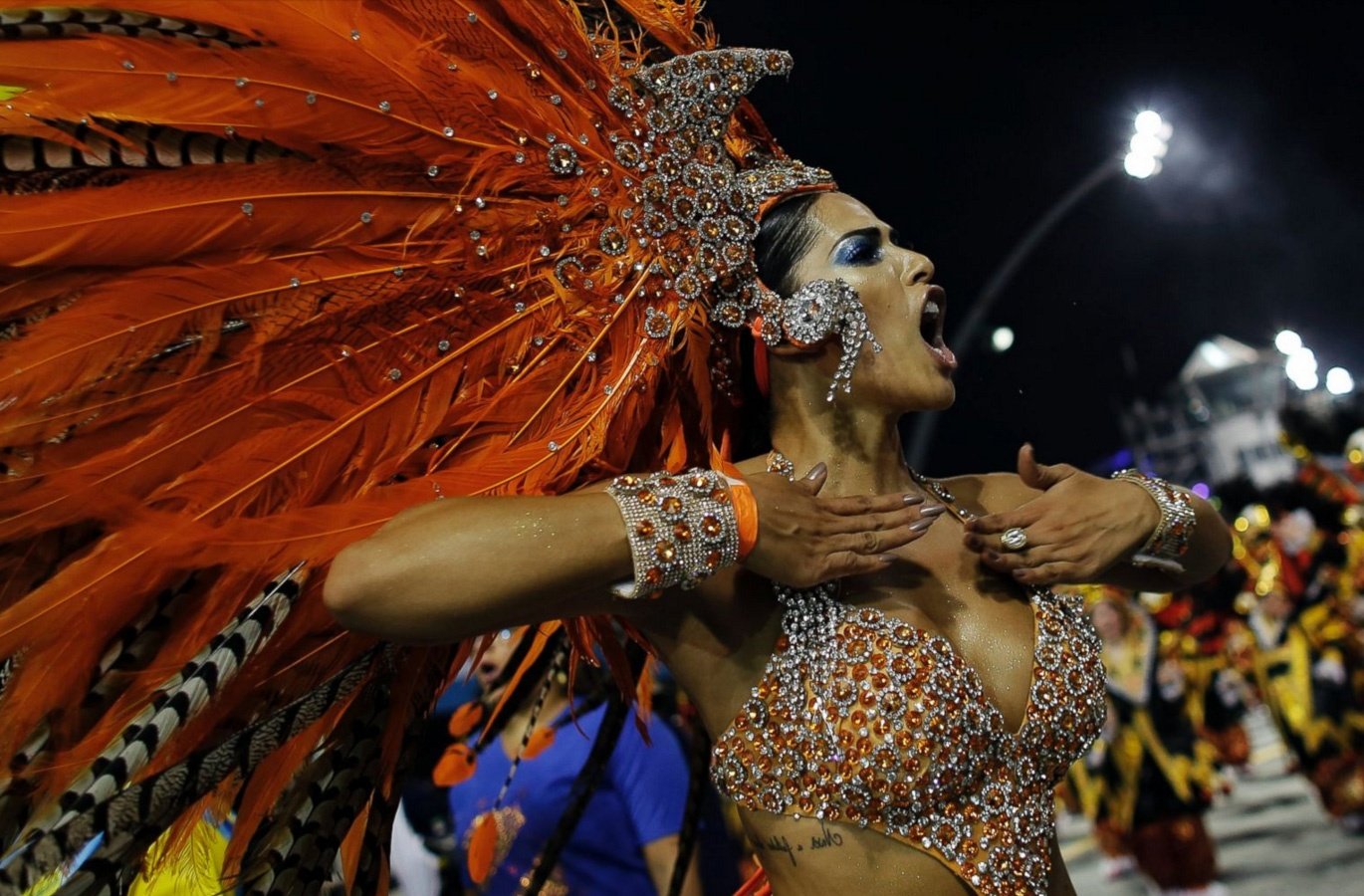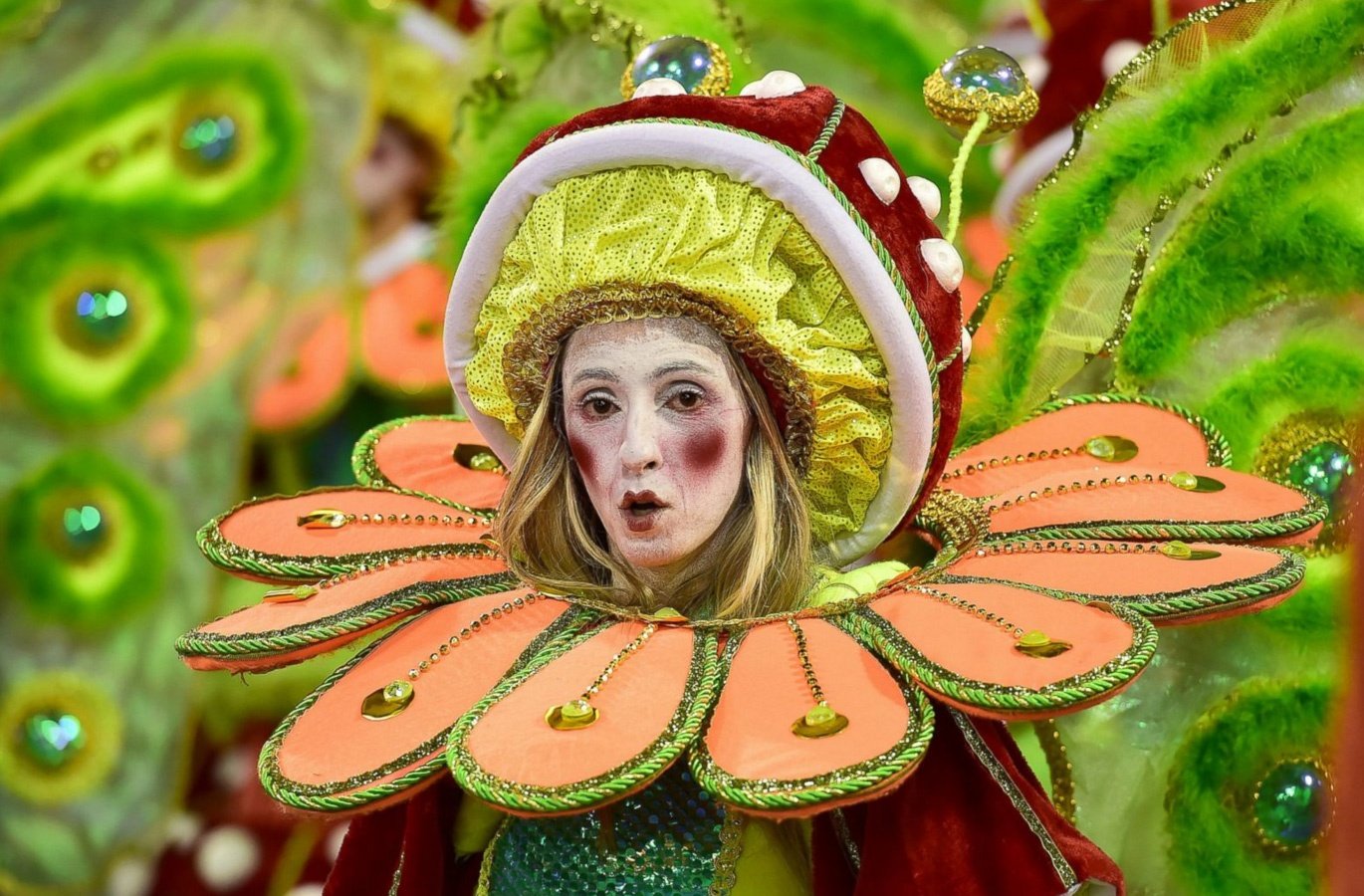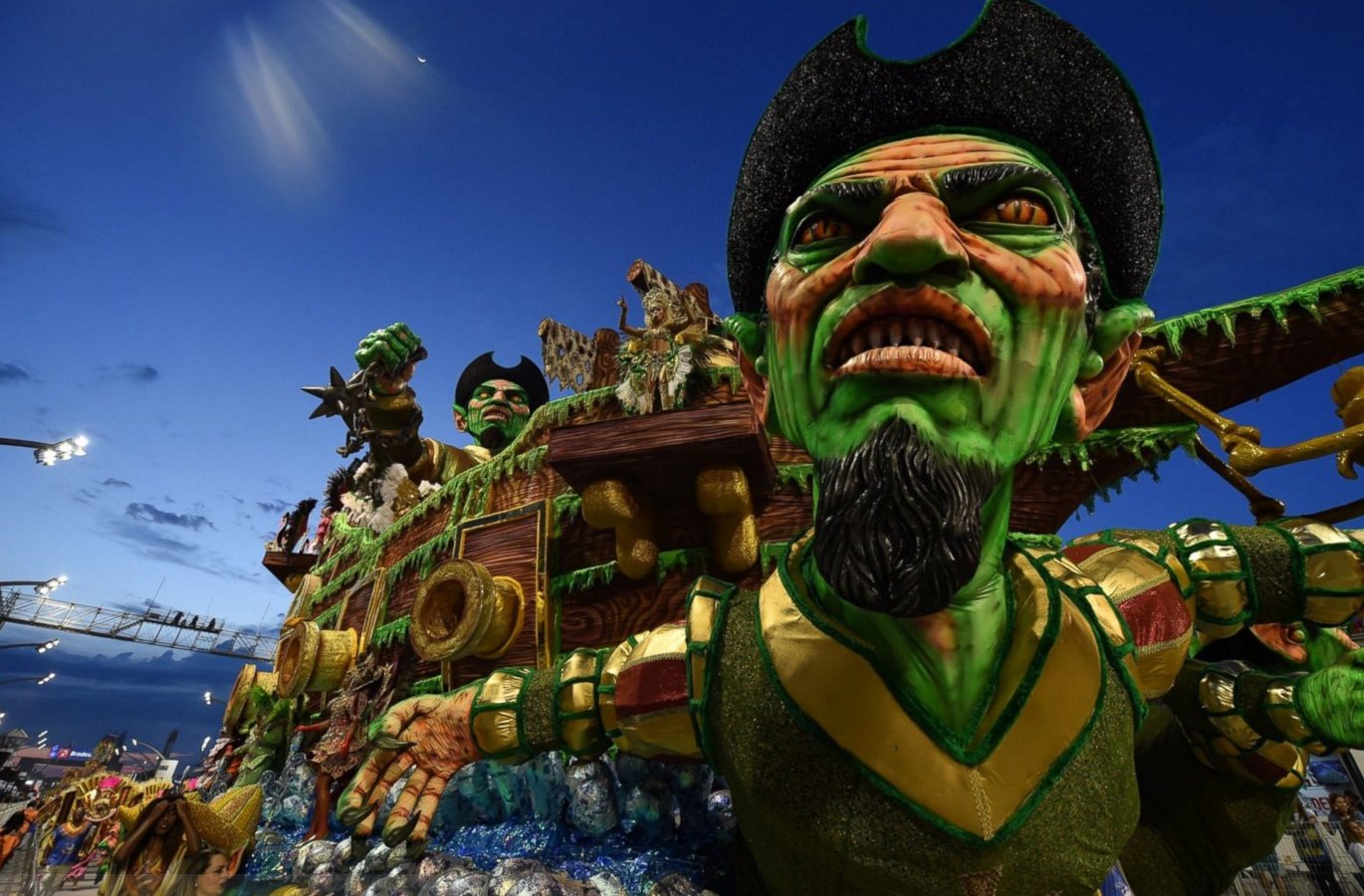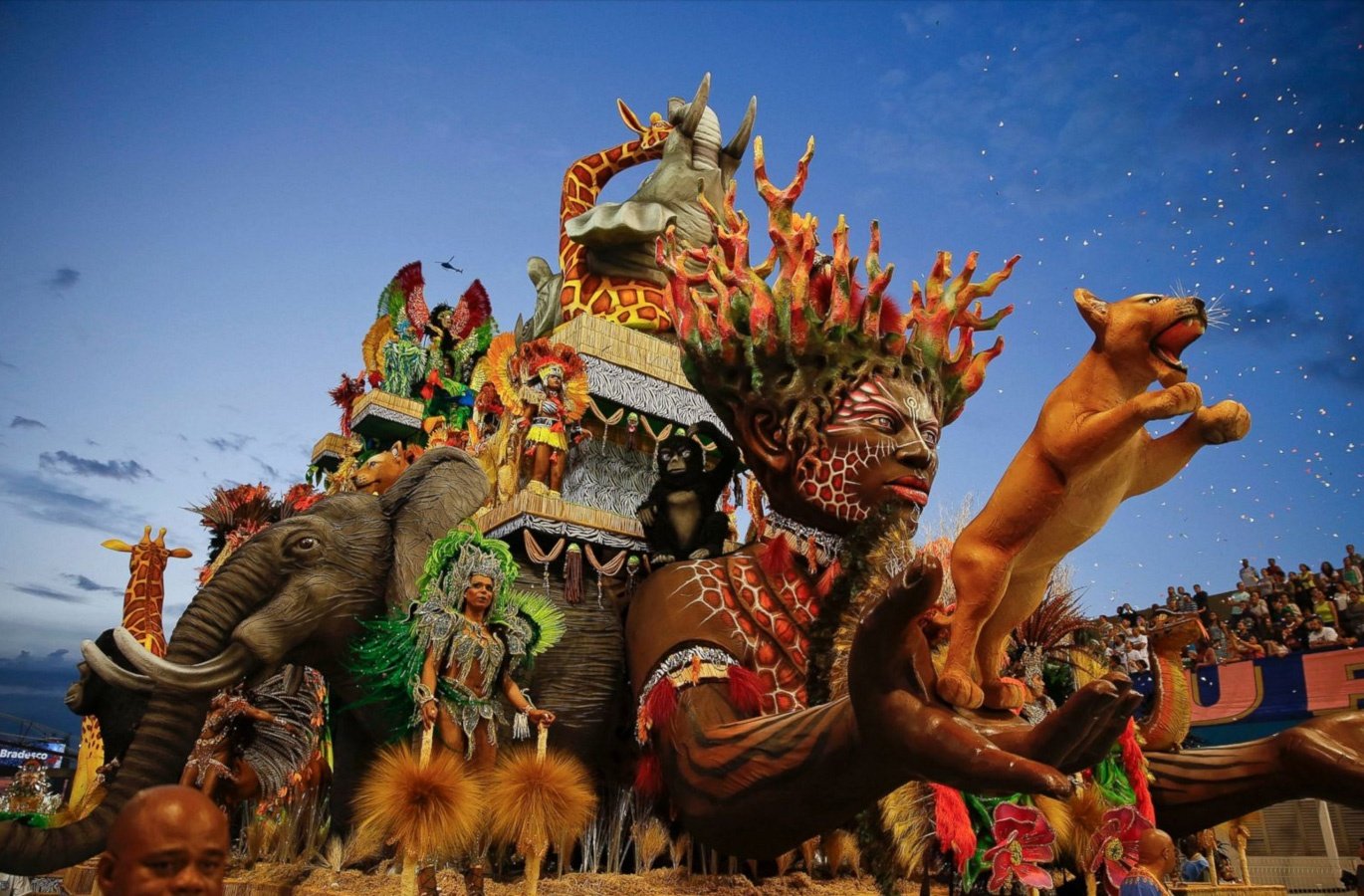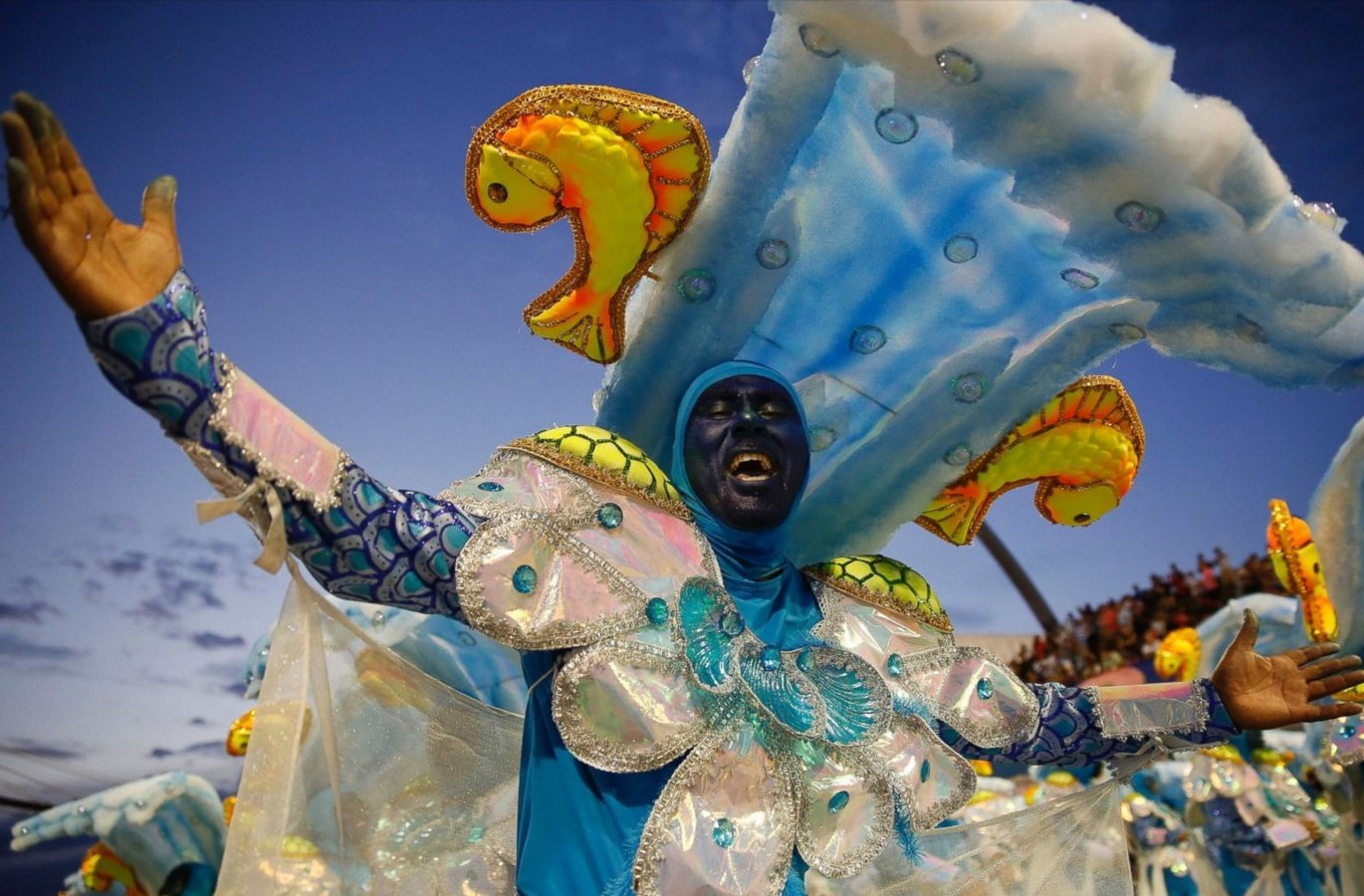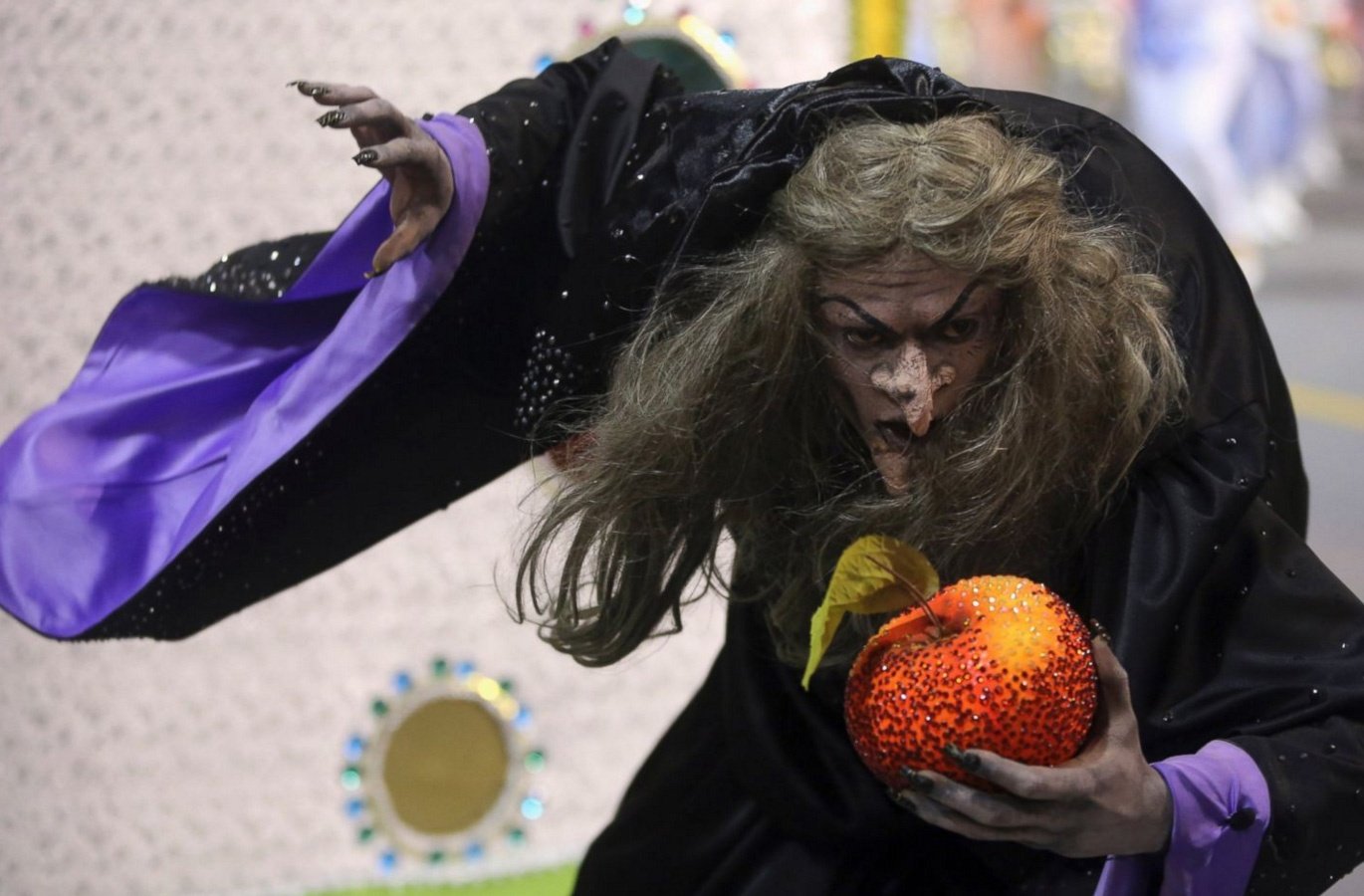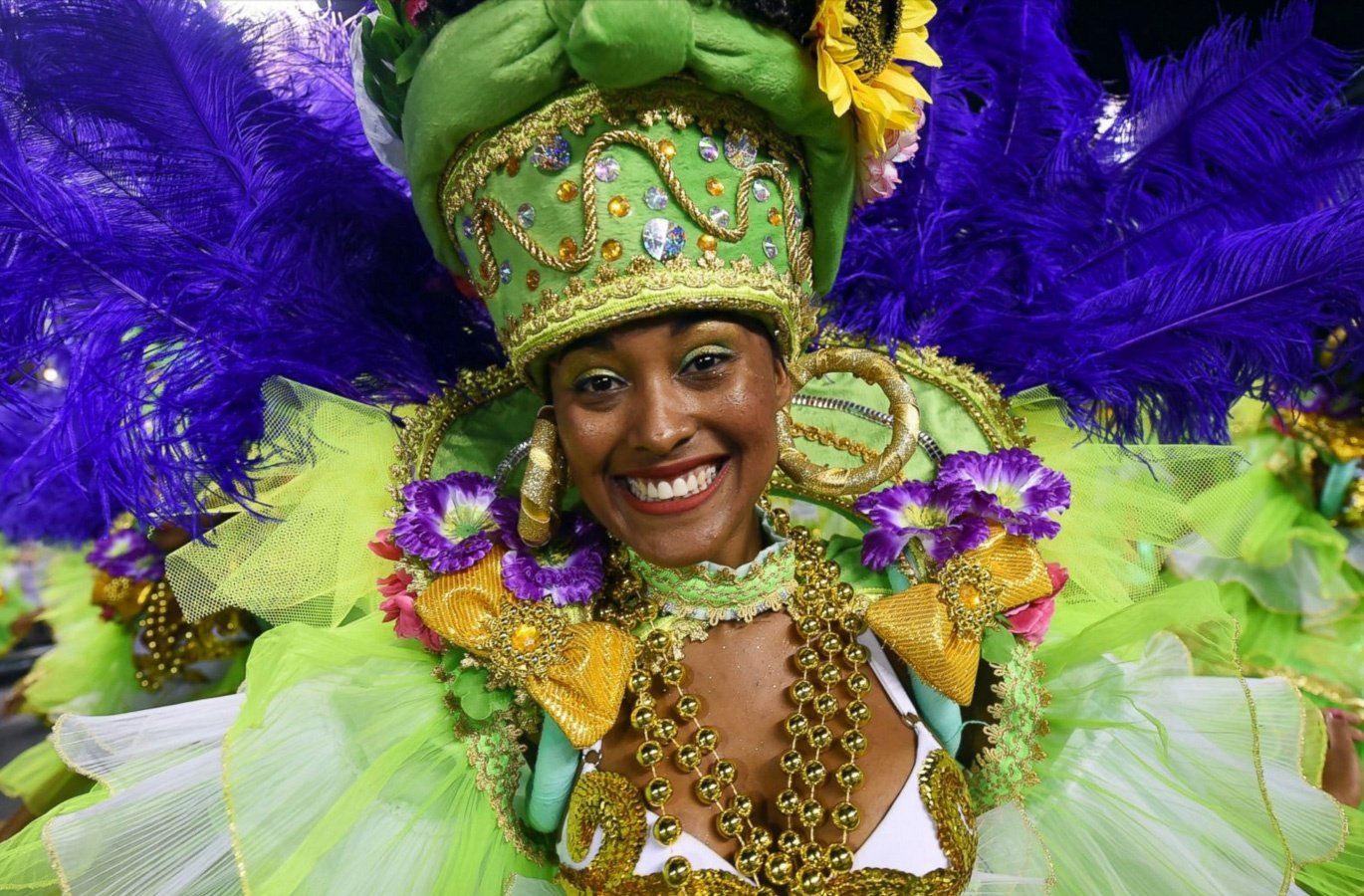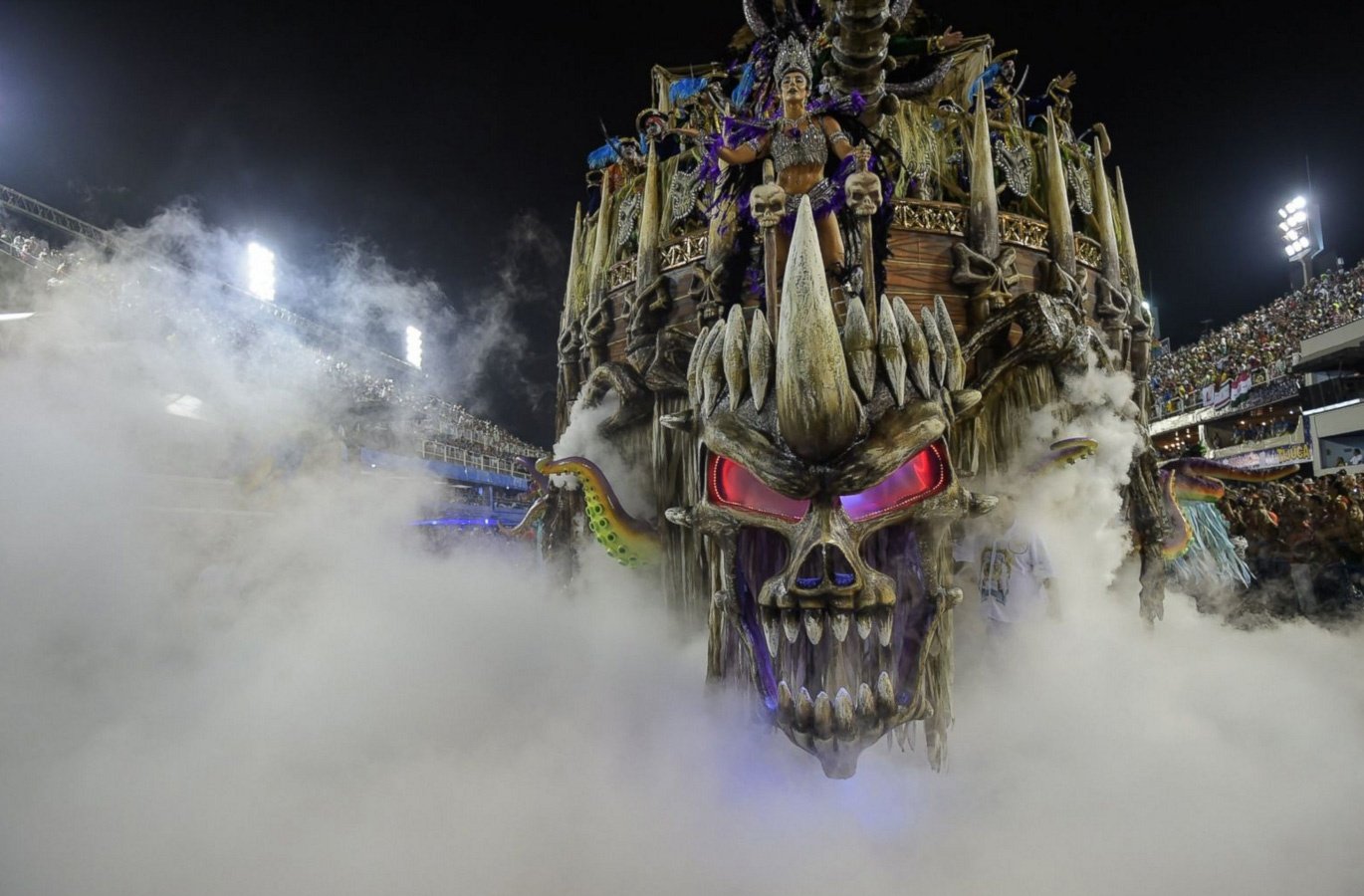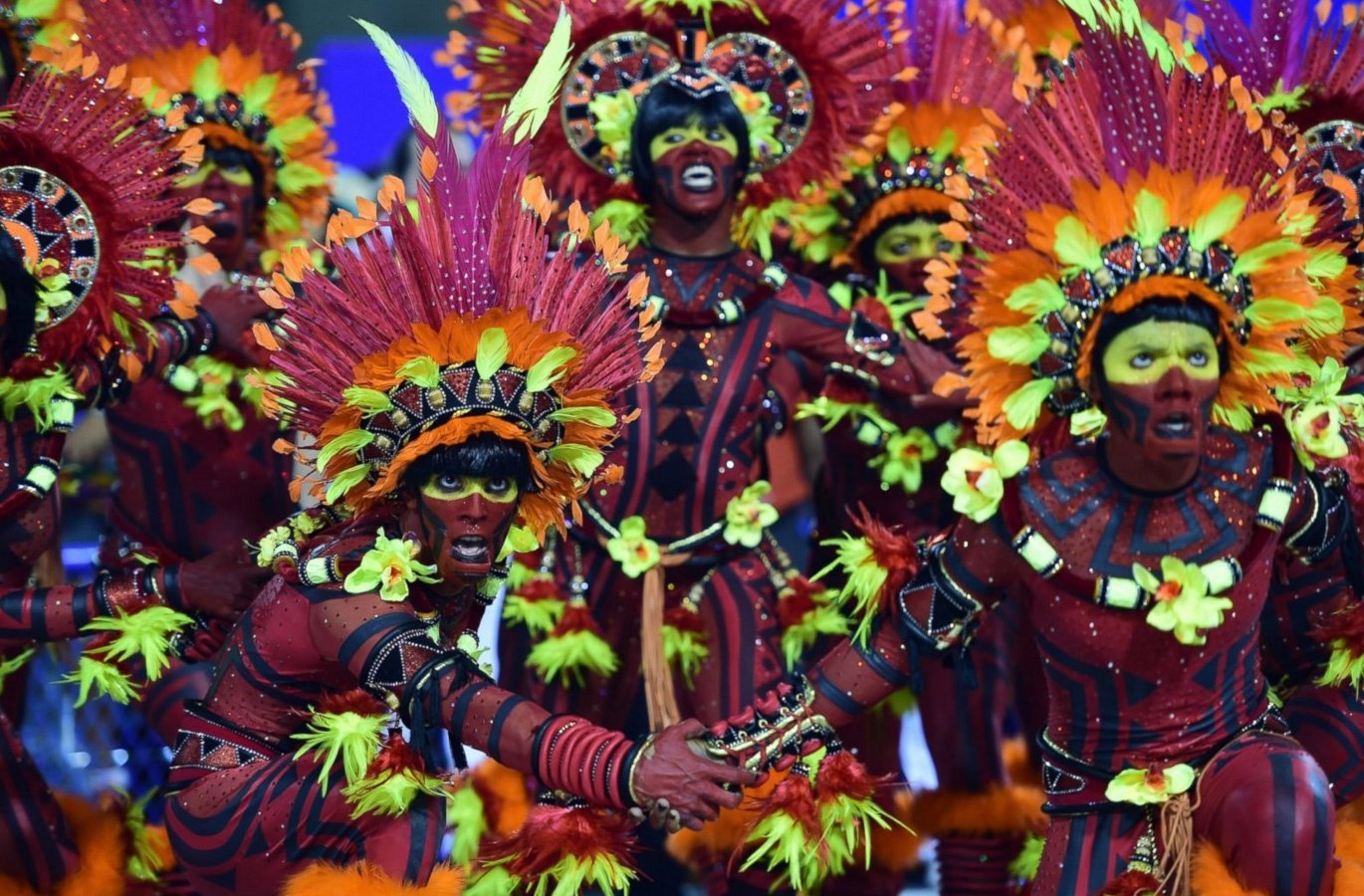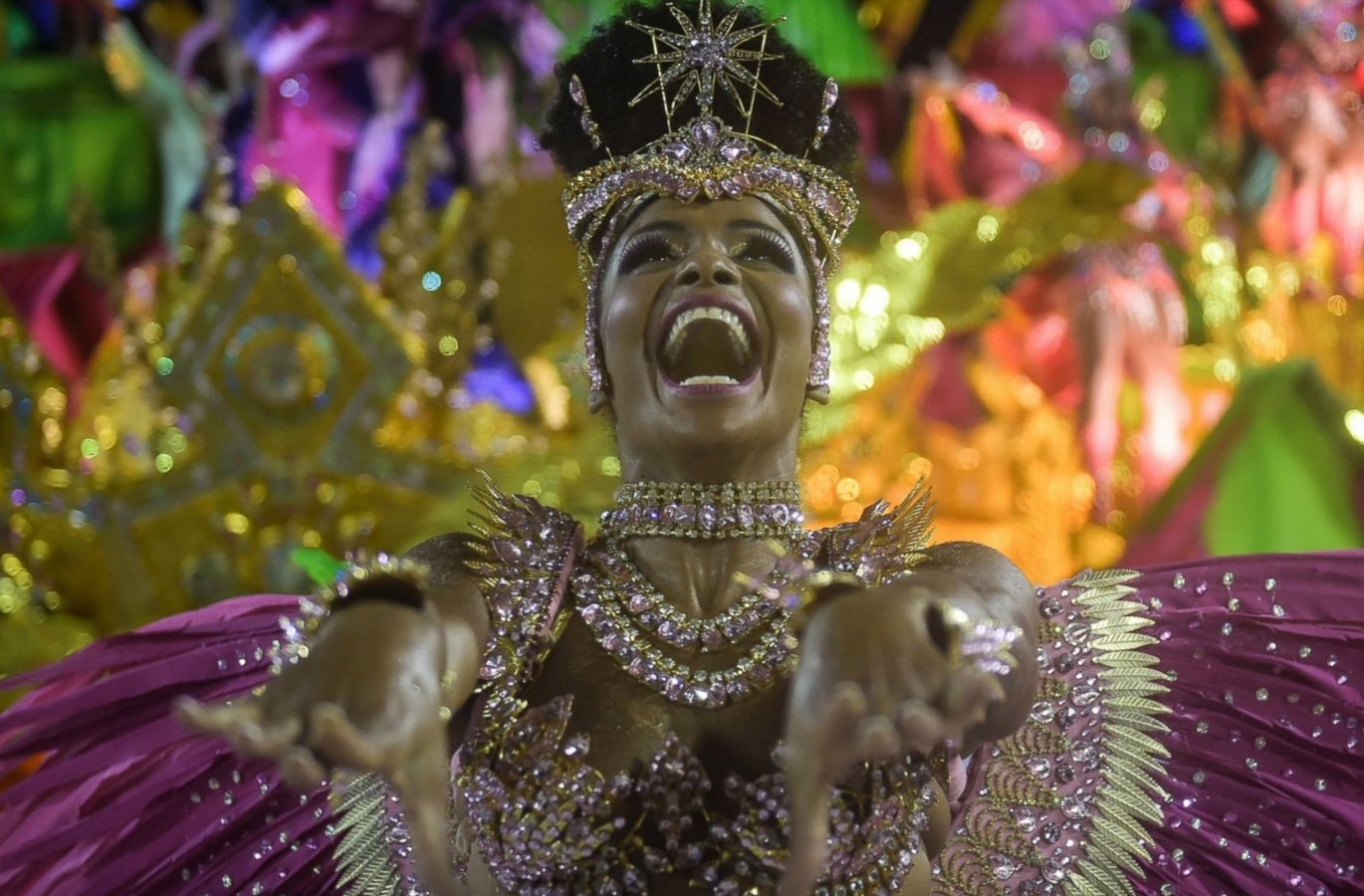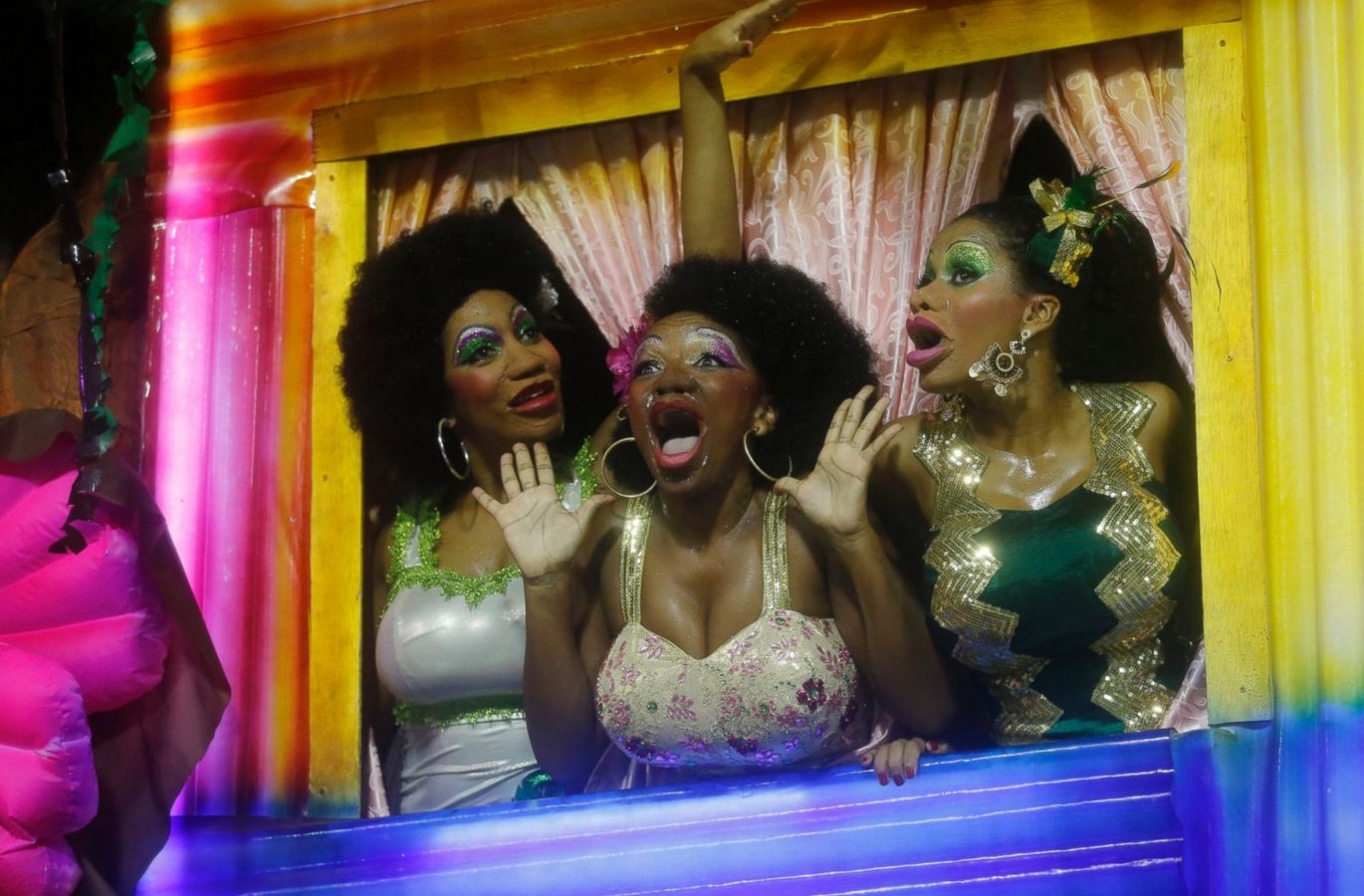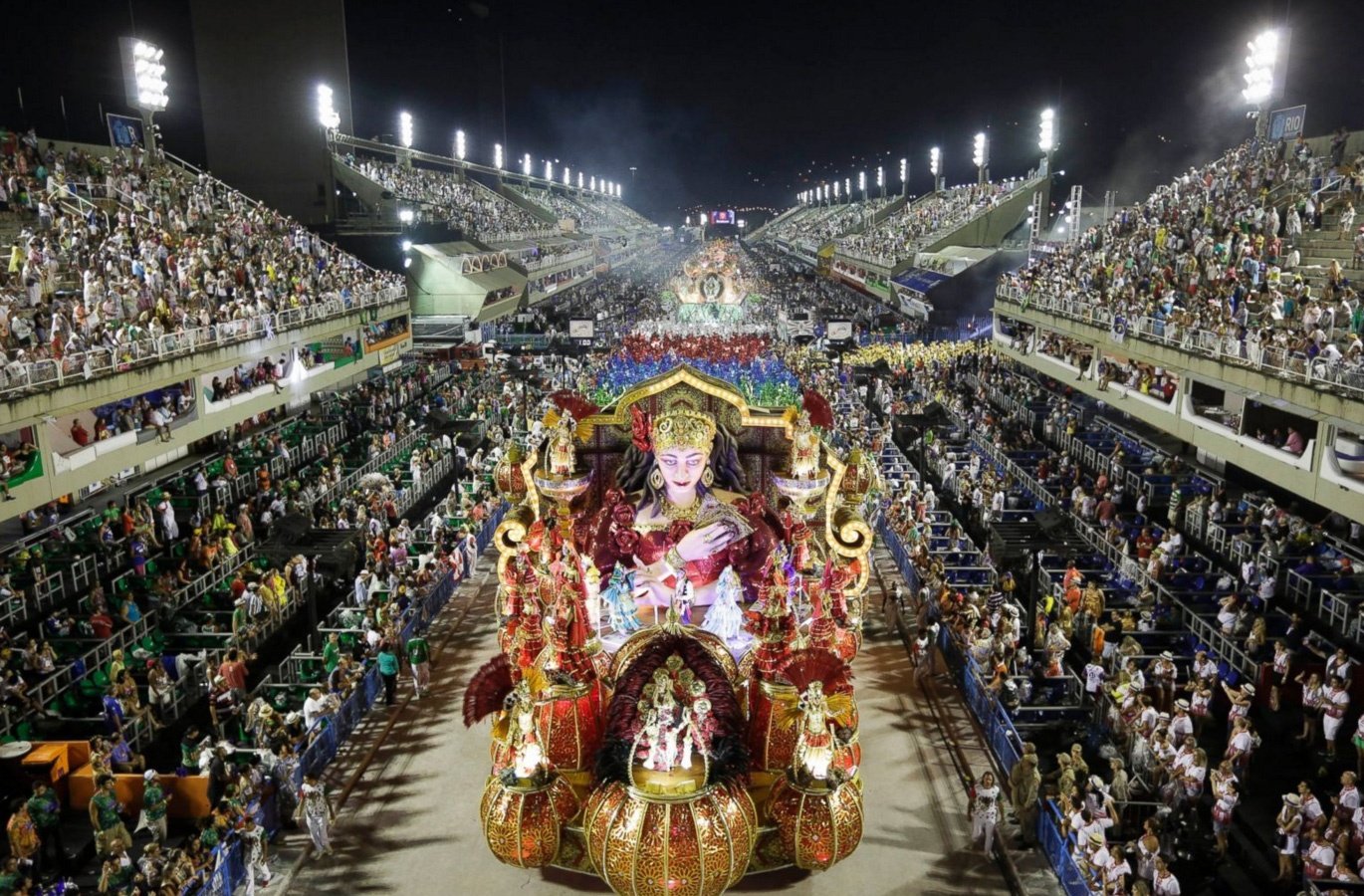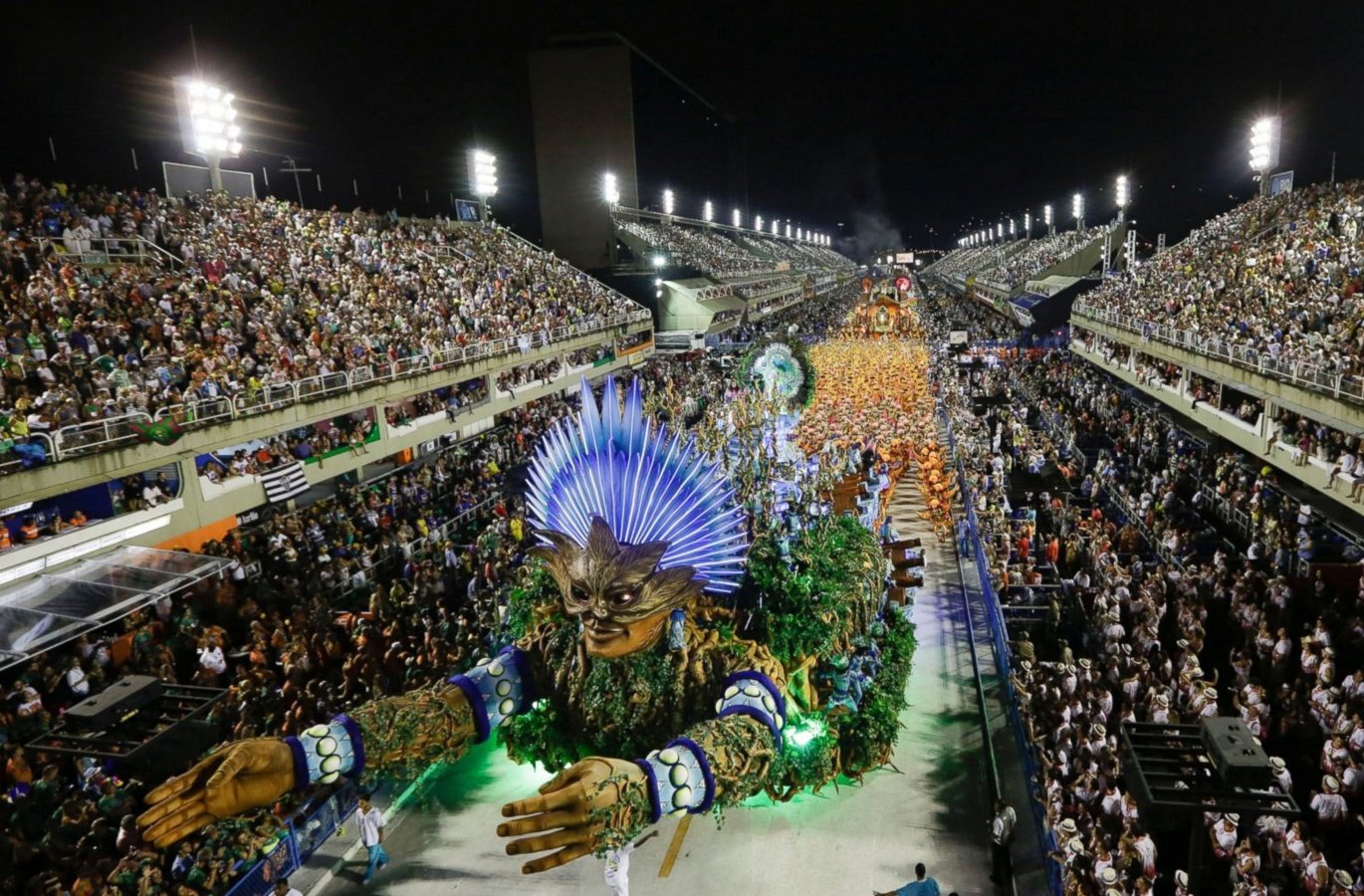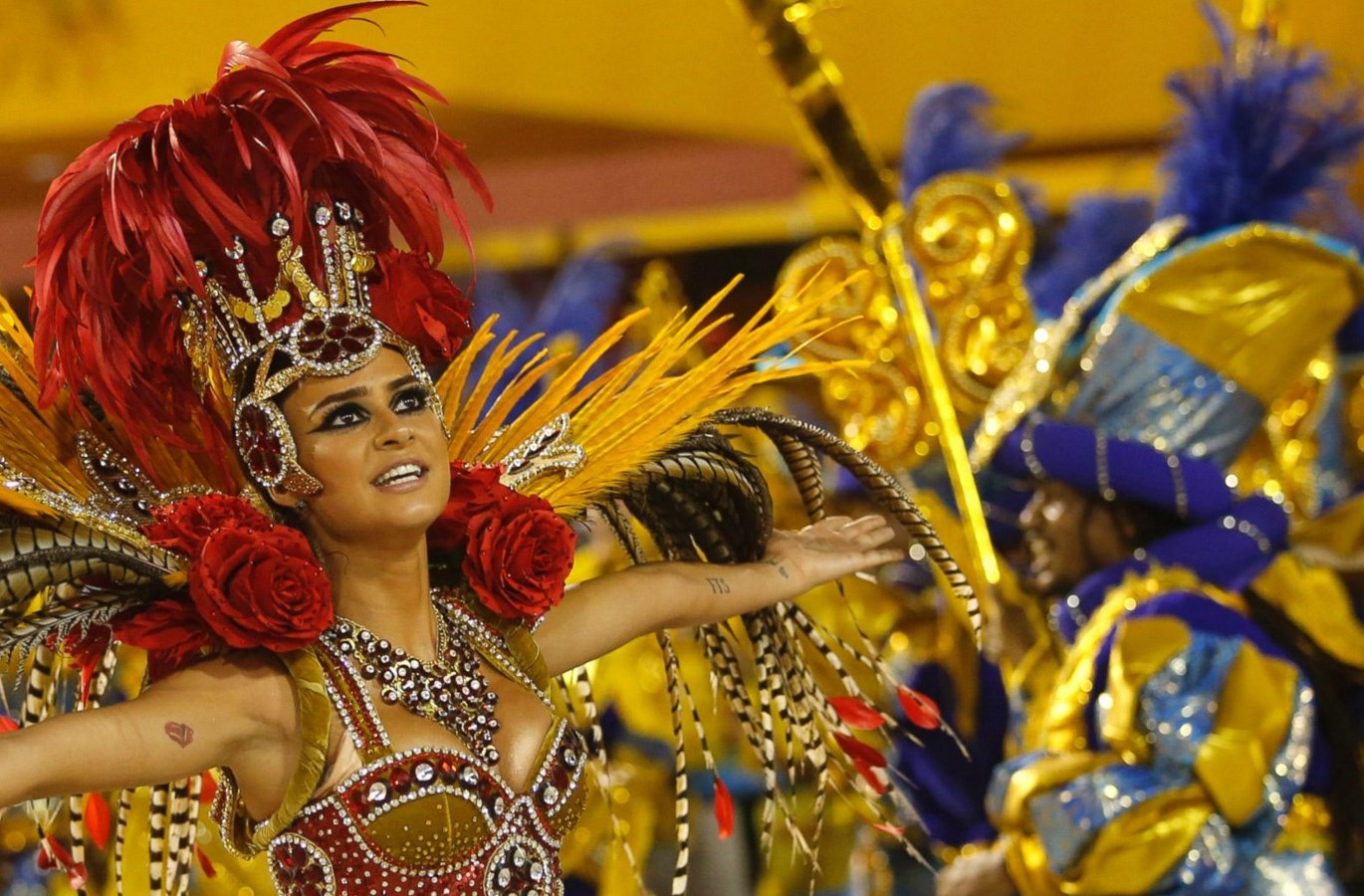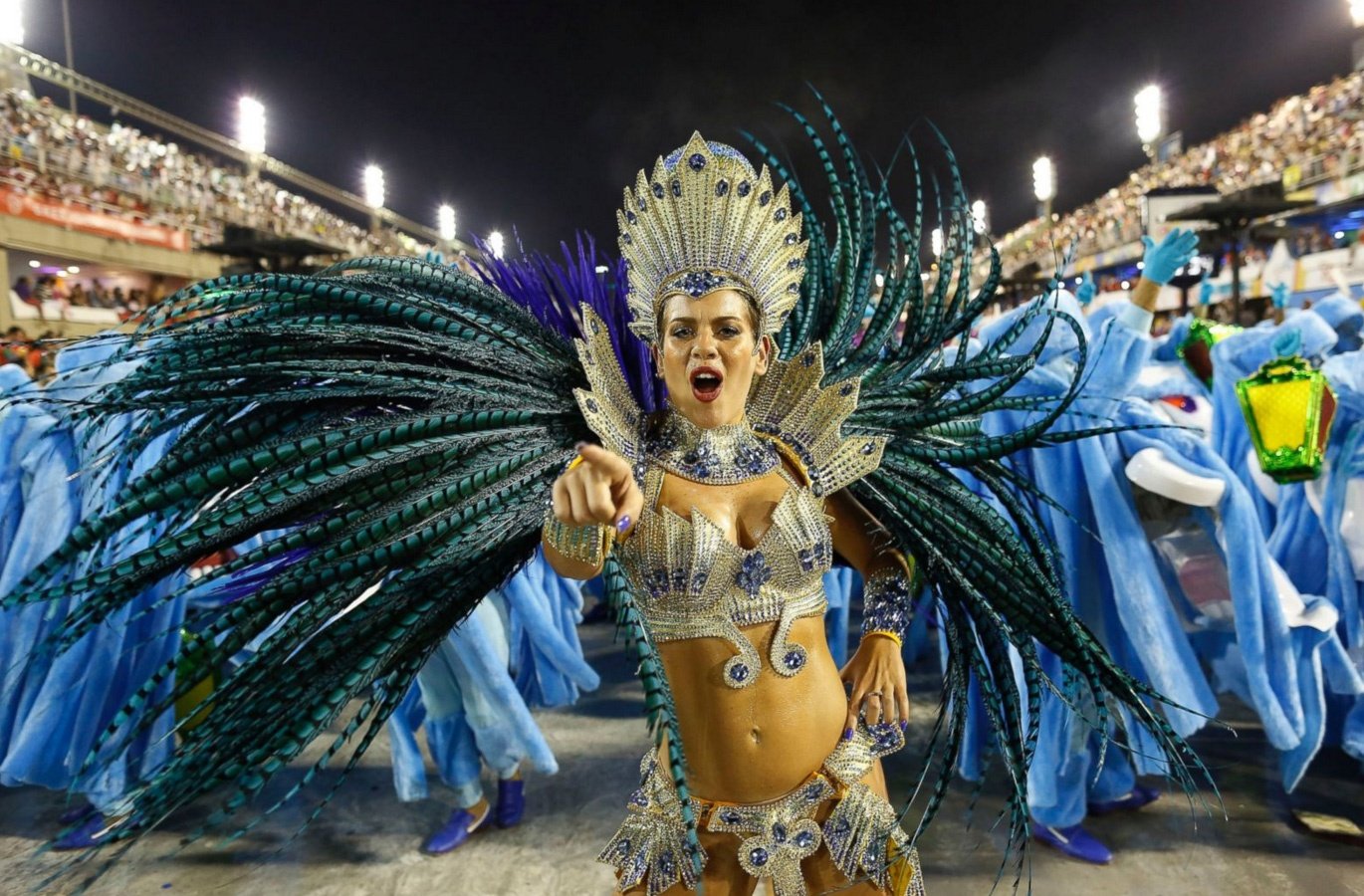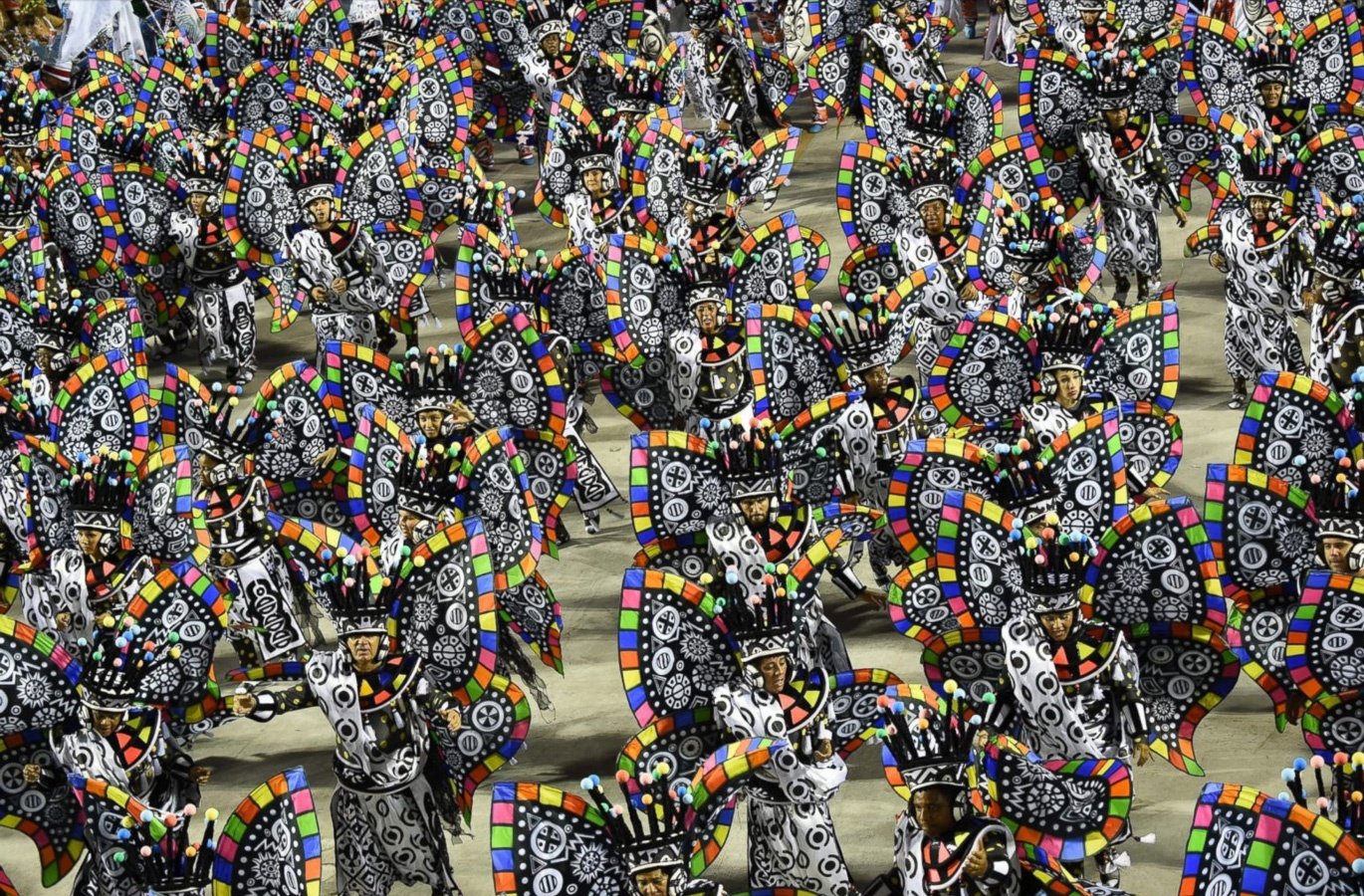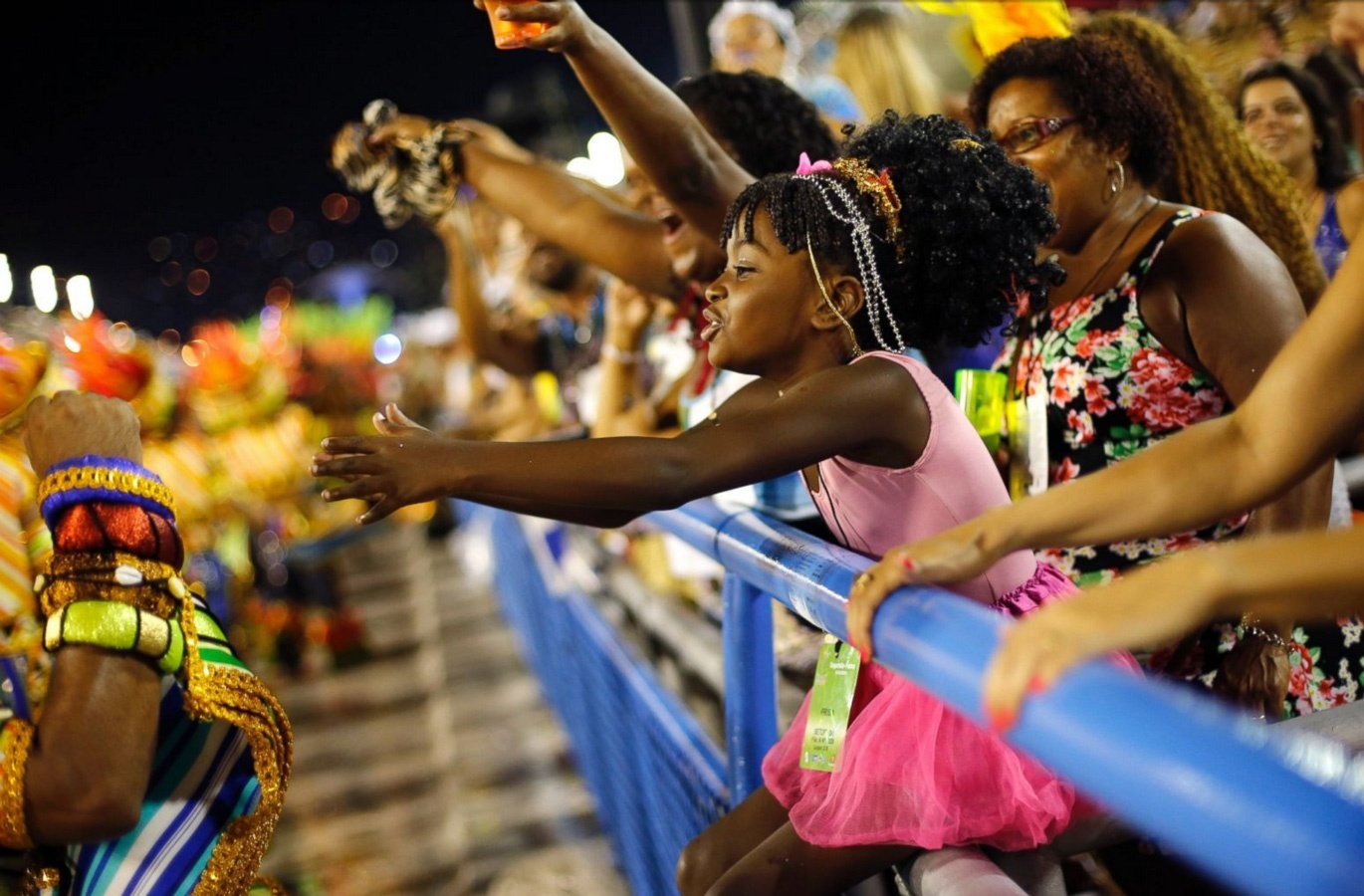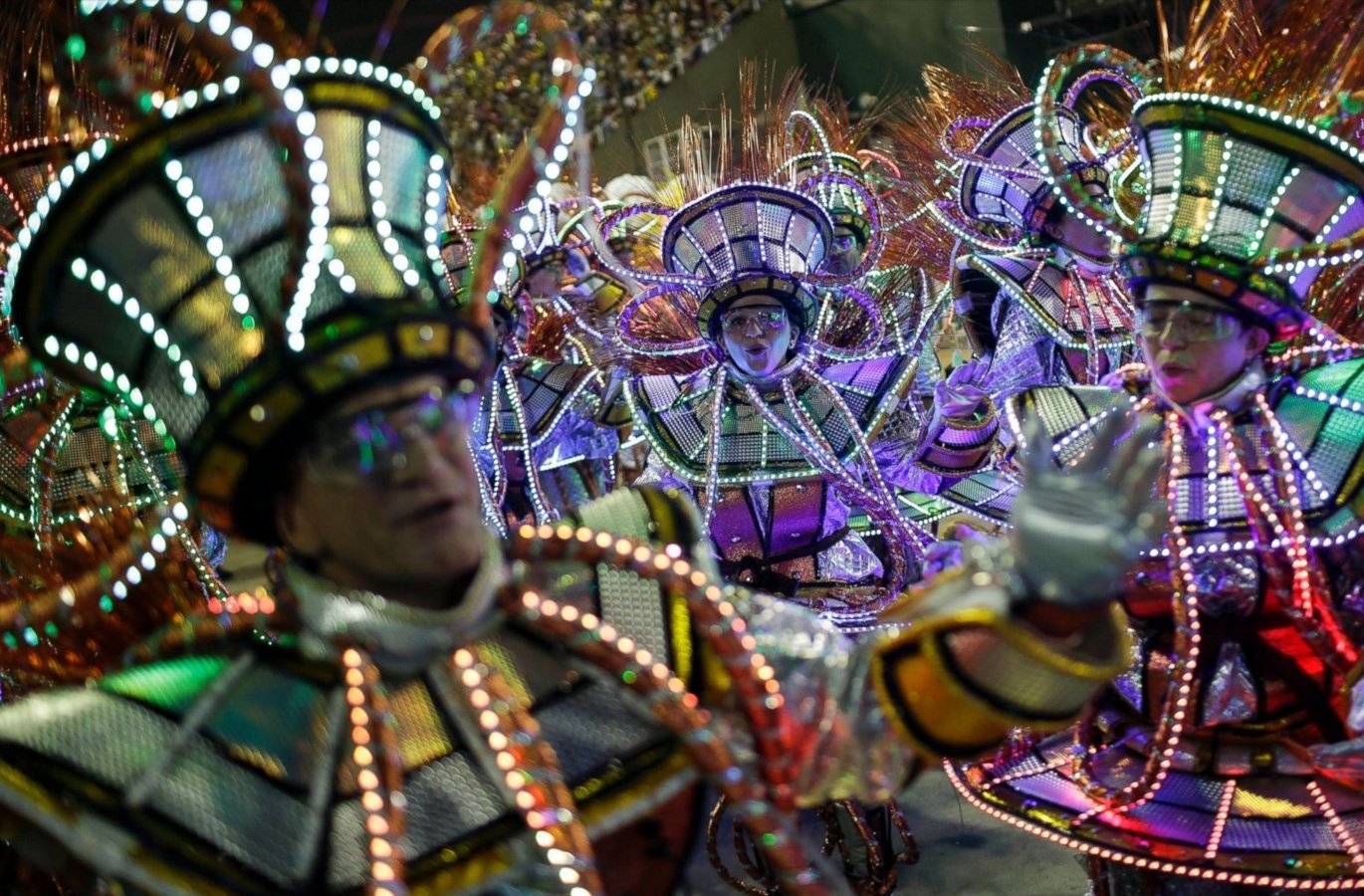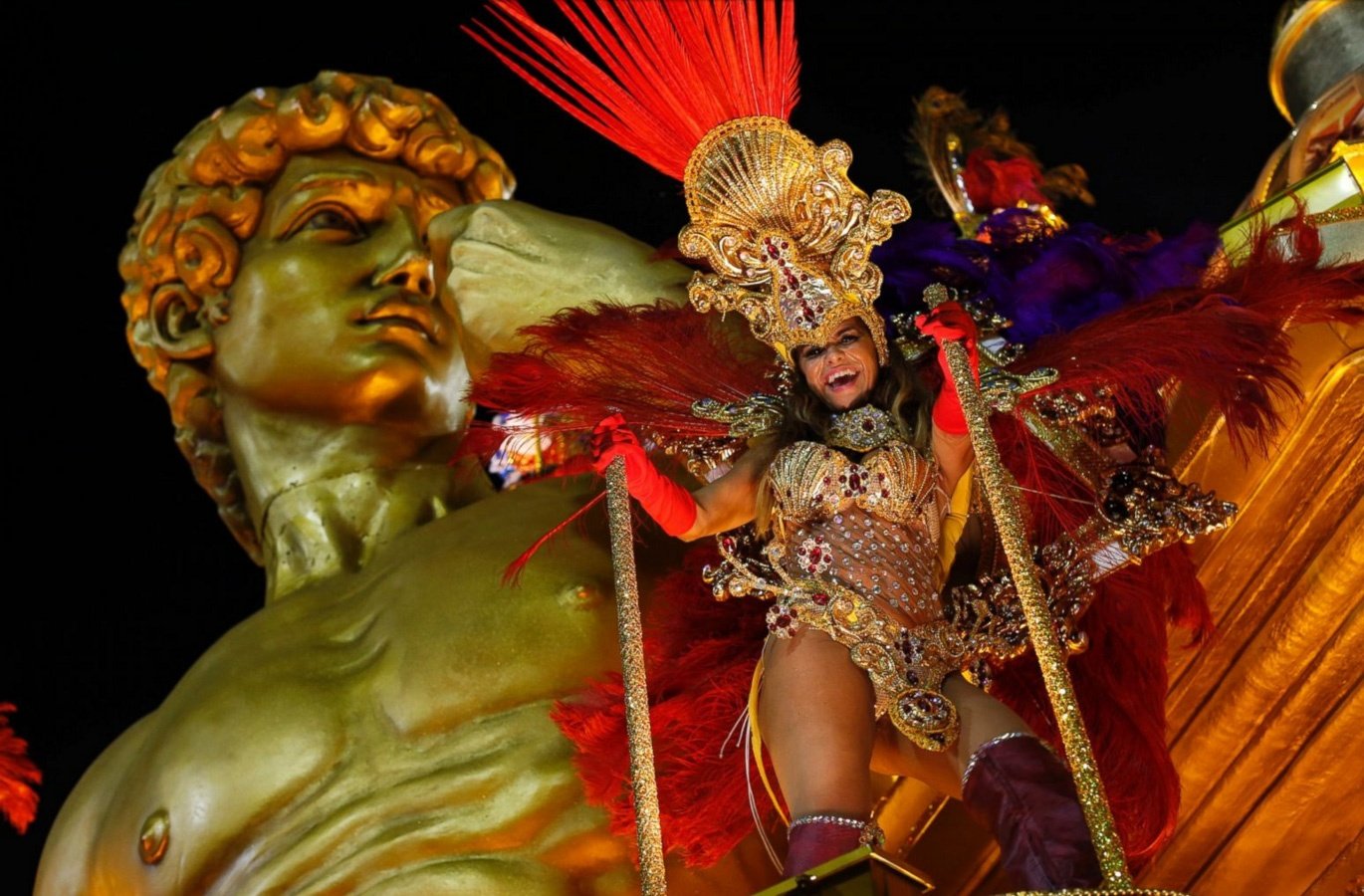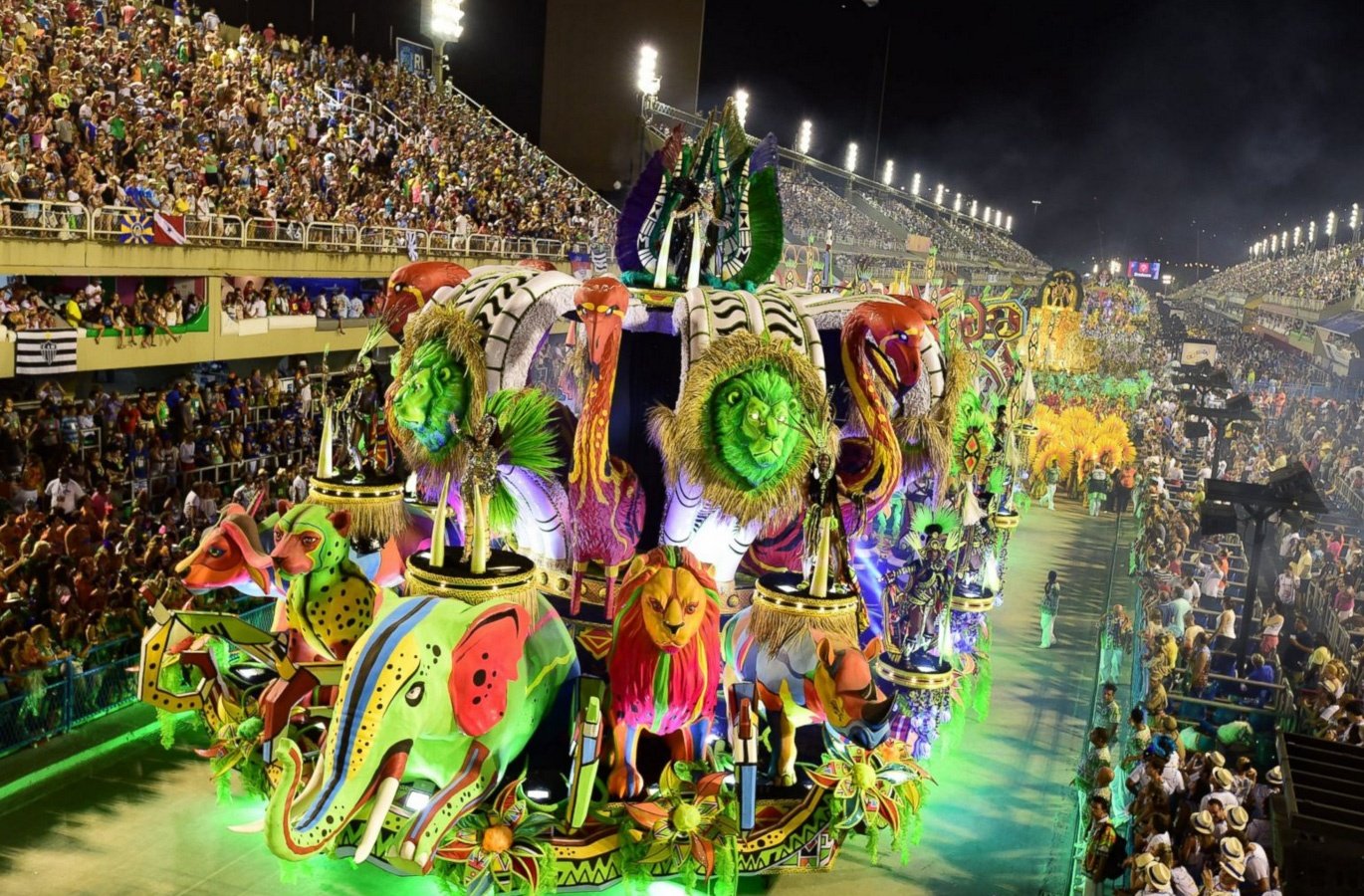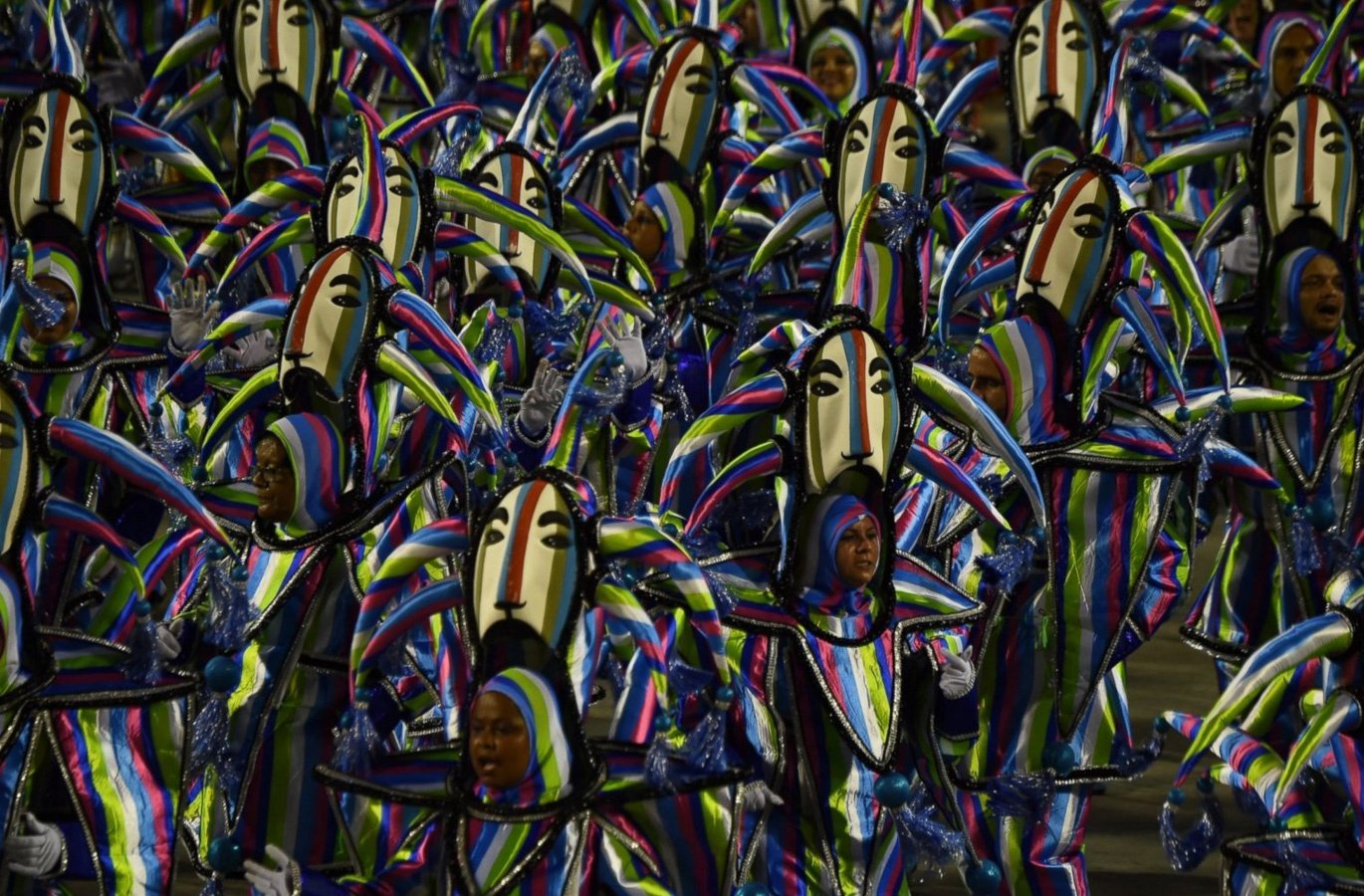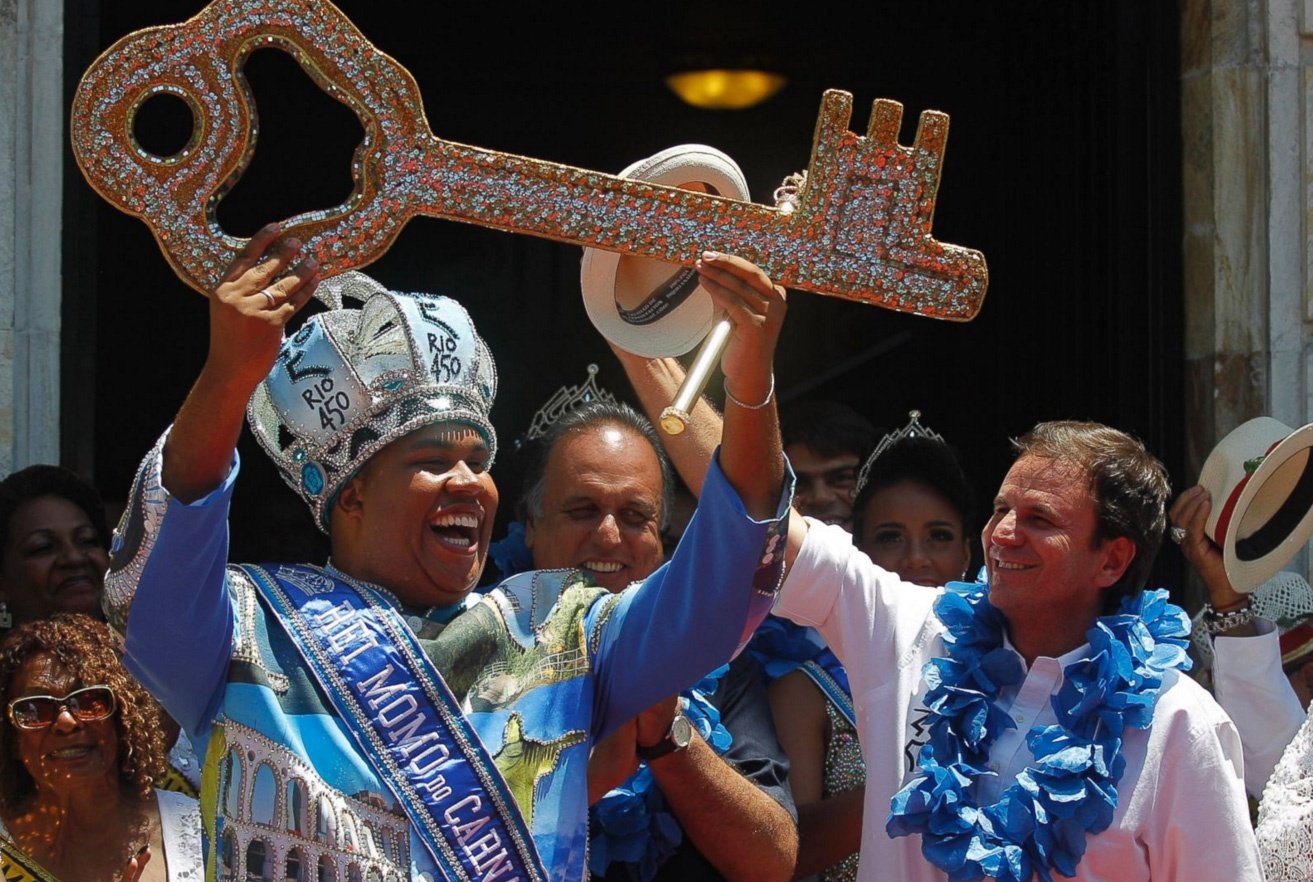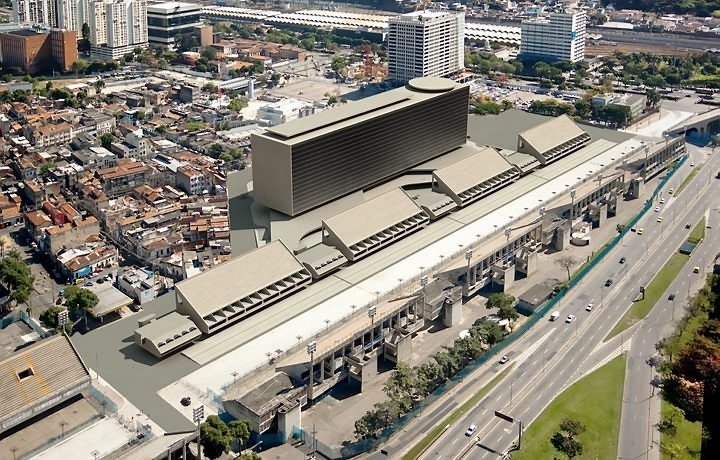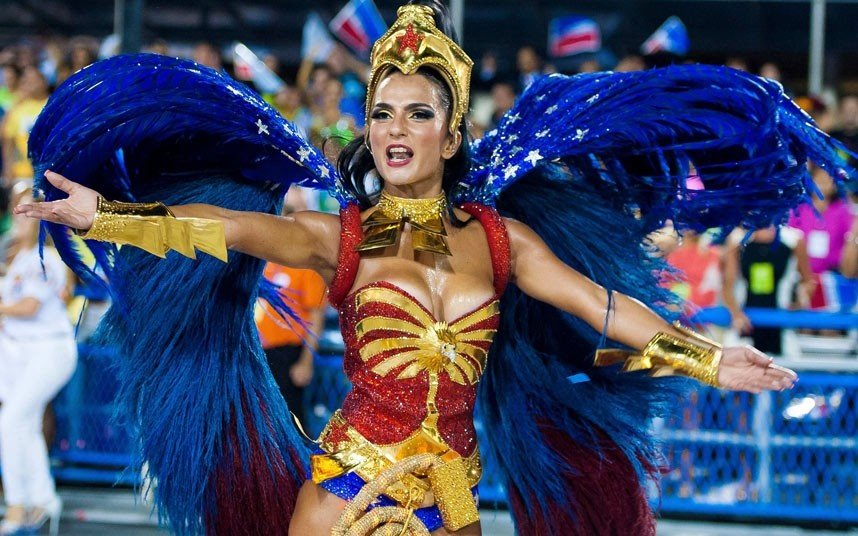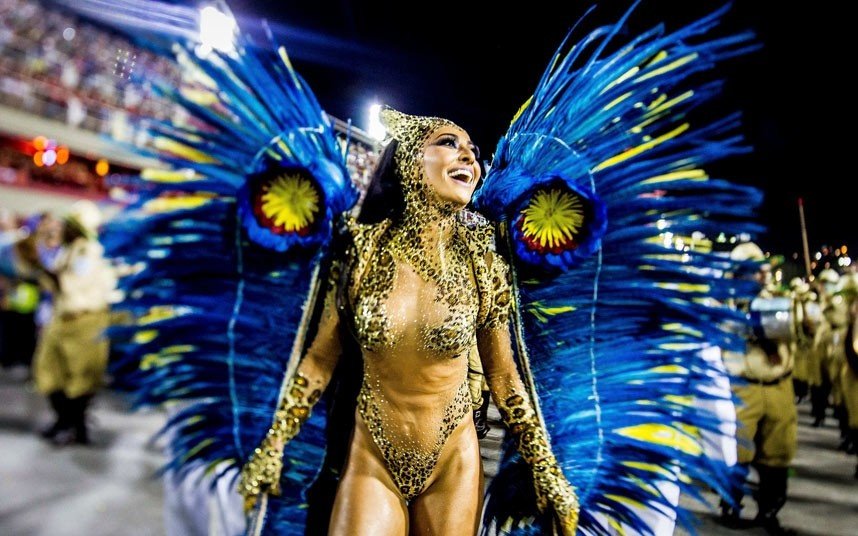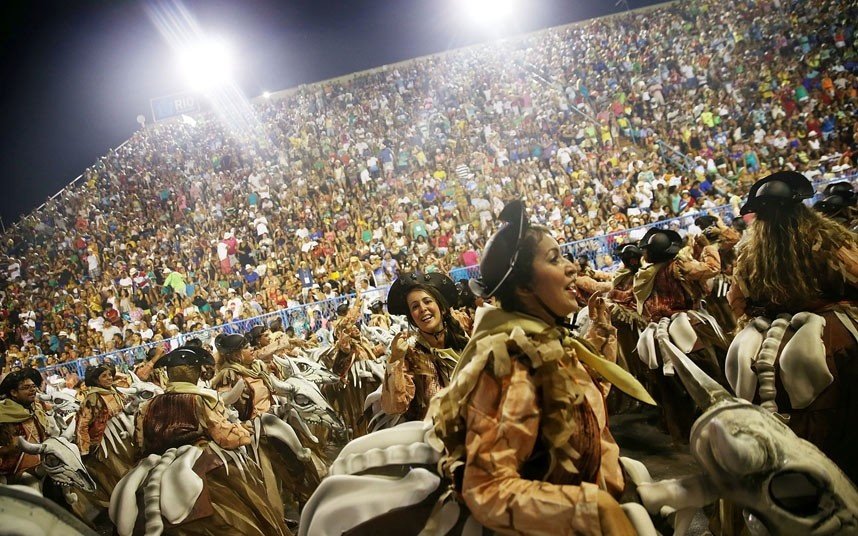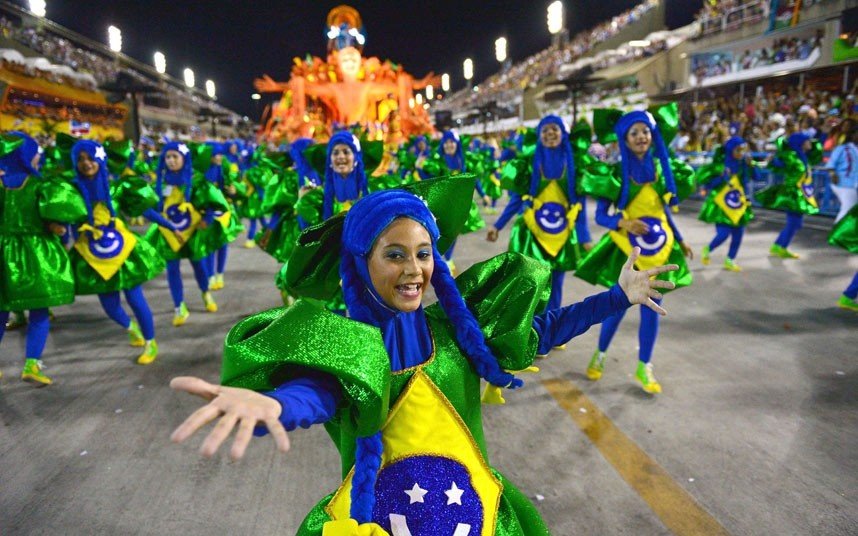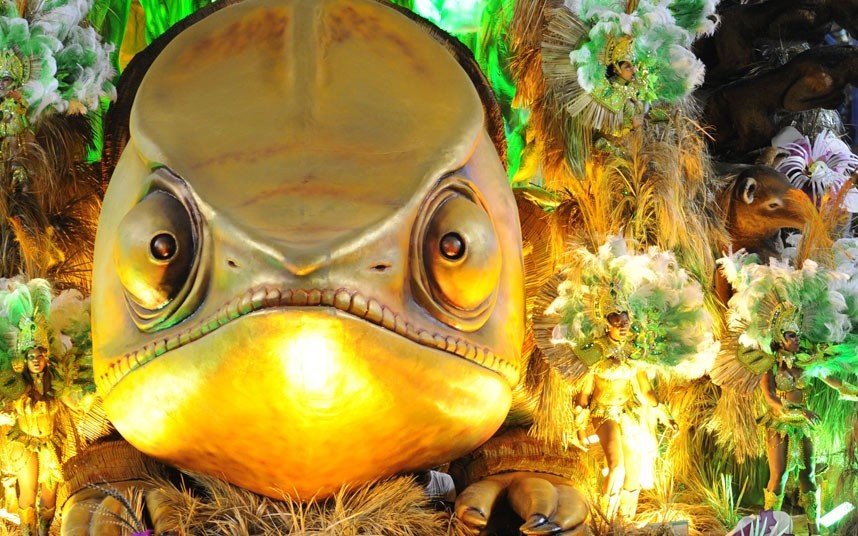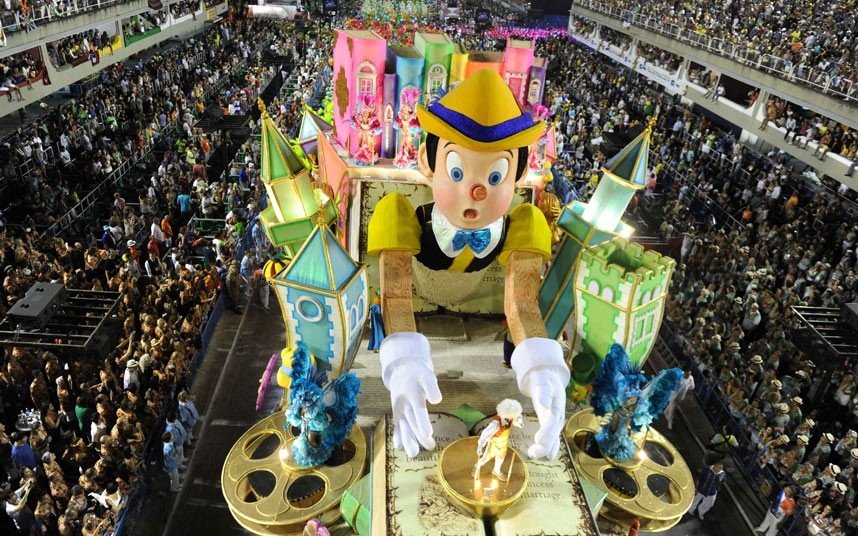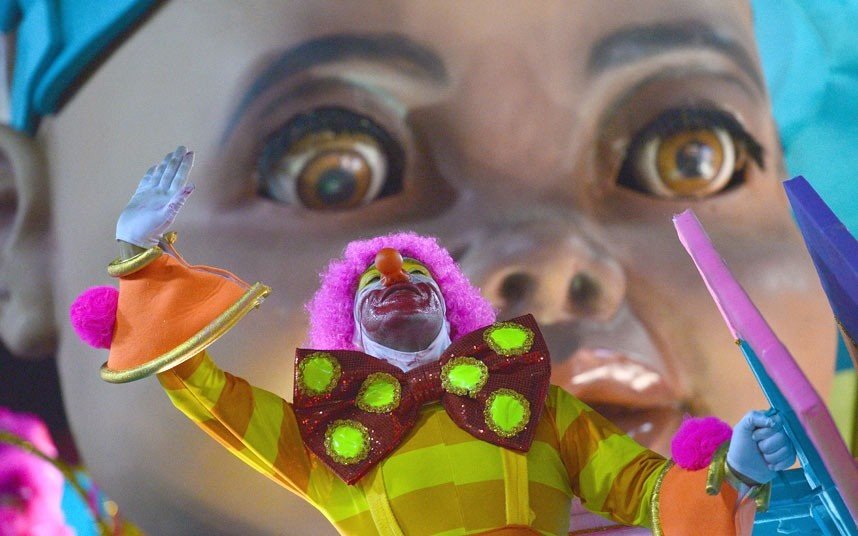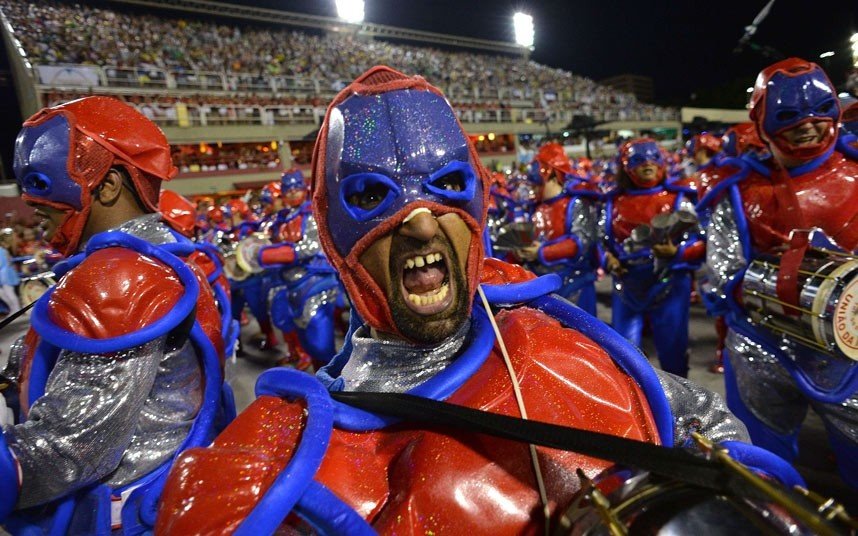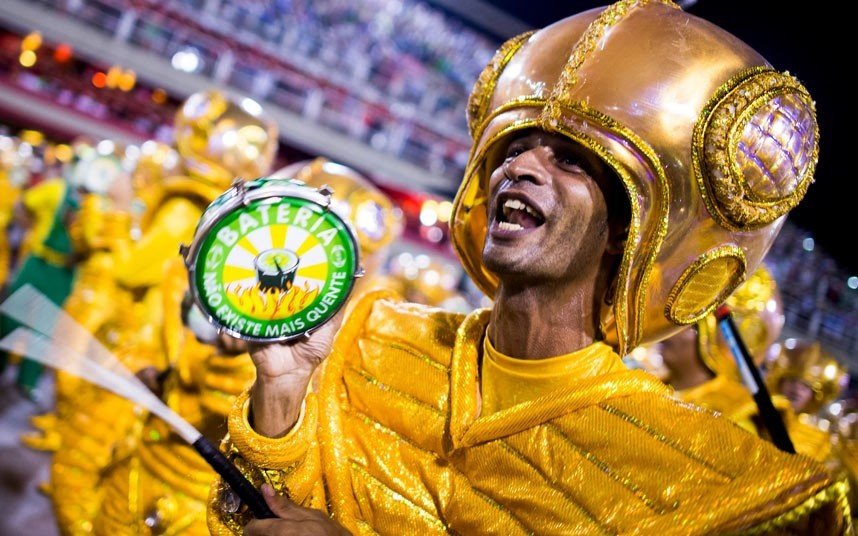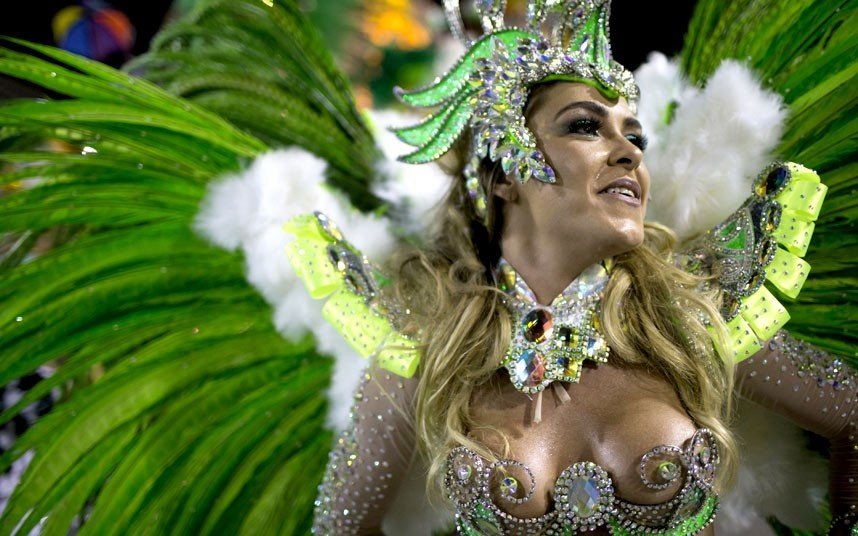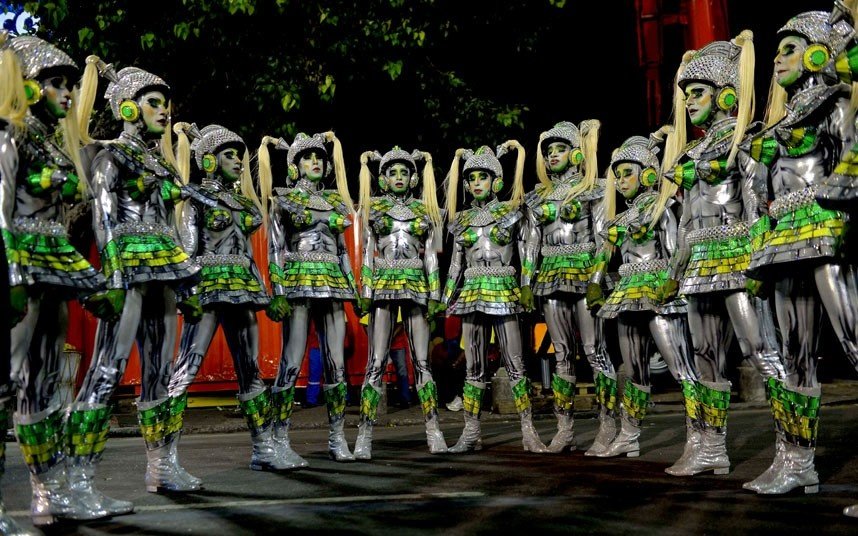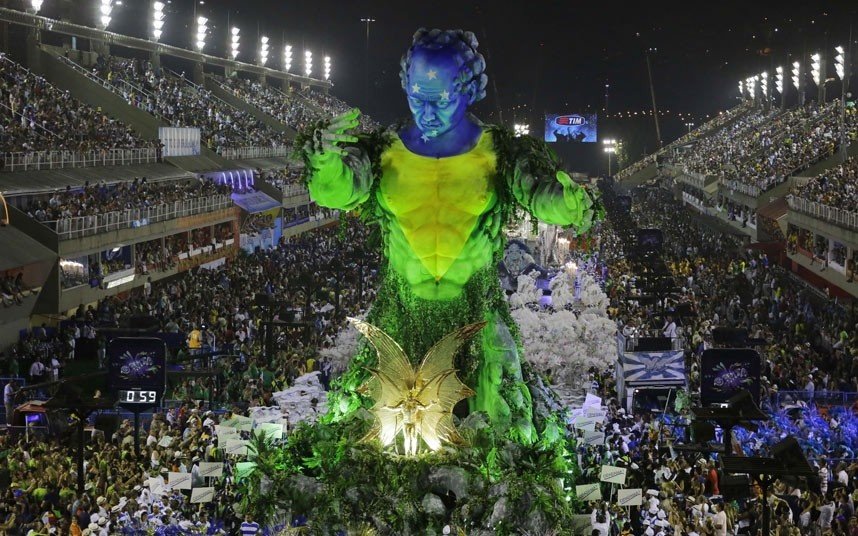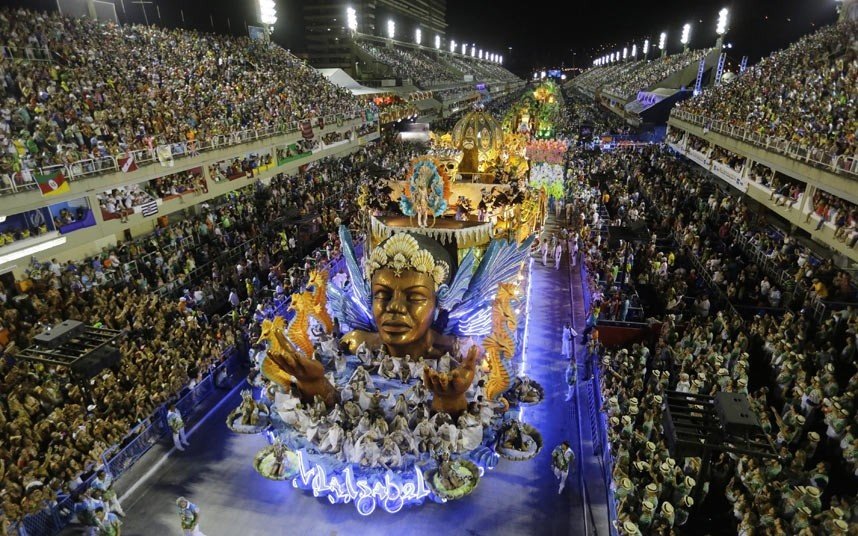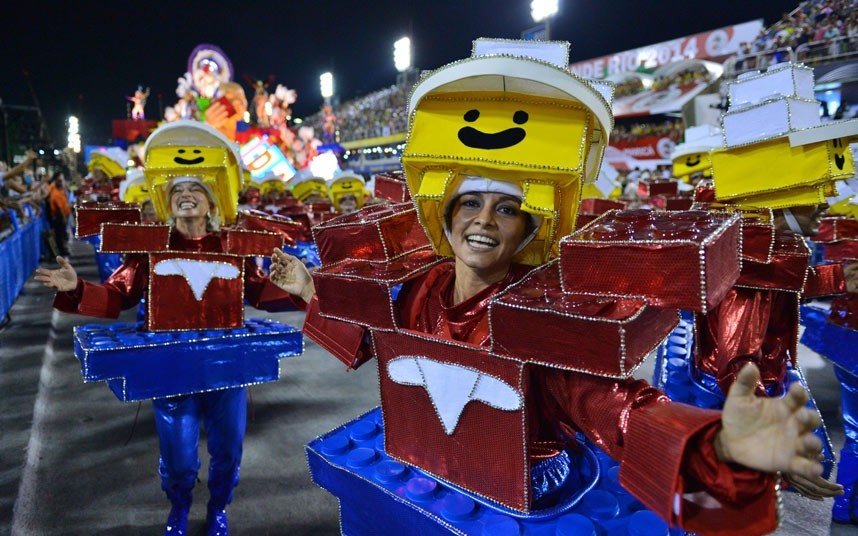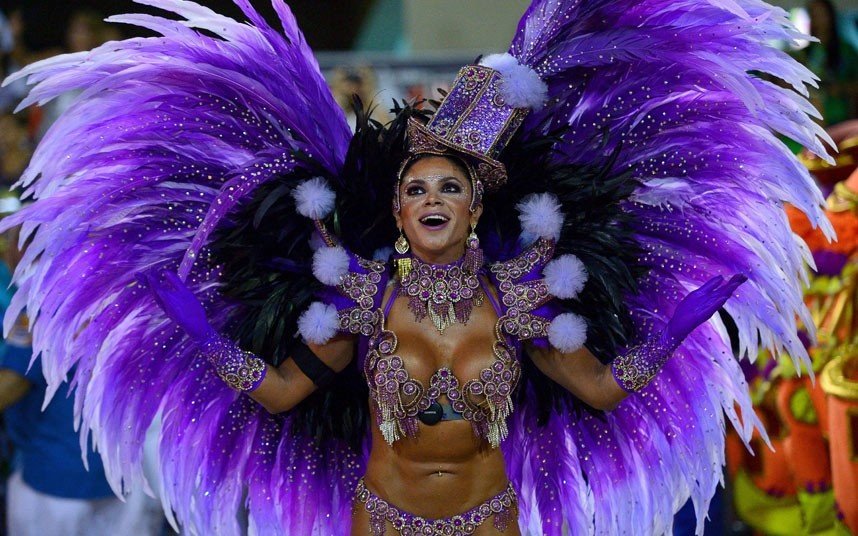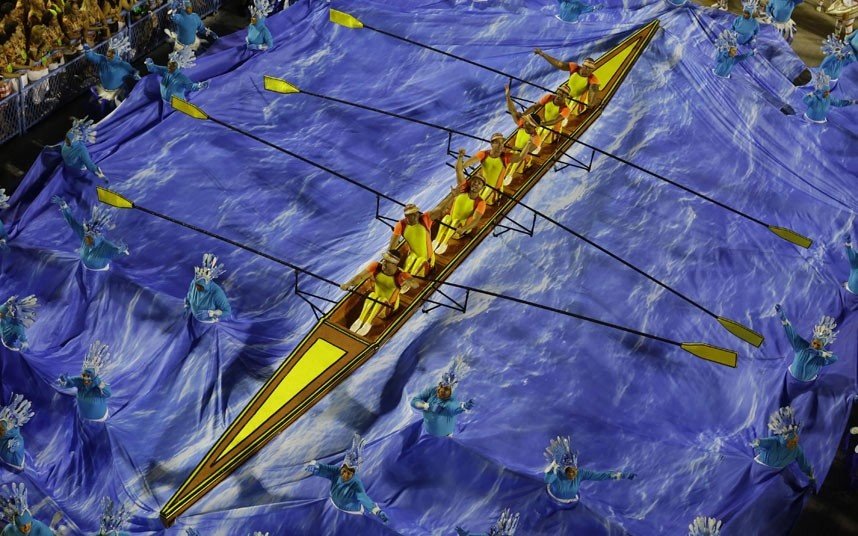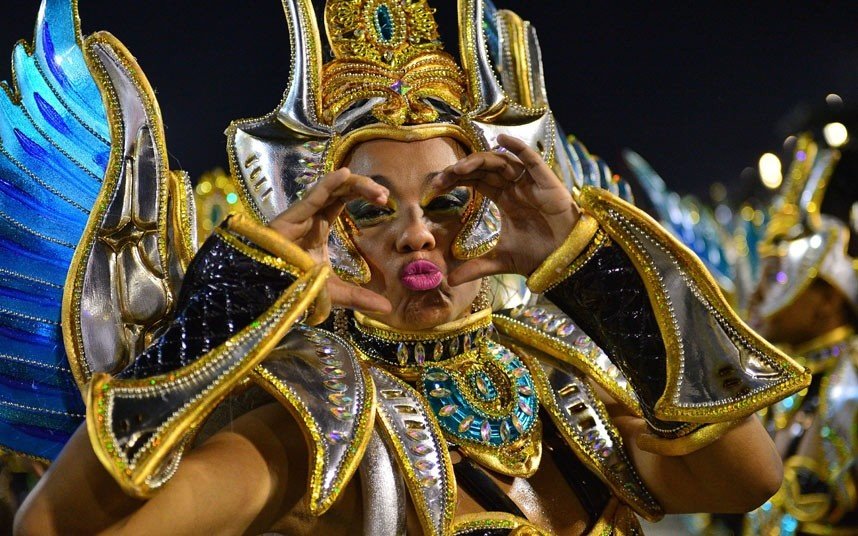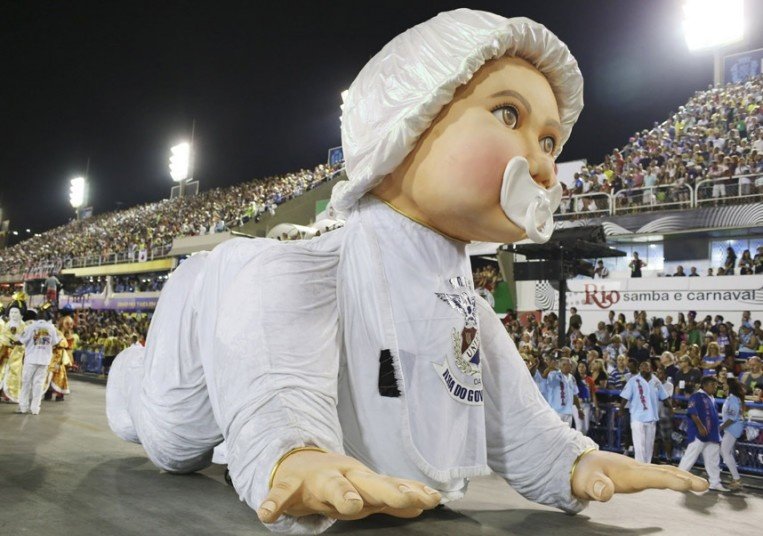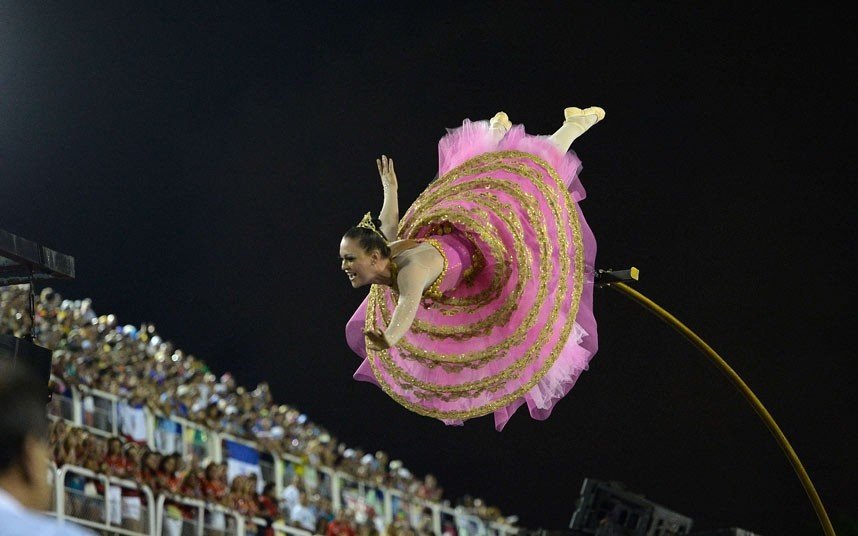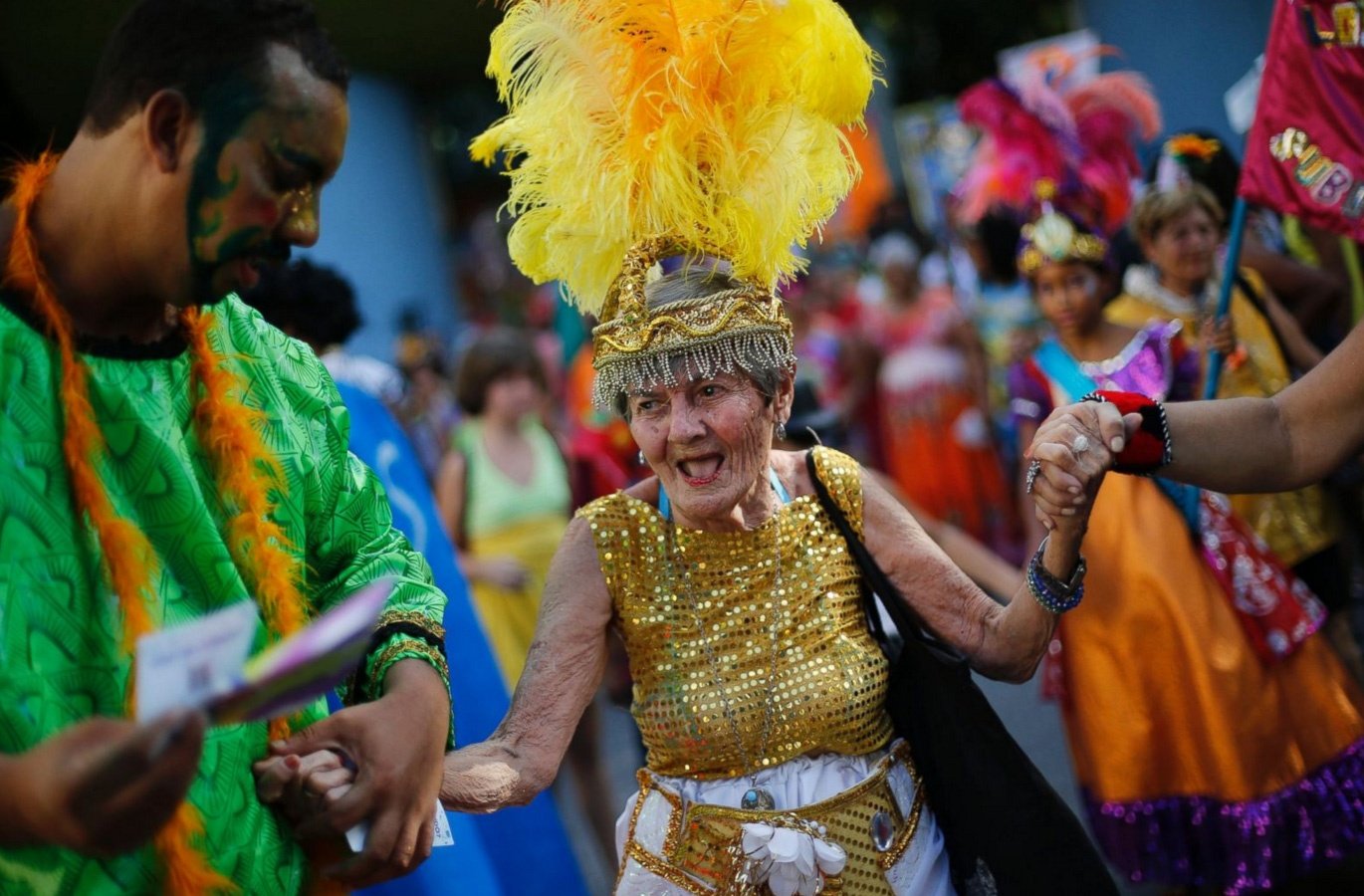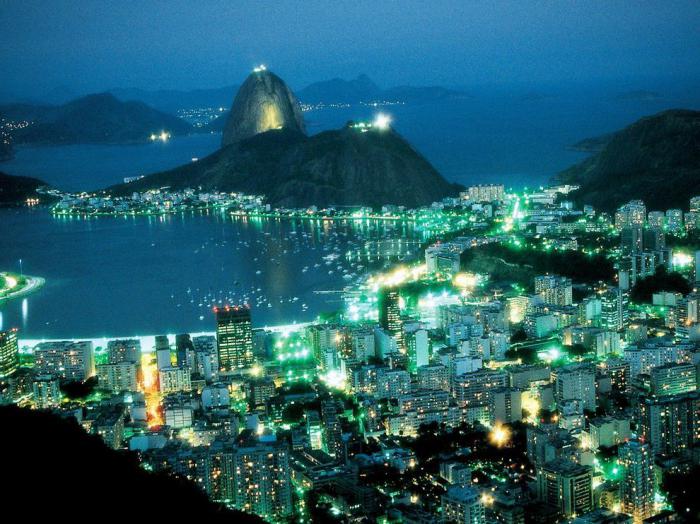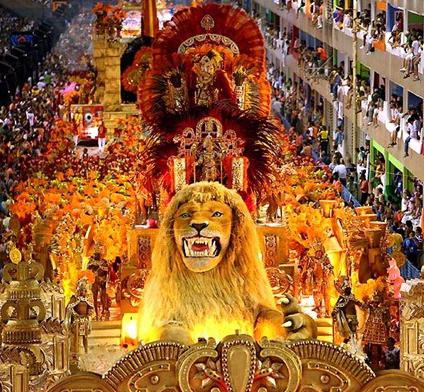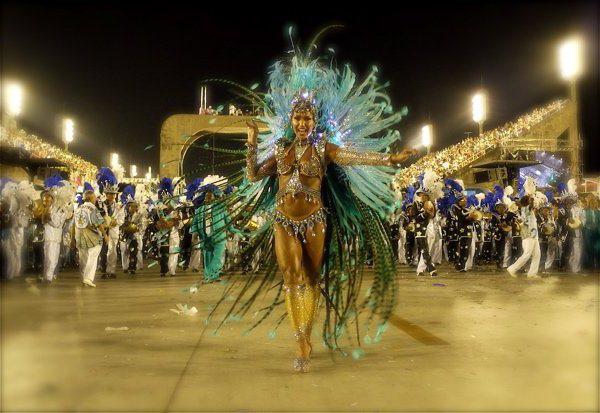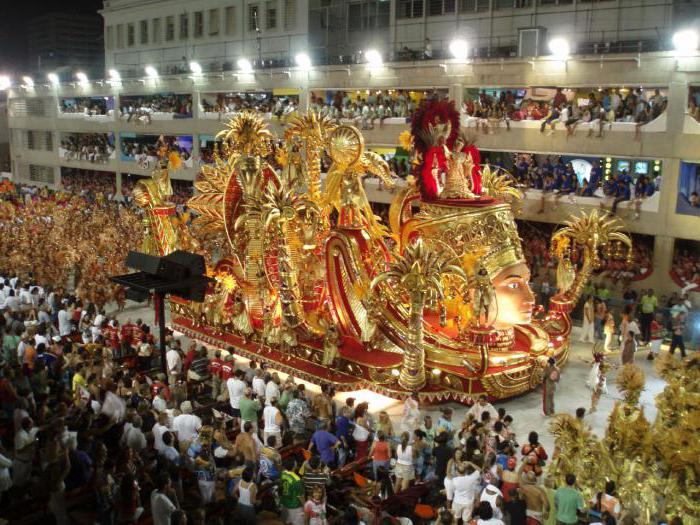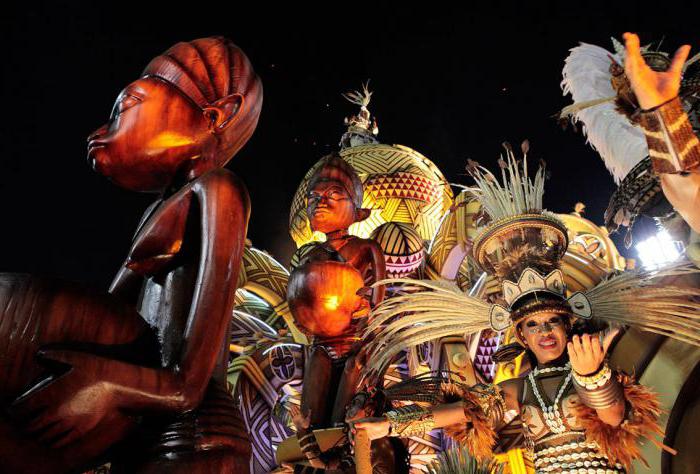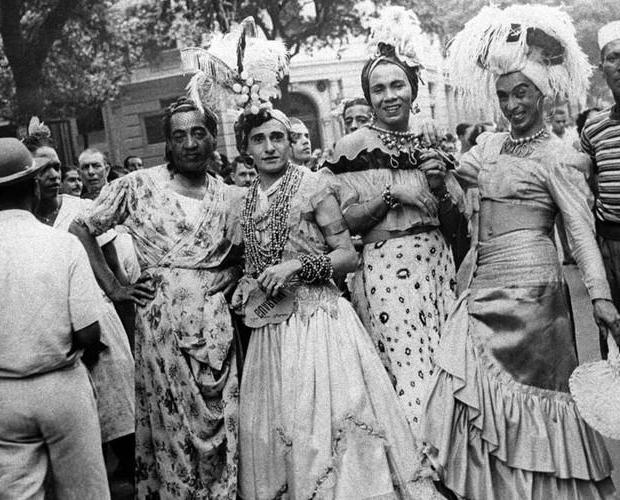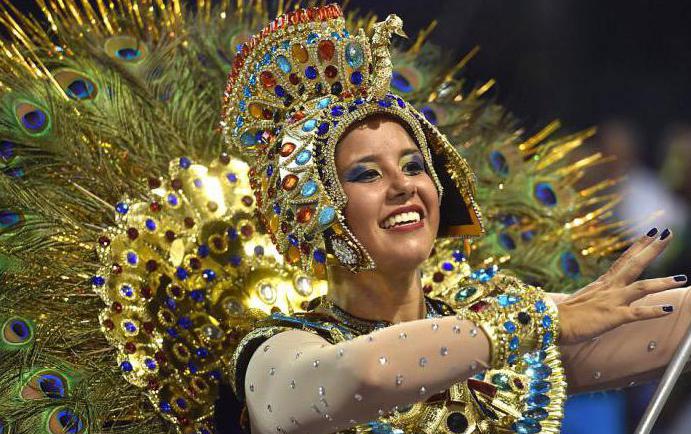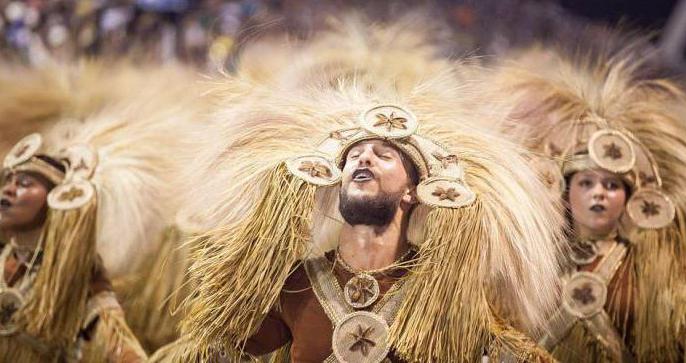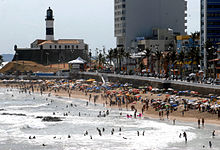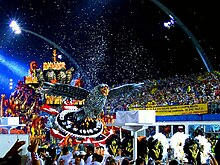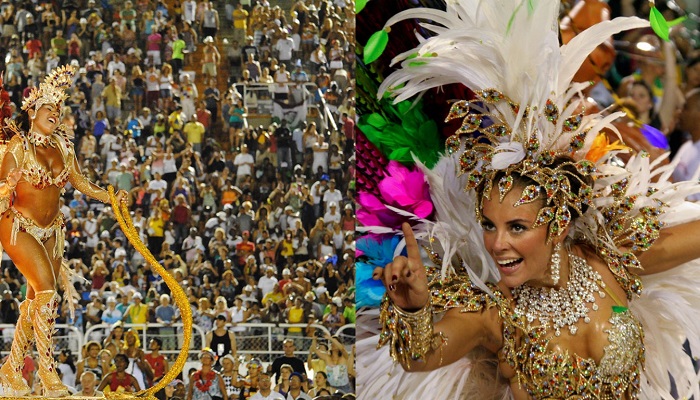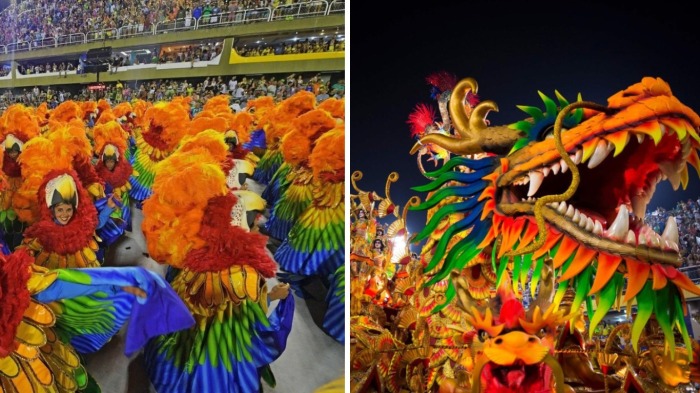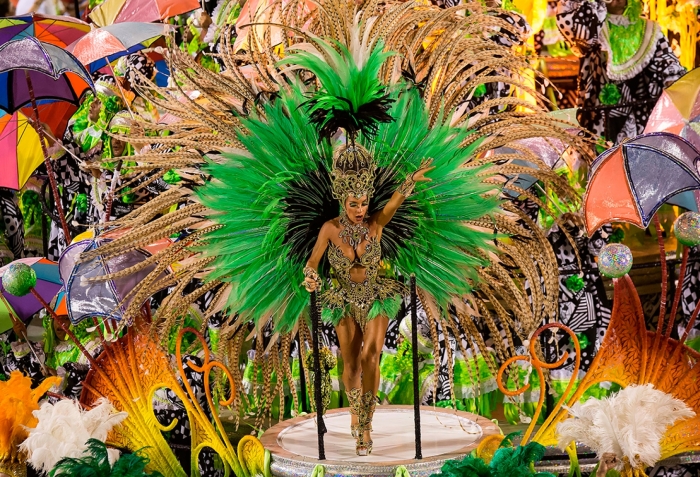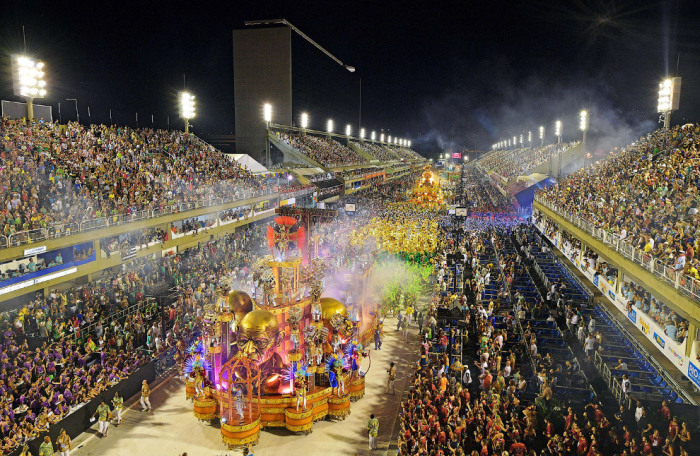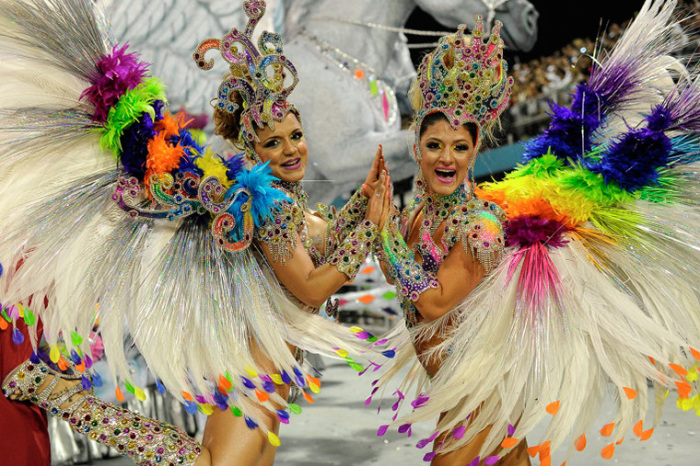Карнавал – главный бразильский праздник года, фееричное зрелище, фестиваль, на котором нет гостей, но все – хозяева. Это огромное представление, где каждый зритель – участник. Каждый год карнавал притягивает сотни тысяч туристов, вовлекая их в свою круговерть.
Содержание
- Происхождение и сроки проведения карнавала
- Как проходит карнавал
- Состязания школ самбы в Рио
- Народные гуляния
Происхождение и сроки проведения карнавала
Карнавал восходит к португальскому празднику «энтрудо», который отмечался в конце зимы. Праздник уходил корнями в языческие времена и являлся аналогом русской масленицы. Энтрудо знаменовал наступление весны и был последней возможностью повеселиться перед Великим постом. Участники поливали друг друга водой, осыпали мукой, забрасывали тухлыми яйцами и томатами, символически демонстрируя богатство и изобилие.
Первым карнавалом считаются грандиозные празднества начала марта 1808 года, когда король Португалии Жуан VI приехал в Бразилию, спасаясь от войск Наполеона. Десятидневный праздник сопровождался театральными представлениями, фейерверками, костюмированными шествиями, в которых участвовали королевские шуты и придворные. К концу XIX века карнавал обретает огромную популярность и поистине народный характер.
Сроки проведения карнавала привязываются к церковному календарю. Карнавал проводится с субботы по вторник и длится 4 дня. Чтобы определить дату карнавального воскресенья, отсчитывают назад 7 недель от Пасхи. Поскольку дата Пасхи плавающая и выпадает на первое осеннее (для Южного полушария) полнолуние, то и сроки карнавала ежегодно меняются.
Даты проведения карнавала:
- В 2016 году – с 6 по 9 февраля
- В 2017 году – с 25 по 28 февраля
- В 2018 году – с 10 по 13 февраля
- В 2019 году – со 2 по 5 марта
- В 2020 году – с 22 по 25 февраля
Как проходит карнавал
Карнавальные празднества включают состязания танцоров самбы, уличные шествия и гуляния. Первая школа самбы появилась в Рио-де-Жанейро в 1928 году, отсюда школы распространились по всей Бразилии. Зажигательный танец впитал элементы бразильских, португальских, итальянских традиций, африканских танцевальных ритуалов. Самба – одна из двух национальных страстей бразильцев. Каждый бразилец всю жизнь фанатично предан своему футбольному клубу и своей школе самбы.
Карнавалы проводятся во всех городах Бразилии, а самые известные из них – в Рио-де-Жанейро, Сан-Паулу, Салвадоре, Ресифи, Форталезе. Салвадорский фестиваль славен своим «Трио Электрико» — огромными, пышно разукрашенными грузовиками, с которых выступают певцы и музыканты. Звук на этих концертах оглушительный. Но самым популярным и зрелищным является карнавал в Рио. Его посещает до миллиона туристов – треть всех приезжающих в город за год.
Празднество в неофициальной столице Бразилии начинается с торжественной передачи власти на время гуляний мэром города избранному из жителей Рио Королю карнавала. На четыре дня деловая и политическая жизнь останавливается. Улицы городов наполняются людьми в фантастических костюмах и головных уборах. Всюду звучит музыка, которой местные жители с энтузиазмом аккомпанируют на кастрюлях и сковородках, проходят конкурсы и импровизированные концерты. Веселье не затихает ни на миг и длится круглые сутки.
Состязания школ самбы в Рио
Важнейшей частью карнавала являются соревнования танцоров самбы. Каждая школа выставляет от 2 до 5 тысяч участников, Подготовка к карнавалу длится весь год. Лучшие дизайнеры создают эскизы костюмов, а лучшие портные их шьют, лучшие хореографы изобретают новые танцевальные фигуры и обучают им будущих участников, а лучшие композиторы сочиняют мелодии, под которые школа пройдёт по Самбодрому.
Самбодром – это оборудованная для шествия школ самбы широчайшая улица, вдоль которой размещены трибуны, вмещающие до 70.000 зрителей. Билеты стоят до полутора тысяч долларов. Цена включает всё, что может потребоваться зрителю, вплоть до СПА-процедур. С балкона над Самбодромом ведётся прямая телетрансляция карнавального дефиле.
Кульминация фестиваля – прохождение процессий лучших школ самбы. Возглавляет парад королева школы, которая восседает на разукрашенной повозке, окружённая лучшими танцовщицами. Следом идут учителя самбы, известные танцоры, артисты, спортсмены. Над колонной возвышаются огромные куклы, а вокруг дефиле, танцуя, движутся ученики школы. Одеждой себя танцовщицы особо не утруждают, но зрелище прекрасных полуобнажённых тел никого не может шокировать или оскорбить. В Бразилии существует настоящий культ физической красоты, а в школы самбы берут только лучших из лучших.
Процессия одной школы растягивается на полкилометра, а прохождение длится около часа. Само шествие объединено какой-то темой, идеей, которая заявляется до карнавала. Обычно это природа, музыка, спорт, иногда политика.
Парад школ самбы длится с 21-00 до 5-6-ти утра.
Первые два дня отведены для начинающих школ, вторые – для элитных.
Участников парада оценивает специальное жюри. Учитываются мастерство танцовщиц, красота костюмов, художественное и музыкальное оформление. В среду жюри называет победителей, а несколько дней спустя чествуют триумфаторов, после чего они проводят показательные выступления.
Народные гуляния
Во всех городах и посёлках страны проходят массовые гуляния и уличные шествия, объединяющие всех без исключения бразильцев и приезжих, которым повезло оказаться в Бразилии во время карнавала. Стихийно возникают импровизированные концертные площадки, собственные соревнования по самбе и собственные парады.
Традиционно карнавальные шествия принимают три формы. Это, во-первых, «кордау», верёвочка, когда участники шествия строятся шеренгой или гуськом и, танцуя, проходят по улицам. Затем уличный, он же карнавальный, блок, когда выстраиваются прямоугольником. И, наконец, «раншу», театрализованное шествие колонной, участники которого демонстрируют элементы африканских магических обрядов.
Повсеместно организуются конкурсы, выбираются свои короли и королевы, строятся эстрады и уличные кафе. Если в эти дни гостю Бразилии довелось оказаться в совсем маленьком городке или посёлке — он и там в полной мере почувствует праздничную атмосферу карнавала. Даже если у вас есть билеты на лучшие места Самбодрома – обязательно спуститесь с трибуны и уйдите в сторону от центральных улиц. Настоящее народное карнавальное веселье, сама душа Бразилии — именно там.
Дата события уникальна для каждого года. В 2023 году эта дата — 17 февраля

Карнавал Рио (Rio Carnival) — самый большой, красочный, эмоциональный, яркий, народный праздник Бразилии. Кто же не слышал о карнавале, ежегодно проводимом в Рио-де-Жанейро?
Проведение этого грандиозного праздника ежегодно приходится на разную дату, которая связана с днем Пасхи.
Официально карнавал начинается в предшествующую Великому посту пятницу и продолжается в течение пяти дней до Жирного вторника. А на следующий день после официального завершения карнавала — в Пепельную среду — начинается Великий пост. Но, как правило, карнавальное шоу выходит за рамки официально установленных сроков.
Карнавал в Рио-де-Жанейро — это парад самбы и театрализованное шоу, проводимое на Самбадроме в центре города для огромного количества зрителей, где за звание победителя борются известнейшие школы. Каждая школа демонстрирует свое умение в течение 80 минут под оглушительный стук барабанов и пение собственного гимна, раскрывая содержание своего представления с помощью костюмов и танца. Компетентные судьи оценивают представление каждой школы.
Карнавал в Бразилии — праздник для всех ее жителей. Даже многие местные знаменитости активно участвуют в его организации и проведении, не стесняясь демонстрировать свое полуобнаженное тело.
К этому празднику здесь начинают готовить с детства. А в магазинах можно приобрести карнавальную одежду для детей, начиная с годовалого возраста.
Карнавал давно превратился в большую статью дохода, привлекая туристов со всего мира. Но, направляясь на этот великолепный праздник, необходимо помнить о соблюдении мер личной безопасности, поэтому туристам рекомендуется не выходить из отеля с суммой в кармане, превышающей 20 у.е.
Carnaval do Brasil — всемирно известная экскурсия по бразильской популярной культуре. Это ежегодный фестиваль, проходящий во многих городах Бразилии за 40 дней до Пасхи. Карнавал — это не просто красочное шествие с танцами и барабанами, это и индийский праздник красок Холи, и гей-парад, и баварский Октоберфест, и фестиваль ковбоев, и карнавал амазонский индейцев. Карнавал настолько важен для бразильцев, что год делится на две части: до и после карнавала… После Нового года все в Бразилии будут готовиться к карнавалу. В январе и феврале ничего особенного не происходит. Для бразильцев, 2020 год начнется после карнавала!
Изначально это был праздник еды, и длился он до Пепельной среды, которая знаменует начало периода Великого поста перед Пасхой. Бразильский карнавал в Рио привлекает сотни тысяч туристов из разных уголков земного шара в город, где они могут наслаждаться пульсирующими звуками самбы, а также принять участие в карнавальном шествии.
История карнавала
Слово «карнавал» происходит из латинского языка, а по некоторым источникам, от португальского словосочетания «carnevale», которое можно перевести как «прощание с мясом». Именно эта фраза относится к карнавалу, как к празднованию до периода воздержания от алкоголя, мяса и удовольствий. Празднование карнавала в Рио начинается за неделю до Пепельной среды. В Римско-католической церкви это первый день Великого поста. В этот день, в соответствии с древним обычаем, на лоб верующим освященным пеплом наносится знамение креста.
Португальские переселенцы имели свои традиции празднования перед Великим постом — «Entrudo» (происходит от португальской масленицы, праздника, который праздновался в Португалии еще с XV века). Это было очень шумное веселье, сопровождаемое обливанием водой, обсыпание мелом и мукой. Шум мешал горожанам, и празднование было запрещено указом короля. Но он переместился в жилища богатых людей города.
В 1840 году состоялся самый первый карнавал в Рио, а европейские танцы полька и вальс заняли центральное место на празднике. Африканские рабы, привезенные в Бразилию португальцами, дали жизнь первым ритмам самбы. В результате Бразильский карнавал соединил в себе европейский фестиваль с африканскими ритмами, музыкой и танцами.
Самба — сердце карнавала
В начале XX века на карнавале зазвучала самба, считающаяся традиционной бразильской музыкой, являющаяся продуктом взаимной любви к музыке бывших колонистов и бывших рабов. Музыка самба на уличных парадах способствовала появлению школ самбы в Рио-де-Жанейро. В начале 1920-х годов в городе были созданы первые школы самбы. Сегодня воспитанники этих школ в самом сердце карнавальных торжеств. В юго-восточных городах, Рио-де-Жанейро и Сан-Паулу, огромные организованные парады возглавляются школами самбы.
Название самой старой и самой известной школы самбы, основанной в 1928 году, — Mangueira. Это учебное заведение обещает представить увлекательное шоу в Рио на карнавале 2018 года в одном из ночных клубов Scala. Лучшие школы самбы, такие как Salgueiro, Mocidade, GrandeRio и BeijaFlor, обычно следуют примеру Mangueira.
Стадион Sambódromo Если в XIX веке жители районов Рио принимали участие в карнавальных парадах с группами людей, возглавляемых танцующими самбу, в сопровождении барабанщиков и других музыкантов, то с середины XX века карнавал стал конкурирующей ареной для школ Samba. Уличные парады становились все более и более динамичными с появлением школ самбы, что впоследствии привело к необходимости строительства стадиона. Дух конкуренции требовал мощной арены для презентации танцев, и вскоре, в 1984 году, Sambodromo (Самбодром) был построен. Это продукт дизайнерской работы известного архитектора Оскара Нимейера. Грандиозное сооружение, состоящее из трех этажей, имеет длину чуть меньше километра и рассчитано на 70 тысяч зрителей. С тех пор стадион постоянно модифицируется, воплощая новые идеи многочисленных иммигрантов.
Король Момо
Грандиозный праздник карнавала начинается с передачи символических ключей от города «хозяину» праздника, самому толстому мужчине, которого выбрали из всех претендентов (вес не менее 110 кг). Четыре дня длится его власть в городе. В его обязанности входит постоянное нахождение на Самбодроме, посещение им балов и конкурсов, а их более двухсот. И еще одна обязанность «хозяина» карнавала — он должен все время танцевать.
Самбодром на время праздника превращается в мир со сказочными картинками, среди которых огнедышащие драконы, пиратские корабли, подводные царства. В торжественном параде самбо участвуют китайские мудрецы и римские легионеры, неандертальцы и даже голова медузы Горгоны проплывает у трибун ликующих зрителей. В течение трех ночей перед восторженной публикой проходят, проплывают, проезжают вереницы платформ с танцующими на них полуобнаженными мулатками.
Дух карнавала
По сути, происхождение бразильского карнавала — это «притворство». Почти неделя карнавала — это безграничные праздники. Только в эти несколько дней в году «разрешено» притворяться кем-то. Бедные могут носить дорогие костюмы, богатые могут смешаться с толпой обычных людей. Большая часть населения одевается в пестрые наряды и выходит на улицы. Кстати, в честь фееричного праздника был назван сорт тюльпана — «карнавал де Рио», который по пестроте лепестков сравним с нарядами на карнавальных шествиях. Варианты одежды поистине безграничны!
Мужчины могут надеть женскую одежду, девушки на карнавале в Рио де Жанейро практически не одеты. Все, что можно назвать одеждой, представляет собой набор пайеток и перьев. Карнавал — это законная возможность позволить себе забыть повседневные проблемы, и убежать в мир фантазий.
Школы самбы
Официальный парад Samba — это конкурс на карнавале, в котором участвуют лучшие из школ самбы в Рио-де-Жанейро. Что такое школа самбы? Можно сказать, что это объединение людей, которые занимаются самбой в течение года, оттачивая танец до совершенства. Каждая школа насчитывает от 3 до 5 тысяч человек. Из них большая часть будет участвовать в шествии, и представлять свою школу, и, конечно, стремиться попасть в число шести лучших школ. Именно эти школы будут участвовать в финальной части праздника. В 1933 году состоялись первые соревнования по парадам самбы. Цель парада — дать школам самбы возможность продемонстрировать все свои таланты. Им нужно выбрать свою тему для карнавала и написать песню, которая будет прекрасно отражать эту тему. Школу представляет знаменосец, церемониймейстер и группа барабанщиков. Время конкурсов для «высшей лиги» забронировано на воскресенье и понедельник. Существует также «вторая лига». Школы этой лиги дают представление во вторник вечером. Парады проходят на стадионе Самбодром в центральном пригороде Санто-Кристо. На карнавале в Рио в 2018 г., который будет проходить с 10 по 13 февраля, страстные танцоры самбы, в своих фантастических и, как всегда, провокационных костюмах, заставят всех присутствующих присоединиться к празднику.
Парад Samba в Sambódromo
Парад на Самбодроме — это демонстрация того, чего достигли за месяцы подготовки участники той или иной школы самбы. Это театрализованное выступление по выбранной заранее теме. Красочное шоу: дефиле школ самбы, проходит в сопровождении музыки и пения. Каждая школа имеет свой флаг и цвет. Есть у каждой школы свои болельщики, которые любят посещать репетиции в течение года, и «болеют» на карнавале за свою школу, поддерживая ее во время выступления не менее азартно, чем на футбольном матче.
В 2017 году в Карнавале, который проходил с 25 по 28 февраля, приняли участие более 70 школ самбы. Жюри оценивает по многим параметрам выступление школ. Это сплоченность коллектива, раскрытие темы, соответствие хореографии этой теме, и умение уложиться в отведенное для выступления время (от 65 до 80 минут). Приз, который получает победившая на карнавале школа самбы, составляет около 1 миллиона долларов США. Есть за что бороться!
Уличные парады
Уличные парады в городах Бразилии — явление привычное. Они устраиваются не только во время карнавальных празднеств в Рио-де Жанейро и других городах Бразилии, они берут свой старт уже в ноябре. Туристы могут примыкать к танцующим группам или вечеринкам. Стоит отметить, что нужно быть осмотрительными. Вечеринки бывают не только забавны. Относительно безопасные гулянья обычно в Южной зоне и центре города, где гуляют кариоки (самоназвание жителей Рио). Эти весельчаки считают себя самыми счастливыми людьми на планете. А ведь заслуга карнавала в том, что во время фейерверка страстей, который бушует на карнавале, сжигается весь негатив и комплексы. Люди получают колоссальный заряд бодрости и веселья, а значит и счастья!
| Brazilian Carnaval | |
|---|---|

Devla Imperatrix Queen of Carnaval in Rio De Janeiro. Rio’s carnaval is the largest in the world according to Guinness World Records.[1] |
|
| Also called | Carnaval |
| Observed by | Brazilians, communities worldwide |
| Type | Cultural, Religious (Roman Catholicism) (Afro Candomblé) |
| Significance | Celebration prior to fasting season of Lent. |
| Begins | Friday before Ash Wednesday (51 days to Easter) |
| Ends | Ash Wednesday midday (46 days before Easter) |
| 2022 date | Afternoon, February 25 – midday, March 2 |
| 2023 date | Afternoon, February 17 – midday, February 22 |
| 2024 date | Afternoon, February 9 – midday, February 14 |
| 2025 date | Afternoon, February 28 – midday, March 5 |
| Frequency | annual |
| Related to | Carnival, Mardi Gras, Ash Wednesday, Lent |
The Carnival of Brazil (Portuguese: Carnaval do Brasil, IPA: [kaʁnaˈvaw]) is an annual Brazilian festival held the Friday afternoon before Ash Wednesday at noon, which marks the beginning of Lent, the forty-day period before Easter. During Lent, Roman Catholics and some other Christians traditionally abstained from the consumption of meat and poultry, hence the term «carnival», from carnelevare, «to remove (literally, «raise») meat.»[2]
Rhythm, participation, and costumes vary from one region of Brazil to another. In the southeastern cities of Rio de Janeiro, São Paulo, and Vitória, huge organized parades are led by samba schools. Those official parades are meant to be watched by the public, while minor parades (blocos) allowing public participation can be found in other cities, like Belo Horizonte,[3] also in the southeastern region. The northeastern cities of Recife, Olinda, Salvador, and Porto Seguro have organized groups parading through streets, and public interacts directly with them. It is a six-day party where crowds follow the trios elétricos through the city streets, dancing and singing. Also in northeast, Olinda carnival features unique characteristics, heavily influenced by local folklore and cultural manifestations, such as Frevo and Maracatu.
The typical genres of music of Brazilian carnival are, in the Southeast Region in general, mostly cities of Rio de Janeiro and São Paulo: the samba-enredo, the samba de bloco, the samba de embalo and the marchinha; and in the Northeast Region including Pernambuco (mostly cities of Olinda and Recife): frevo and maracatu, and Bahia (mostly the city of Salvador): samba-reggae, pagode (also a type of Samba) and the main genre axé music. These rhythms were mainly developed by Afro-brazlians and Pardos, incorporating and adapting many cultural influences, from the percussion beats of Africa to the military fanfares of Europe and iberian music in the use of instruments like pandeiro and cavaquinho.
Carnival is the most popular holiday in Brazil and has become an event of huge proportions.[4][5][6][7] Except for industrial production, retail establishments such as malls, and carnival-related businesses, the country unifies completely for almost a week and festivities are intense, day and night, mainly in coastal cities.[8] Rio de Janeiro’s carnival alone drew 4.9 million people in 2011, with 400,000 being foreigners.[9]
Brazilian carnival in essence is a synthesis of European, indigenous, and Afro-Brazilian cultural influences, each group has played an important role in the development of the structure and aesthetic of the Brazilian carnival of today. For instance, the main rhythms used in carnival celebrations were developed by Afro-Brazilians and make use of European instruments like the cavaquinho and pandeiro to create melodies and arrangements, also the fantasies and costumes in the Brazilian carnival borrow concepts from the clothing of the natives, like the use of feathers and the tendency to use lighter pieces of clothing. Historically its origins can be traced to the Portuguese Age of Discoveries when their caravels passed regularly through Madeira, a territory which already celebrated emphatically its carnival season, and where they were loaded with goods but also people and their ludic and cultural expressions.[10][11]
Disruptions[edit]
The Carnival was first suspended in 1912, following the death of the Baron of Rio Branco, at the time Brazilian Minister of External Relations. The mayor of Rio reportedly postponed all licenses for the Carnival associations, but despite this many residents still partied in the streets anyway.[12] The Carnival went on as scheduled despite World War I and World War II, besides during Brazil’s military dictatorship, despite strict regulations.
The first disruption to the Carnival in 108 years took place in late September 2020 amid the COVID-19 pandemic in Brazil, when the 2021 festival was cancelled.[13][14] The next festival is scheduled for 26 February-2 March 2022, depending on the evolution of the epidemiological situation in the country.[15]
By region[edit]
Rio de Janeiro[edit]
Devla Imperatrix- Queen Of Carnaval in Rio De Janeiro Sapucai
In the late 18th century, the «cordões» (literally «cords», laces or strings in Portuguese) combined with the «dança do coco» (literally «coconut dance» an Afro-Brazilian dance troupe form) were introduced in Rio de Janeiro. These were pageant groups that paraded through city avenues performing on instruments and dancing. Today they are known as Carnaval blocos (blocks), consisting of a group of people who dress in costumes or special T-shirts with themes and/or logos. Blocos are generally associated with particular neighbourhoods; they include both a percussion or music group and an entourage of revelers. They eventually became the «fathers» of what everyone today knows as the famous and internationally renowned samba-schools in Brazil. Samba-schools (not only in Rio de Janeiro, but in São Paulo and several other cities) are the cultural epicenter of the Brazilian carnival, in terms of the «parading style». The first registered samba-school was called «Deixa-falar», but disappeared later and the first official samba-school contest happened in 1929, with only three groups, and «Oswaldo Cruz» group won the competition, with a samba written by Heitor dos Prazeres. GRES Estação Primeira de Mangueira Samba-School, represented by Cartola, and Estácio de Sá samba School, represented by Ismael Silva, were the other 2 contestants. Eventually, «Oswaldo Cruz» became Portela Samba School, the greatest winner of Rio’s Carnival with 22 Titles. Although many Brazilians tend now to favor other forms of national music culture to that of Rio’s samba schools, the carnival of Rio de Janeiro remains the national festival par excellence, and the samba of Rio de Janeiro continues to be an agent of national unification.[16]
Carnaval blocos, also known as Blocos de Rua («Street Blocks») occur in nearly every neighborhood throughout the city and metropolitan areas, but the most famous are the ones in Copacabana, Ipanema, Leblon, Lagoa, Jardim Botânico, and in downtown Rio. Organizers often compose their own music themes that are added to the performance and singing of classic «marchinhas» and samba popular songs. «Cordão do bola preta» («Polka Dot Bloco»), that goes through the heart of Rio’s historical center, and «Suvaco do Cristo» (‘Armpit of Christ the Redeemer’, referring to the angle of the statue seen from the neighborhood), near the Botanical Garden, are some of the most famous groups. Monobloco has become so famous that it plays all year round at parties and small concerts.
The formalized samba schools are very small groups of performers, financed by respected organizations (as well as legal gambling groups), who work year-round in preparation for Carnival. Samba Schools perform in the Sambadrome, which runs four entire nights and is overseen by LIESA.[17] They are part of an official competition, divided into seven divisions, in which a single school is declared the winner, according to ten judging categories[18] that include costume, flow, theme, and band music quality and performance. Some samba schools also hold street parties in their neighborhoods, through which they parade along with their followers.
All performers at the Sambadrome have to wear a costume. Some honored members of the school or community may receive one for free, but normally, most will have to pay for their own.[19] Tourists can have the same experience on the «Commercial Area» of some Samba Schools but need to buy their own costume from the school, or through an agent, either of which can be quite costly.[20]
Bahia[edit]
There are several major differences between Carnival in the state of Bahia in Northeastern Brazil and Carnival in Rio de Janeiro. The musical styles are different at each carnival; in Bahia there are many rhythms, including samba, samba-reggae, axé, etc., while in Rio there is the multitude of samba styles: the «samba-enredo», the «samba de bloco», the «samba de embalo», the «funk-samba», as well as the famous «marchinhas» played by the «bandas» in the streets.
Carnival circuit of the city of Salvador.
In the 1880s, the black population commemorated the days of Carnival in its own way, highly marked by Yoruba characteristics, dancing in the streets playing instruments. This form was thought of as «primitive» by the upper-class white elite, and the groups were banned from participating in the official Bahia Carnival, dominated by the local conservative elite. The groups defied the ban and continued to do their dances.
By the 1970s, four main types of carnival groups developed in Bahia: Afoxês, Trios Elétricos, «Amerindian» groups, and Blocos Afros. Afoxês use the rhythms of the African inspired religion, Candomblé. They also worship the gods of Candomblé, called orixás. An Electric Trio is characterized by a truck equipped with giant speakers and a platform where musicians play songs of local genres such as axé. People follow the trucks singing and dancing. The «Amerindian» groups were inspired by Western movies from the United States. The groups dress up as Native Americans and take on Native American names. Blocos Afros, or Afro groups, were influenced by the Black Pride Movement in the United States, independence movements in Africa, and reggae music that denounced racism and oppression. The groups inspired a renewed pride in African heritage.[21]
Today, Bahia’s carnival consists mostly of Trios Elétricos, but there are still Blocos Afros and Afoxês. Every year, about half a million tourists are attracted to Salvador. It is also possible to watch everything from the Camarotes (ringside seats) spread out along the way, offering more comfort to the visitors.
Pernambuco[edit]
Recife Carnival, in the capital city of the State of Pernambuco, Recife
The northeast state of Pernambuco has unique Carnivals in its present capital Recife and in its colonial capital Olinda. Their main rhythms are the frevo and the maracatu. Galo da Madrugada is the biggest carnival parade in the world, considering the number of participants, according The Guinness Book of World Records. It means «dawn’s rooster» and parades, as the name suggests, in the morning only. Frevo is Pernambucan-style dance with African and acrobatic influences, as it is fast and electrifying, often using an open umbrella and frequent legs and arms movements.
Unlike Salvador and Rio, the festivities in Recife, Olinda and Itamaraca do not include group competitions. Instead, groups dance and play instruments side by side. Troças and maracatus, mostly of African influence, begin one week before Carnival and end a week later.
São Paulo[edit]
Carnival parade in São Paulo, Gaviões da Fiel Torcida Samba School.
One of the most popular and inexpensive costumes at the Brazilian Carnaval – Bloco Do Fraldão
The carnival in São Paulo takes place in the Anhembi Sambadrome on the Friday and Saturday night of the week of Carnival, as opposed to Rio’s Carnival, which is held on Sunday and Monday night.
Various «samba schools» compete in a huge parade. Each school presents a different theme, which they expose through their costumes, dance, music, and the allegorical cars or «carros alegóricos«, huge vehicles decorated according to the theme designed specifically for the parade. The schools are responsible for choosing their own themes, which usually revolve around historical happenings or some sort of cultural or political movement.
Vai-Vai is the oldest school and has been the Special Group champion most times (15 total, including the 2015 championship). It also is the most popular, for it has a larger fan base and many supporters among the people of the city.
São Paulo has usurped Rio de Janeiro as the Brazilian city with the largest and most diverse Carnival in Brazil.[22] It is also the most LGBTQ+ friendly Carnival in Brazil.[23] In 2017, the Sexual Diversity Museum of São Paulo formed its own Carnival group to provide the message of inclusion, peace, and respect for all LGBT people.[23] In 2020, São Paulo Carnival has featured Camilla Prins, the first transgender woman to lead a samba school in any Carnival event in Brazil.[24]
Espírito Santo[edit]
The Carnival in Vitória are performed one week before Carnival, more precisely in Sambão do Povo. The schools are responsible for choosing their own themes, which usually revolve around historical happenings or some sort of cultural or political movement.
More than the traditional school parade, the carnival in Espirito Santos includes a large set of attractions, especially in the beach areas of the state, from north to south.
Minas Gerais[edit]
Carnival in Minas Gerais is often characterized by blocos carnavalescos with varying themes and costume styles, typically accompanied by a brass and drums band. The carnival has been heavily influenced by the Rio de Janeiro Carnival, and several cities hold parades with samba schools. More recently, Axé groups from Bahia come to play in the state.
The most traditional carnival parades happen in the historic cities of Ouro Preto, Mariana, São João del Rei, and Diamantina.
Since the 2010s, the carnival in the state capital Belo Horizonte has increased heavily in popularity,
Other cities in the state, such as Juiz de Fora, Abaeté, Pompéu, and Três Pontas, also have popular parades.
Ouro Preto is popular among college students. The city has a large proportion of students, who during the year live in places called Repúblicas (a Brazilian equivalent to a frat house). During carnival, the Repúblicas turn to affordable accommodation for both residents and visitors coming from all over the country. The city hills, narrow streets, and stone pavement prevent traffic of heavy sound trucks.[25]
Zé Pereira dos Lacaios, the oldest carnival block in Brazil with more than 150 years, parade in the city.
The first carnival party in Belo Horizonte happened in 1897, even before the inauguration of the city.[citation needed]
Still, for decades the carnival in the city was not as popular as in historical cities.
Only in the 2010s the situation has changed, and the carnival started gaining increasing popularity.
In 2017, Belo Horizonte had the largest carnival in its history and the third-largest in Brazil. There were more than three million people on the streets, with about 500,00 tourists.[26] The Baianas Ozadas block hit a record audience of 500,000 people.
Juiz de Fora had one of the three largest carnivals in Brazil in the 1980s. But it has been steadily losing popularity. A deadlock between the league of local samba schools (LIESJUF) and the municipality’s culture agency (Funalfa) [27] prevented parades in the city since 2016. As a temporary solution, the parades have been held at Intendente Magalhães.[28]
Others[edit]
Some Southern cities such as Uruguaiana, Florianópolis, and Porto Alegre have smaller samba school groups or blocos, but like São Paulo state towns, they seem to prefer balls to street dancing. Curitiba hosts modest carnival celebrations similar to those of other Brazilian cities and events such as Curitiba Rock Festival and a carnival Zombie Walk, all supported by Cultural Foundation of Curitiba which operates under supervision of government of Curitiba.[29][30][31][32]
Sambódromo[edit]
The Carnival parades in Rio de Janeiro and São Paulo take place in their sambódromos, located close to the city center. In the Rio Sambódromo, the parades start at 20:00 or 21:00 (depending on the date) and end around 5:00 in the morning.[33] The Rio de Janeiro Metro operates 24 hours during the main parade days.[33]
Music[edit]
Samba[edit]
Originated in Rio de Janeiro between the end of the 19th century and the first years of the 20th century, the samba is still one of the most popular music styles of Brazil. From intimate samba-canções (samba songs) sung in bars to explosive drum parades performed during carnival, samba always evokes a warm and vibrant mood. In the 1930s, a group of musicians led by Ismael Silva founded in the neighborhood of Estácio de Sá the first samba school, Deixa Falar. They transformed the musical genre to make it fit better the carnival parade. In this decade, the radio spread the genre’s popularity all around the country, and with the support of the nationalist dictatorship of Getúlio Vargas, samba became Brazil’s «official music.»
In the following years, samba has developed in several directions, from the gentle samba-canção to the drum orchestras which make the soundtrack of carnival parade. One of these new styles was bossa nova, a musical movement initially spearheaded by young musicians and college students from Rio de Janeiro. It got increasingly popular over time, with the works of João Gilberto and Antonio Carlos Jobim. In the sixties, Brazil was politically divided, and the leftist musicians of bossa nova started to draw attention to the music made in the favelas. Many popular artists were discovered at this time. Names like Cartola, Nelson Cavaquinho, Velha Guarda da Portela, Zé Keti, and Clementina de Jesus recorded their first albums. In the seventies, the samba got back to radio. Composers and singers like Martinho da Vila, Clara Nunes, and Beth Carvalho dominated the hit parade.
In the beginning of the eighties, after having been sent to the underground due to styles like disco and Brazilian rock, Samba reappeared in the media with a musical movement created in the suburbs of Rio de Janeiro. It was the pagode, a renewed samba, with new instruments, like the banjo and the tantan, and a new language, more popular, filled with slang. The most popular names were Zeca Pagodinho, Almir Guineto, Grupo Fundo de Quintal, Jorge Aragão, and Jovelina Pérola Negra. Various samba schools have been founded throughout Brazil. A samba school combines the dancing and party fun of a night club with the gathering place of a social club and the community feeling of a volunteer group. During the spectacular Rio Carnival, famous samba schools parade in the Sambódromo.[34]
Frevo[edit]
Frevo dancers. The Frevo was included on the UNESCO’s list of intangible heritage.[35]
Frevo is a wide range of musical styles originating from Recife and Olinda, Pernambuco, Brazil, all of which are traditionally associated with Brazilian Carnival. The word frevo is said to come from frever, a misspeaking of the Portuguese word ferver (to boil). It is said that the sound of the frevo will make listeners and dancers to feel as they are boiling on the ground. The word frevo is normally used interchangeably either to mean the frevo music or the frevo dance.
The frevo music came first, which is carnival music played by brass or wind marching bands combined with parts of the samba school drumline. By the end of the 19th century, bands from the Brazilian Army regiments based in the city of Recife started a tradition of parading during the Carnival. Since the Carnival is originally linked to religion, they played religious procession marches and martial music, as well. A couple of regiments had famous bands that attracted many followers and it was just a matter of time to people start to compare one to another and cheer for their favorite bands. The two most famous bands were the Espanha (meaning Spain), whose conductor was of Spanish origin, and the 14, from the 14th regiment. The bands started to compete with each other and also started playing faster and faster, louder and louder.
Axé[edit]
Axé is not exactly about a style or musical movement, but rather about a useful brand name given to artists from Salvador who made music upon northeastern Brazilian, Caribbean, and African rhythms with a pop-rock twist, which helped them take over the Brazilian hit parades since 1992. Axé is a ritual greeting used in Candomblé and Umbanda religions, and means «good vibration.» The word music was attached to Axé, used as slang within the local music biz, by a journalist who intended to create a derogatory term for the pretentious dance-driven style.
As singer Daniela Mercury began her rise to stardom in Rio and São Paulo, anything coming from Salvador would be labeled Axé Music. Soon, the artists became oblivious to the derogatory origins of the term and started taking advantage of it. With the media pushing it forward, the soundtrack of Carnival in Salvador quickly spread over the country (through off-season Carnival shindigs), strengthening its industrial potentials and producing year-round hits along the 90s.
Tested within the height of Carnival heat, Axé songs have been commercially successful in Brazil throughout the past decade. The year 1998 was particularly fortunate for the artists from Bahia: together, Daniela Mercury, Claudia Leitte, Ivete Sangalo, Asa de Aguia, Chiclete com Banana, Araketu, Cheiro de Amor, and É o Tchan sold over 3.4 million records.[36]
TV broadcasting[edit]
The Brazilian Carnival Parades were first broadcast in the late 1960s on television on Rede Globo, which brought the Rio celebrations live, bringing the celebrations to more people all over the nation. By the 1970s, color broadcasting and satellite transmissions made the broadcasts to be beamed to other parts of the nation in real-time, by then featuring the top schools under, since 1984 the Liga Independente das Escolas de Samba do Rio de Janeiro – also known as the Special Group (since 1990), and formerly under the Associação das Escolas de Samba da Cidade do Rio de Janeiro. The now-defunct Rede Manchete broadcast the event on several occasions and mounted a joint broadcast with Globo for the 1987 event.
Since 1991, Globo’s broadcast of the parades, now dubbed Globeleza, at the Sambodrome in Rio and São Paulo have become the center of national and international attention. Until 2017, fans of the samba schools on parade also expected to watch a short preview of the performances of the schools involved to be broadcast during the duration of the event. By 2018 lyric video style adverts appeared in their place, complete with the colours of the competing schools in attendance, featuring the lyrics of the songs to be performed by the schools.
Globo acquired also the rights to air the parade of samba schools of São Paulo in 1990, and victory parades there were later aired in other local TV channels. Parades belonging to the Access Group (5th Division) and the B Series schools in Rio were also broadcast on several TV stations and are still the case today (in 2015 Rede Record and NGT aired the parades of the lower-level schools). Since 2014, Globo also has full rights to the A Series (Rio) and Paulista parades, which were co-shared with the Viva Channel before its closure in 2015 (which aired lower-level parades and the victory parades of the two cities’ winning schools for the year) and regionally, RBS airs the Carnivals of Florianopólis and Porto Alegre, and since 2015, cable channel TVCOM display the gaucho parades in the south. The Rio parade can also be heard on radio and seen via online streaming as well (thru TVG Rio and from 2015 in G1, which offers an online live streaming of the victory parade). In 2023, Rede Bandeirantes took over the broadcasting rights for the A Series.
The Carnivals of Recife and Salvador are shown by Band since the early 2000s, and Band also holds broadcast rights for the victory parade. Both fall under the Band Folia brand. This is also the case for SBT which also broadcasts the events under the SBT Folia banner and is also, since recently, seen via live streaming on YouTube. Since 2008, Globo also has its own broadcast team and crew for the broadcasts of the late night Galo da Madrugada in Recife.
Twinning[edit]
Santa Cruz de Tenerife, Spain; Since 1984, Rio de Janeiro is twinned with the city of Santa Cruz de Tenerife for the special link between the Carnival of Rio and the Carnival of Santa Cruz de Tenerife.[37][38][39]
See also[edit]
- Micareta, an off-season celebration similar to Carnival
References[edit]
- ^ «Largest carnival». Guinness World Records. 1 January 2004. Archived from the original on 15 April 2016. Retrieved 11 February 2016.
- ^ «Carnival». Online Etymology Dictionary. Archived from the original on 2 October 2012. Retrieved 9 February 2009.
- ^ «Carnaval de Belo Horizonte terá público recorde, menos recurso e mais restrições – 23/01/2016». Em.com.br. Archived from the original on 23 February 2020. Retrieved 28 November 2016.
- ^ «Topic: Carnival in Brazil». Statista. Archived from the original on 29 December 2020. Retrieved 4 December 2020.
Carnival is, without a doubt, the biggest national festivity in Brazil. For five days each year, the entire country unites in one big street party, where everyone is invited. But Carnival is not only a big part of the country’s culture, it is also an important event for the Brazilian economy.
- ^ NewsPaper, The Brasilians (6 February 2018). «Carnival, the Most Beloved Tradition of Brazil». The Brasilians. Archived from the original on 27 October 2020. Retrieved 4 December 2020.
- ^ «Rio’s Carnival – General Info». www.brazilao.com. Archived from the original on 11 April 2021. Retrieved 4 December 2020.
- ^ «Brazil Holidays and Festivals». www.iexplore.com. Archived from the original on 16 April 2021. Retrieved 4 December 2020.
Undoubtedly, Carnival is the country’s most famous gathering. Throughout many of Brazil’s metropolises, Carnival brings an energy that is unrivaled across the globe.
- ^ «Carnival in Brazil». Topics-mag.com. 7 October 2008. Archived from the original on 28 June 2011. Retrieved 4 June 2011.
- ^ «Folha.com – Cotidiano – Após recorde de público, Rio limita blocos no Carnaval 2012 – 14/03/2011». Folha.uol.com.br. 14 March 2011. Archived from the original on 12 June 2020. Retrieved 11 February 2016.
- ^ «Carnaval da Madeira poderá ter influenciado festividades no Brasil | Sociedade | Diário Digital». Diariodigital.sapo.pt. Archived from the original on 8 March 2016. Retrieved 11 February 2016.
- ^ «SIC Notícias – Cultura». Sicnoticias.sapo.pt. Archived from the original on 28 August 2018. Retrieved 11 February 2016.
- ^ de Sousa, Marcelo (24 September 2020). «Virus disrupting Rio’s Carnival for first time in a century». Associated Press. Archived from the original on 24 October 2021. Retrieved 13 October 2021.
- ^ «Global Covid report: Rio cancels Carnival for first time in a century as global deaths near 1m». The Guardian. 25 September 2020. Archived from the original on 26 October 2021. Retrieved 13 October 2021.
- ^ «Río de Janeiro suspende el carnaval por primera vez en 108 años» (in Spanish). La Radio 1029.com.ar. 1 October 2020. Archived from the original on 9 July 2021. Retrieved 9 July 2021.
- ^ «Confirman carnaval de Río de Janeiro para febrero del 2022» (in Spanish). El Comercio EC. 8 July 2021. Archived from the original on 9 July 2021. Retrieved 9 July 2021.
- ^ Vianna H, The Mystery of Samba: Popular Music and National Identity in Brazil, Universidade Federal do Rio de Janeiro 1995, trans. Chasteen J, University of North Carolina Press 1999. p.107.
- ^ «LIESA – Liga Independente das Escolas de Samba do Rio de Janeiro». Liesa.globo.com. Archived from the original on 4 January 2010. Retrieved 11 February 2016.
- ^ «Mapa de Notas». Retrieved 20 November 2013.[dead link]
- ^ «O Portal de Notícias da Paraíba, Nordeste e Brasil». WSCOM.com.br. Archived from the original on 19 December 2014. Retrieved 11 February 2016.
- ^ «Buy your Costumes for the Brazilian Costume Parade in Rio». Riocostumes.com. Archived from the original on 28 May 2013. Retrieved 11 February 2016.
- ^ Collins, John F. (2015). Revolt of the Saints: Memory and Redemption in the Twilight of Brazilian Racial Democracy. Durham, NC: Duke University press. ISBN 978-0-8223-5320-1.
- ^ Pasqualin, Vera da Cunha (2019). «The Street Carnival of São Paulo reflecting the polarised Brazilian society in 2019» (PDF). Emotions, Populism and Polarised Politics, Media and Culture. Archived (PDF) from the original on 28 February 2021. Retrieved 31 October 2020 – via Conference «Emotions, Populism and Polarised Politics, Media and Culture», University of Helsinki, August 2019.
- ^ a b Alface, Felipe (7 February 2018). «The LGBT side of Carnival in Brazil». The Washington Blade. Archived from the original on 4 November 2020. Retrieved 31 October 2020.
- ^ Savarese, Mauricio (22 February 2020). «Brazilian transgender dancer shatters Carnival parade taboo». AP News. Archived from the original on 2 October 2022. Retrieved 31 October 2020.
- ^ «Carnival of Ouro Preto, Minas Gerais». V-brazil.com. Archived from the original on 19 July 2011. Retrieved 4 June 2011.
- ^ «Carnaval de BH bate recorde com três milhões de pessoas nas ruas». Archived from the original on 5 March 2017. Retrieved 4 March 2017.
- ^ «Liga das escolas de samba cancela desfile competitivo de 2018 em Juiz de Fora». G1. 10 October 2017. Archived from the original on 27 February 2018. Retrieved 27 February 2018.
- ^ «Liesb auxiliará na reestruturação do Carnaval de Juiz de Fora». SRZD. 27 January 2018. Archived from the original on 28 February 2018. Retrieved 27 February 2018.
- ^ «Curitiba’s carnival». Gazeta do Povo. Archived from the original on 24 September 2015. Retrieved 11 February 2016.
- ^ Greene, Stephen (5 March 2014). «Carnival in Curitiba: Zombie Walk». The Head of the Heard. Archived from the original on 28 April 2016. Retrieved 11 February 2016.
- ^ «Carnaval de Curitiba abre espaço para o rock e zumbis – Notícia – Fundação Cultural de Curitiba». Fundacaoculturaldecuritiba.com.br. Archived from the original on 3 March 2016. Retrieved 11 February 2016.
- ^ «Google Tradutor». Translate.google.com (in Portuguese). Archived from the original on 1 October 2015. Retrieved 11 February 2016.
- ^ a b «Sambódromo Information». Bolerio.com. Archived from the original on 8 July 2011. Retrieved 4 June 2011.
- ^ «Samba in Rio de Janeiro». Travel-amazing-southamerica.com. 7 August 1942. Archived from the original on 17 May 2011. Retrieved 4 June 2011.
- ^ Source: UNESCO Office in Brasilia UNESCO Office in Brasilia (7 December 2012). «Brazilian frevo dance is inscribed on the UNESCO List of Intangible Cultural Heritage of Humanity | United Nations Educational, Scientific and Cultural Organization». Unesco.org. Archived from the original on 18 November 2016. Retrieved 11 February 2016.
- ^ «Axé Music in Salvador». Allbrazilianmusic.com. Archived from the original on 6 June 2011. Retrieved 4 June 2011.
- ^ «Tenerife-ABC». Archived from the original on 8 March 2011. Retrieved 21 February 2020.
- ^ «Fiestas de España. El Carnaval de Tenerife». Archived from the original on 21 September 2010. Retrieved 21 February 2020.
- ^ «El Carnaval de Tenerife». Archived from the original on 2 August 2017. Retrieved 21 February 2020.
External links[edit]
- (in English) Torcida Jovem School of Samba
- (in English) TV report about the Rio Carnival – BBC World News
- (in English) Street View of Rio Carnival 2012
| Brazilian Carnaval | |
|---|---|

Devla Imperatrix Queen of Carnaval in Rio De Janeiro. Rio’s carnaval is the largest in the world according to Guinness World Records.[1] |
|
| Also called | Carnaval |
| Observed by | Brazilians, communities worldwide |
| Type | Cultural, Religious (Roman Catholicism) (Afro Candomblé) |
| Significance | Celebration prior to fasting season of Lent. |
| Begins | Friday before Ash Wednesday (51 days to Easter) |
| Ends | Ash Wednesday midday (46 days before Easter) |
| 2022 date | Afternoon, February 25 – midday, March 2 |
| 2023 date | Afternoon, February 17 – midday, February 22 |
| 2024 date | Afternoon, February 9 – midday, February 14 |
| 2025 date | Afternoon, February 28 – midday, March 5 |
| Frequency | annual |
| Related to | Carnival, Mardi Gras, Ash Wednesday, Lent |
The Carnival of Brazil (Portuguese: Carnaval do Brasil, IPA: [kaʁnaˈvaw]) is an annual Brazilian festival held the Friday afternoon before Ash Wednesday at noon, which marks the beginning of Lent, the forty-day period before Easter. During Lent, Roman Catholics and some other Christians traditionally abstained from the consumption of meat and poultry, hence the term «carnival», from carnelevare, «to remove (literally, «raise») meat.»[2]
Rhythm, participation, and costumes vary from one region of Brazil to another. In the southeastern cities of Rio de Janeiro, São Paulo, and Vitória, huge organized parades are led by samba schools. Those official parades are meant to be watched by the public, while minor parades (blocos) allowing public participation can be found in other cities, like Belo Horizonte,[3] also in the southeastern region. The northeastern cities of Recife, Olinda, Salvador, and Porto Seguro have organized groups parading through streets, and public interacts directly with them. It is a six-day party where crowds follow the trios elétricos through the city streets, dancing and singing. Also in northeast, Olinda carnival features unique characteristics, heavily influenced by local folklore and cultural manifestations, such as Frevo and Maracatu.
The typical genres of music of Brazilian carnival are, in the Southeast Region in general, mostly cities of Rio de Janeiro and São Paulo: the samba-enredo, the samba de bloco, the samba de embalo and the marchinha; and in the Northeast Region including Pernambuco (mostly cities of Olinda and Recife): frevo and maracatu, and Bahia (mostly the city of Salvador): samba-reggae, pagode (also a type of Samba) and the main genre axé music. These rhythms were mainly developed by Afro-brazlians and Pardos, incorporating and adapting many cultural influences, from the percussion beats of Africa to the military fanfares of Europe and iberian music in the use of instruments like pandeiro and cavaquinho.
Carnival is the most popular holiday in Brazil and has become an event of huge proportions.[4][5][6][7] Except for industrial production, retail establishments such as malls, and carnival-related businesses, the country unifies completely for almost a week and festivities are intense, day and night, mainly in coastal cities.[8] Rio de Janeiro’s carnival alone drew 4.9 million people in 2011, with 400,000 being foreigners.[9]
Brazilian carnival in essence is a synthesis of European, indigenous, and Afro-Brazilian cultural influences, each group has played an important role in the development of the structure and aesthetic of the Brazilian carnival of today. For instance, the main rhythms used in carnival celebrations were developed by Afro-Brazilians and make use of European instruments like the cavaquinho and pandeiro to create melodies and arrangements, also the fantasies and costumes in the Brazilian carnival borrow concepts from the clothing of the natives, like the use of feathers and the tendency to use lighter pieces of clothing. Historically its origins can be traced to the Portuguese Age of Discoveries when their caravels passed regularly through Madeira, a territory which already celebrated emphatically its carnival season, and where they were loaded with goods but also people and their ludic and cultural expressions.[10][11]
Disruptions[edit]
The Carnival was first suspended in 1912, following the death of the Baron of Rio Branco, at the time Brazilian Minister of External Relations. The mayor of Rio reportedly postponed all licenses for the Carnival associations, but despite this many residents still partied in the streets anyway.[12] The Carnival went on as scheduled despite World War I and World War II, besides during Brazil’s military dictatorship, despite strict regulations.
The first disruption to the Carnival in 108 years took place in late September 2020 amid the COVID-19 pandemic in Brazil, when the 2021 festival was cancelled.[13][14] The next festival is scheduled for 26 February-2 March 2022, depending on the evolution of the epidemiological situation in the country.[15]
By region[edit]
Rio de Janeiro[edit]
Devla Imperatrix- Queen Of Carnaval in Rio De Janeiro Sapucai
In the late 18th century, the «cordões» (literally «cords», laces or strings in Portuguese) combined with the «dança do coco» (literally «coconut dance» an Afro-Brazilian dance troupe form) were introduced in Rio de Janeiro. These were pageant groups that paraded through city avenues performing on instruments and dancing. Today they are known as Carnaval blocos (blocks), consisting of a group of people who dress in costumes or special T-shirts with themes and/or logos. Blocos are generally associated with particular neighbourhoods; they include both a percussion or music group and an entourage of revelers. They eventually became the «fathers» of what everyone today knows as the famous and internationally renowned samba-schools in Brazil. Samba-schools (not only in Rio de Janeiro, but in São Paulo and several other cities) are the cultural epicenter of the Brazilian carnival, in terms of the «parading style». The first registered samba-school was called «Deixa-falar», but disappeared later and the first official samba-school contest happened in 1929, with only three groups, and «Oswaldo Cruz» group won the competition, with a samba written by Heitor dos Prazeres. GRES Estação Primeira de Mangueira Samba-School, represented by Cartola, and Estácio de Sá samba School, represented by Ismael Silva, were the other 2 contestants. Eventually, «Oswaldo Cruz» became Portela Samba School, the greatest winner of Rio’s Carnival with 22 Titles. Although many Brazilians tend now to favor other forms of national music culture to that of Rio’s samba schools, the carnival of Rio de Janeiro remains the national festival par excellence, and the samba of Rio de Janeiro continues to be an agent of national unification.[16]
Carnaval blocos, also known as Blocos de Rua («Street Blocks») occur in nearly every neighborhood throughout the city and metropolitan areas, but the most famous are the ones in Copacabana, Ipanema, Leblon, Lagoa, Jardim Botânico, and in downtown Rio. Organizers often compose their own music themes that are added to the performance and singing of classic «marchinhas» and samba popular songs. «Cordão do bola preta» («Polka Dot Bloco»), that goes through the heart of Rio’s historical center, and «Suvaco do Cristo» (‘Armpit of Christ the Redeemer’, referring to the angle of the statue seen from the neighborhood), near the Botanical Garden, are some of the most famous groups. Monobloco has become so famous that it plays all year round at parties and small concerts.
The formalized samba schools are very small groups of performers, financed by respected organizations (as well as legal gambling groups), who work year-round in preparation for Carnival. Samba Schools perform in the Sambadrome, which runs four entire nights and is overseen by LIESA.[17] They are part of an official competition, divided into seven divisions, in which a single school is declared the winner, according to ten judging categories[18] that include costume, flow, theme, and band music quality and performance. Some samba schools also hold street parties in their neighborhoods, through which they parade along with their followers.
All performers at the Sambadrome have to wear a costume. Some honored members of the school or community may receive one for free, but normally, most will have to pay for their own.[19] Tourists can have the same experience on the «Commercial Area» of some Samba Schools but need to buy their own costume from the school, or through an agent, either of which can be quite costly.[20]
Bahia[edit]
There are several major differences between Carnival in the state of Bahia in Northeastern Brazil and Carnival in Rio de Janeiro. The musical styles are different at each carnival; in Bahia there are many rhythms, including samba, samba-reggae, axé, etc., while in Rio there is the multitude of samba styles: the «samba-enredo», the «samba de bloco», the «samba de embalo», the «funk-samba», as well as the famous «marchinhas» played by the «bandas» in the streets.
Carnival circuit of the city of Salvador.
In the 1880s, the black population commemorated the days of Carnival in its own way, highly marked by Yoruba characteristics, dancing in the streets playing instruments. This form was thought of as «primitive» by the upper-class white elite, and the groups were banned from participating in the official Bahia Carnival, dominated by the local conservative elite. The groups defied the ban and continued to do their dances.
By the 1970s, four main types of carnival groups developed in Bahia: Afoxês, Trios Elétricos, «Amerindian» groups, and Blocos Afros. Afoxês use the rhythms of the African inspired religion, Candomblé. They also worship the gods of Candomblé, called orixás. An Electric Trio is characterized by a truck equipped with giant speakers and a platform where musicians play songs of local genres such as axé. People follow the trucks singing and dancing. The «Amerindian» groups were inspired by Western movies from the United States. The groups dress up as Native Americans and take on Native American names. Blocos Afros, or Afro groups, were influenced by the Black Pride Movement in the United States, independence movements in Africa, and reggae music that denounced racism and oppression. The groups inspired a renewed pride in African heritage.[21]
Today, Bahia’s carnival consists mostly of Trios Elétricos, but there are still Blocos Afros and Afoxês. Every year, about half a million tourists are attracted to Salvador. It is also possible to watch everything from the Camarotes (ringside seats) spread out along the way, offering more comfort to the visitors.
Pernambuco[edit]
Recife Carnival, in the capital city of the State of Pernambuco, Recife
The northeast state of Pernambuco has unique Carnivals in its present capital Recife and in its colonial capital Olinda. Their main rhythms are the frevo and the maracatu. Galo da Madrugada is the biggest carnival parade in the world, considering the number of participants, according The Guinness Book of World Records. It means «dawn’s rooster» and parades, as the name suggests, in the morning only. Frevo is Pernambucan-style dance with African and acrobatic influences, as it is fast and electrifying, often using an open umbrella and frequent legs and arms movements.
Unlike Salvador and Rio, the festivities in Recife, Olinda and Itamaraca do not include group competitions. Instead, groups dance and play instruments side by side. Troças and maracatus, mostly of African influence, begin one week before Carnival and end a week later.
São Paulo[edit]
Carnival parade in São Paulo, Gaviões da Fiel Torcida Samba School.
One of the most popular and inexpensive costumes at the Brazilian Carnaval – Bloco Do Fraldão
The carnival in São Paulo takes place in the Anhembi Sambadrome on the Friday and Saturday night of the week of Carnival, as opposed to Rio’s Carnival, which is held on Sunday and Monday night.
Various «samba schools» compete in a huge parade. Each school presents a different theme, which they expose through their costumes, dance, music, and the allegorical cars or «carros alegóricos«, huge vehicles decorated according to the theme designed specifically for the parade. The schools are responsible for choosing their own themes, which usually revolve around historical happenings or some sort of cultural or political movement.
Vai-Vai is the oldest school and has been the Special Group champion most times (15 total, including the 2015 championship). It also is the most popular, for it has a larger fan base and many supporters among the people of the city.
São Paulo has usurped Rio de Janeiro as the Brazilian city with the largest and most diverse Carnival in Brazil.[22] It is also the most LGBTQ+ friendly Carnival in Brazil.[23] In 2017, the Sexual Diversity Museum of São Paulo formed its own Carnival group to provide the message of inclusion, peace, and respect for all LGBT people.[23] In 2020, São Paulo Carnival has featured Camilla Prins, the first transgender woman to lead a samba school in any Carnival event in Brazil.[24]
Espírito Santo[edit]
The Carnival in Vitória are performed one week before Carnival, more precisely in Sambão do Povo. The schools are responsible for choosing their own themes, which usually revolve around historical happenings or some sort of cultural or political movement.
More than the traditional school parade, the carnival in Espirito Santos includes a large set of attractions, especially in the beach areas of the state, from north to south.
Minas Gerais[edit]
Carnival in Minas Gerais is often characterized by blocos carnavalescos with varying themes and costume styles, typically accompanied by a brass and drums band. The carnival has been heavily influenced by the Rio de Janeiro Carnival, and several cities hold parades with samba schools. More recently, Axé groups from Bahia come to play in the state.
The most traditional carnival parades happen in the historic cities of Ouro Preto, Mariana, São João del Rei, and Diamantina.
Since the 2010s, the carnival in the state capital Belo Horizonte has increased heavily in popularity,
Other cities in the state, such as Juiz de Fora, Abaeté, Pompéu, and Três Pontas, also have popular parades.
Ouro Preto is popular among college students. The city has a large proportion of students, who during the year live in places called Repúblicas (a Brazilian equivalent to a frat house). During carnival, the Repúblicas turn to affordable accommodation for both residents and visitors coming from all over the country. The city hills, narrow streets, and stone pavement prevent traffic of heavy sound trucks.[25]
Zé Pereira dos Lacaios, the oldest carnival block in Brazil with more than 150 years, parade in the city.
The first carnival party in Belo Horizonte happened in 1897, even before the inauguration of the city.[citation needed]
Still, for decades the carnival in the city was not as popular as in historical cities.
Only in the 2010s the situation has changed, and the carnival started gaining increasing popularity.
In 2017, Belo Horizonte had the largest carnival in its history and the third-largest in Brazil. There were more than three million people on the streets, with about 500,00 tourists.[26] The Baianas Ozadas block hit a record audience of 500,000 people.
Juiz de Fora had one of the three largest carnivals in Brazil in the 1980s. But it has been steadily losing popularity. A deadlock between the league of local samba schools (LIESJUF) and the municipality’s culture agency (Funalfa) [27] prevented parades in the city since 2016. As a temporary solution, the parades have been held at Intendente Magalhães.[28]
Others[edit]
Some Southern cities such as Uruguaiana, Florianópolis, and Porto Alegre have smaller samba school groups or blocos, but like São Paulo state towns, they seem to prefer balls to street dancing. Curitiba hosts modest carnival celebrations similar to those of other Brazilian cities and events such as Curitiba Rock Festival and a carnival Zombie Walk, all supported by Cultural Foundation of Curitiba which operates under supervision of government of Curitiba.[29][30][31][32]
Sambódromo[edit]
The Carnival parades in Rio de Janeiro and São Paulo take place in their sambódromos, located close to the city center. In the Rio Sambódromo, the parades start at 20:00 or 21:00 (depending on the date) and end around 5:00 in the morning.[33] The Rio de Janeiro Metro operates 24 hours during the main parade days.[33]
Music[edit]
Samba[edit]
Originated in Rio de Janeiro between the end of the 19th century and the first years of the 20th century, the samba is still one of the most popular music styles of Brazil. From intimate samba-canções (samba songs) sung in bars to explosive drum parades performed during carnival, samba always evokes a warm and vibrant mood. In the 1930s, a group of musicians led by Ismael Silva founded in the neighborhood of Estácio de Sá the first samba school, Deixa Falar. They transformed the musical genre to make it fit better the carnival parade. In this decade, the radio spread the genre’s popularity all around the country, and with the support of the nationalist dictatorship of Getúlio Vargas, samba became Brazil’s «official music.»
In the following years, samba has developed in several directions, from the gentle samba-canção to the drum orchestras which make the soundtrack of carnival parade. One of these new styles was bossa nova, a musical movement initially spearheaded by young musicians and college students from Rio de Janeiro. It got increasingly popular over time, with the works of João Gilberto and Antonio Carlos Jobim. In the sixties, Brazil was politically divided, and the leftist musicians of bossa nova started to draw attention to the music made in the favelas. Many popular artists were discovered at this time. Names like Cartola, Nelson Cavaquinho, Velha Guarda da Portela, Zé Keti, and Clementina de Jesus recorded their first albums. In the seventies, the samba got back to radio. Composers and singers like Martinho da Vila, Clara Nunes, and Beth Carvalho dominated the hit parade.
In the beginning of the eighties, after having been sent to the underground due to styles like disco and Brazilian rock, Samba reappeared in the media with a musical movement created in the suburbs of Rio de Janeiro. It was the pagode, a renewed samba, with new instruments, like the banjo and the tantan, and a new language, more popular, filled with slang. The most popular names were Zeca Pagodinho, Almir Guineto, Grupo Fundo de Quintal, Jorge Aragão, and Jovelina Pérola Negra. Various samba schools have been founded throughout Brazil. A samba school combines the dancing and party fun of a night club with the gathering place of a social club and the community feeling of a volunteer group. During the spectacular Rio Carnival, famous samba schools parade in the Sambódromo.[34]
Frevo[edit]
Frevo dancers. The Frevo was included on the UNESCO’s list of intangible heritage.[35]
Frevo is a wide range of musical styles originating from Recife and Olinda, Pernambuco, Brazil, all of which are traditionally associated with Brazilian Carnival. The word frevo is said to come from frever, a misspeaking of the Portuguese word ferver (to boil). It is said that the sound of the frevo will make listeners and dancers to feel as they are boiling on the ground. The word frevo is normally used interchangeably either to mean the frevo music or the frevo dance.
The frevo music came first, which is carnival music played by brass or wind marching bands combined with parts of the samba school drumline. By the end of the 19th century, bands from the Brazilian Army regiments based in the city of Recife started a tradition of parading during the Carnival. Since the Carnival is originally linked to religion, they played religious procession marches and martial music, as well. A couple of regiments had famous bands that attracted many followers and it was just a matter of time to people start to compare one to another and cheer for their favorite bands. The two most famous bands were the Espanha (meaning Spain), whose conductor was of Spanish origin, and the 14, from the 14th regiment. The bands started to compete with each other and also started playing faster and faster, louder and louder.
Axé[edit]
Axé is not exactly about a style or musical movement, but rather about a useful brand name given to artists from Salvador who made music upon northeastern Brazilian, Caribbean, and African rhythms with a pop-rock twist, which helped them take over the Brazilian hit parades since 1992. Axé is a ritual greeting used in Candomblé and Umbanda religions, and means «good vibration.» The word music was attached to Axé, used as slang within the local music biz, by a journalist who intended to create a derogatory term for the pretentious dance-driven style.
As singer Daniela Mercury began her rise to stardom in Rio and São Paulo, anything coming from Salvador would be labeled Axé Music. Soon, the artists became oblivious to the derogatory origins of the term and started taking advantage of it. With the media pushing it forward, the soundtrack of Carnival in Salvador quickly spread over the country (through off-season Carnival shindigs), strengthening its industrial potentials and producing year-round hits along the 90s.
Tested within the height of Carnival heat, Axé songs have been commercially successful in Brazil throughout the past decade. The year 1998 was particularly fortunate for the artists from Bahia: together, Daniela Mercury, Claudia Leitte, Ivete Sangalo, Asa de Aguia, Chiclete com Banana, Araketu, Cheiro de Amor, and É o Tchan sold over 3.4 million records.[36]
TV broadcasting[edit]
The Brazilian Carnival Parades were first broadcast in the late 1960s on television on Rede Globo, which brought the Rio celebrations live, bringing the celebrations to more people all over the nation. By the 1970s, color broadcasting and satellite transmissions made the broadcasts to be beamed to other parts of the nation in real-time, by then featuring the top schools under, since 1984 the Liga Independente das Escolas de Samba do Rio de Janeiro – also known as the Special Group (since 1990), and formerly under the Associação das Escolas de Samba da Cidade do Rio de Janeiro. The now-defunct Rede Manchete broadcast the event on several occasions and mounted a joint broadcast with Globo for the 1987 event.
Since 1991, Globo’s broadcast of the parades, now dubbed Globeleza, at the Sambodrome in Rio and São Paulo have become the center of national and international attention. Until 2017, fans of the samba schools on parade also expected to watch a short preview of the performances of the schools involved to be broadcast during the duration of the event. By 2018 lyric video style adverts appeared in their place, complete with the colours of the competing schools in attendance, featuring the lyrics of the songs to be performed by the schools.
Globo acquired also the rights to air the parade of samba schools of São Paulo in 1990, and victory parades there were later aired in other local TV channels. Parades belonging to the Access Group (5th Division) and the B Series schools in Rio were also broadcast on several TV stations and are still the case today (in 2015 Rede Record and NGT aired the parades of the lower-level schools). Since 2014, Globo also has full rights to the A Series (Rio) and Paulista parades, which were co-shared with the Viva Channel before its closure in 2015 (which aired lower-level parades and the victory parades of the two cities’ winning schools for the year) and regionally, RBS airs the Carnivals of Florianopólis and Porto Alegre, and since 2015, cable channel TVCOM display the gaucho parades in the south. The Rio parade can also be heard on radio and seen via online streaming as well (thru TVG Rio and from 2015 in G1, which offers an online live streaming of the victory parade). In 2023, Rede Bandeirantes took over the broadcasting rights for the A Series.
The Carnivals of Recife and Salvador are shown by Band since the early 2000s, and Band also holds broadcast rights for the victory parade. Both fall under the Band Folia brand. This is also the case for SBT which also broadcasts the events under the SBT Folia banner and is also, since recently, seen via live streaming on YouTube. Since 2008, Globo also has its own broadcast team and crew for the broadcasts of the late night Galo da Madrugada in Recife.
Twinning[edit]
Santa Cruz de Tenerife, Spain; Since 1984, Rio de Janeiro is twinned with the city of Santa Cruz de Tenerife for the special link between the Carnival of Rio and the Carnival of Santa Cruz de Tenerife.[37][38][39]
See also[edit]
- Micareta, an off-season celebration similar to Carnival
References[edit]
- ^ «Largest carnival». Guinness World Records. 1 January 2004. Archived from the original on 15 April 2016. Retrieved 11 February 2016.
- ^ «Carnival». Online Etymology Dictionary. Archived from the original on 2 October 2012. Retrieved 9 February 2009.
- ^ «Carnaval de Belo Horizonte terá público recorde, menos recurso e mais restrições – 23/01/2016». Em.com.br. Archived from the original on 23 February 2020. Retrieved 28 November 2016.
- ^ «Topic: Carnival in Brazil». Statista. Archived from the original on 29 December 2020. Retrieved 4 December 2020.
Carnival is, without a doubt, the biggest national festivity in Brazil. For five days each year, the entire country unites in one big street party, where everyone is invited. But Carnival is not only a big part of the country’s culture, it is also an important event for the Brazilian economy.
- ^ NewsPaper, The Brasilians (6 February 2018). «Carnival, the Most Beloved Tradition of Brazil». The Brasilians. Archived from the original on 27 October 2020. Retrieved 4 December 2020.
- ^ «Rio’s Carnival – General Info». www.brazilao.com. Archived from the original on 11 April 2021. Retrieved 4 December 2020.
- ^ «Brazil Holidays and Festivals». www.iexplore.com. Archived from the original on 16 April 2021. Retrieved 4 December 2020.
Undoubtedly, Carnival is the country’s most famous gathering. Throughout many of Brazil’s metropolises, Carnival brings an energy that is unrivaled across the globe.
- ^ «Carnival in Brazil». Topics-mag.com. 7 October 2008. Archived from the original on 28 June 2011. Retrieved 4 June 2011.
- ^ «Folha.com – Cotidiano – Após recorde de público, Rio limita blocos no Carnaval 2012 – 14/03/2011». Folha.uol.com.br. 14 March 2011. Archived from the original on 12 June 2020. Retrieved 11 February 2016.
- ^ «Carnaval da Madeira poderá ter influenciado festividades no Brasil | Sociedade | Diário Digital». Diariodigital.sapo.pt. Archived from the original on 8 March 2016. Retrieved 11 February 2016.
- ^ «SIC Notícias – Cultura». Sicnoticias.sapo.pt. Archived from the original on 28 August 2018. Retrieved 11 February 2016.
- ^ de Sousa, Marcelo (24 September 2020). «Virus disrupting Rio’s Carnival for first time in a century». Associated Press. Archived from the original on 24 October 2021. Retrieved 13 October 2021.
- ^ «Global Covid report: Rio cancels Carnival for first time in a century as global deaths near 1m». The Guardian. 25 September 2020. Archived from the original on 26 October 2021. Retrieved 13 October 2021.
- ^ «Río de Janeiro suspende el carnaval por primera vez en 108 años» (in Spanish). La Radio 1029.com.ar. 1 October 2020. Archived from the original on 9 July 2021. Retrieved 9 July 2021.
- ^ «Confirman carnaval de Río de Janeiro para febrero del 2022» (in Spanish). El Comercio EC. 8 July 2021. Archived from the original on 9 July 2021. Retrieved 9 July 2021.
- ^ Vianna H, The Mystery of Samba: Popular Music and National Identity in Brazil, Universidade Federal do Rio de Janeiro 1995, trans. Chasteen J, University of North Carolina Press 1999. p.107.
- ^ «LIESA – Liga Independente das Escolas de Samba do Rio de Janeiro». Liesa.globo.com. Archived from the original on 4 January 2010. Retrieved 11 February 2016.
- ^ «Mapa de Notas». Retrieved 20 November 2013.[dead link]
- ^ «O Portal de Notícias da Paraíba, Nordeste e Brasil». WSCOM.com.br. Archived from the original on 19 December 2014. Retrieved 11 February 2016.
- ^ «Buy your Costumes for the Brazilian Costume Parade in Rio». Riocostumes.com. Archived from the original on 28 May 2013. Retrieved 11 February 2016.
- ^ Collins, John F. (2015). Revolt of the Saints: Memory and Redemption in the Twilight of Brazilian Racial Democracy. Durham, NC: Duke University press. ISBN 978-0-8223-5320-1.
- ^ Pasqualin, Vera da Cunha (2019). «The Street Carnival of São Paulo reflecting the polarised Brazilian society in 2019» (PDF). Emotions, Populism and Polarised Politics, Media and Culture. Archived (PDF) from the original on 28 February 2021. Retrieved 31 October 2020 – via Conference «Emotions, Populism and Polarised Politics, Media and Culture», University of Helsinki, August 2019.
- ^ a b Alface, Felipe (7 February 2018). «The LGBT side of Carnival in Brazil». The Washington Blade. Archived from the original on 4 November 2020. Retrieved 31 October 2020.
- ^ Savarese, Mauricio (22 February 2020). «Brazilian transgender dancer shatters Carnival parade taboo». AP News. Archived from the original on 2 October 2022. Retrieved 31 October 2020.
- ^ «Carnival of Ouro Preto, Minas Gerais». V-brazil.com. Archived from the original on 19 July 2011. Retrieved 4 June 2011.
- ^ «Carnaval de BH bate recorde com três milhões de pessoas nas ruas». Archived from the original on 5 March 2017. Retrieved 4 March 2017.
- ^ «Liga das escolas de samba cancela desfile competitivo de 2018 em Juiz de Fora». G1. 10 October 2017. Archived from the original on 27 February 2018. Retrieved 27 February 2018.
- ^ «Liesb auxiliará na reestruturação do Carnaval de Juiz de Fora». SRZD. 27 January 2018. Archived from the original on 28 February 2018. Retrieved 27 February 2018.
- ^ «Curitiba’s carnival». Gazeta do Povo. Archived from the original on 24 September 2015. Retrieved 11 February 2016.
- ^ Greene, Stephen (5 March 2014). «Carnival in Curitiba: Zombie Walk». The Head of the Heard. Archived from the original on 28 April 2016. Retrieved 11 February 2016.
- ^ «Carnaval de Curitiba abre espaço para o rock e zumbis – Notícia – Fundação Cultural de Curitiba». Fundacaoculturaldecuritiba.com.br. Archived from the original on 3 March 2016. Retrieved 11 February 2016.
- ^ «Google Tradutor». Translate.google.com (in Portuguese). Archived from the original on 1 October 2015. Retrieved 11 February 2016.
- ^ a b «Sambódromo Information». Bolerio.com. Archived from the original on 8 July 2011. Retrieved 4 June 2011.
- ^ «Samba in Rio de Janeiro». Travel-amazing-southamerica.com. 7 August 1942. Archived from the original on 17 May 2011. Retrieved 4 June 2011.
- ^ Source: UNESCO Office in Brasilia UNESCO Office in Brasilia (7 December 2012). «Brazilian frevo dance is inscribed on the UNESCO List of Intangible Cultural Heritage of Humanity | United Nations Educational, Scientific and Cultural Organization». Unesco.org. Archived from the original on 18 November 2016. Retrieved 11 February 2016.
- ^ «Axé Music in Salvador». Allbrazilianmusic.com. Archived from the original on 6 June 2011. Retrieved 4 June 2011.
- ^ «Tenerife-ABC». Archived from the original on 8 March 2011. Retrieved 21 February 2020.
- ^ «Fiestas de España. El Carnaval de Tenerife». Archived from the original on 21 September 2010. Retrieved 21 February 2020.
- ^ «El Carnaval de Tenerife». Archived from the original on 2 August 2017. Retrieved 21 February 2020.
External links[edit]
- (in English) Torcida Jovem School of Samba
- (in English) TV report about the Rio Carnival – BBC World News
- (in English) Street View of Rio Carnival 2012
Бразилия – удивительная страна контрастов. Одни граждане этой южной страны поднимают в небеса современные реактивные лайнеры, делают сложнейшие хирургические операции по пересадки сердца, пластические хирурги Бразилии вообще творят чудеса, к ним съезжаются пациенты со всего мира. Но, несмотря на то, что за последнюю сотню лет Бразилия сделала огромный рывок в своем развитии, в стране есть и такие граждане, которые живут в местах, не тронутых цивилизацией, они до сих пор даже и не подозревают о существовании колеса, письменности и спичек, и добывают огонь трением. Одни граждане этой страны покупают шикарные авто за пятьдесят тысяч крузейро. Другие за 5 крузейро их моют. Одни работают на строительстве роскошных дворцов на Копакабане, а другие живут в них. Все это верно, но все без исключения бразильцы бедные и богатые, проживающие в современных городах и маленьких деревушках, любят веселье, музыку, танцы и смех. И не важно, будут это пляски под бой барабанов у костра в затерянной деревушке на берегу океана или величайшее в мире театрализованное шествие на Копакабане.
Карнавал в Бразилии – стоит жить, чтобы это увидеть!
Бразильский карнавал — это самый яркий и радостный праздник во всем мире впечатляющий своим размахом, энергией, фантастичностью происходящего и непревзойденным талантом участниц, танцующих самбу, как прекрасные неземные богини. Для всех горожан — это самый волнующий и от этого самый любимый праздник. Фестиваль в Бразилии с нетерпением ждут, подготовка к нему занимает весь год. Постановка номера, создание новых костюмов, и множество репетиций. Имена кутюрье, которые создают костюмы для школ самбы в стране популярнее, чем актеры и режиссеры Голливуда у себя в Голливуде. Кстати, если вы планируете посетить страну в другое время, то за символическую цену вы можете посмотреть, как проходит репетиция в одной из школ лучшей шестерки.
Проходит фестиваль в Бразилии в последние дни зимы, таким образом, страстной самбой бразильцы приветствуют приход весны. Карнавал в Бразилии, имеет языческие корни и является аналогом русской масленицы. Точно также как и у нас в России, предваряет собой Великий пост, в последний раз давая радость плоти.
Карнавал в Бразилии – это отражение радостной и неугомонной души всех бразильцев. Полуобнаженные красавицы-танцовщицы и атмосфера всеобщего счастья — все вместе, что может быть лучше. В стране существует культ красивого тела. Самба и футбол — национальная гордость Бразилии. У всех жителей есть две обязательные страсти — самба-школа и футбольная команда, за которые они болеют. Болеют азартно, что интересно, на победителя карнавальных соревнований делают и принимают ставки.
Этот грандиозный праздник останавливает деловую жизнь города. Когда проходит карнавал в Бразилии полуголые местные вперемешку с интуристами гуляют по улицам города день и ночь, одевая на себя самые невообразимые костюмы. Повсюду звучит зажигательная музыка, устраиваются веселые конкурсы. Кухонная утварь превращается в ударные инструменты. Везде веселье, хохот шум и гам. Настоящий всеобщий праздник захватывает каждый уголок города. Принять участие в нем хоть однажды мечтает каждый путешественник, русские люди также любят погулять с размахом и многие туристы из России предпочитают в это время гулять по улицам бразильских городов с местными жителями, а не присутствовать на бразильском фестивале. Бывалые туристы рассказывают, что такая прогулка — настоящее и захватывающее приключение. Обратите внимание на фото карнавала в Бразилии, возможно, они станут первым шагом на пути к заветной поездке.
Все костюмы на карнавале несут не только красоту и изысканность, это часть культуры, подробнее: Национальный костюм Бразилии.
Карнавал в Рио-де-Жанейро
В этом году вот уже в 82-й раз в Рио-де-Жанейро прошел карнавал. В современном формате карнавал прошел впервые 1932 году. Тогда впервые состоялся конкурс за звание лучшей школы национального танца. Все началось с того, что в далеком 1928 году в Бразилии начали появляться самбо-школы. Фестиваль в Рио-де-Жанейро в виде соревнования между школами стали основными событиями карнавала в Бразилии.
Когда проходит карнавал в Рио-де-Жанейро в этом году? – задаются вопрос все путешественники, собирающиеся лететь в Рио: и те, кто хочет на него попасть и те, кто желает посмотреть страну в более спокойное время.
Отвечаем: ровно за семь недель до Пасхи и всегда в субботу в семь часов вечера по местному времени избранный из местных добродушных толстячков Король карнавала, на дни празднеств принимает у мэра Рио власть над городом — праздник начинается!
Именно в Рио-де-Жанейро проходят самые зрелищные шоу во всей Бразилии. Слава о карнавале в Рио-де-Жанейро гремит на весь мир. Всего лишь чуть-чуть уступают им в размахе карнавальные шествия, проходящие в городах Сан-Паулу, Ресифи, Сальвадор и Форталеза. Праздничные гулянья проходят во всех населенных пунктах Бразильской Республики. Четыре дня всеобщего веселья целиком поглощают страну.
Когда проходит карнавал в Рио де Жанейро, он становится для самих участников четырьмя днями изнуряющей и напряженной борьбы. Лучшие школы, танцуя, сражаются за победу — к соревнованию они готовятся целый год. Каждую школу на параде представляют от 2000 до 5000 человек. Грандиозное шествие.
Как проходит праздник в Рио-де-Жанейро?
Специально для проведения карнавалов в Рио был сооружен Самбодром. Это – широчайшая улица с многоэтажными трибунами, вмещающими примерно 70 000 зрителей, по которой проходят школы самбы во время парада в Рио-де-Жанейро. Цена билета на лучшие места доходит до 1500 долларов, в эту стоимость входит все, что может понадобиться человеку, наблюдающему за зрелищем, можно даже попросить СПА процедуру. Рядом с трибунами установлены огромные экраны, на которых демонстрируются крупные планы шествия, снятые камерами со специального балкона для прессы, который располагается поперёк Самбодрома, эту же запись показывают в прямом эфире по бразильскому ТВ. Если, по каким-то причинам вам не удалось купить билет на трибуны, даже не думайте из-за этого расстраиваться. На огромных мониторах фестиваль видно иногда даже лучше, чем с трибун. Парад в Рио де Жанейро продолжается два дня, начинаясь в 9 вечера по местному времени и заканчиваясь ближе к 5-6 часам утра.
Самбу в Бразилии не танцуют, как говорят сами бразильцы, самбу там живут…
Этот танец родился из смеси различных музыкальных направлений: бразильских и африканских мотивов, португальских и итальянских народных мелодий, и есть в нем кое-что даже от польки. Чувственные движения самбы берут начало от магических плясок африканских племен. В настоящее время по всей стране работает больше тысячи школ самбы, и мечта каждой — попасть в число лидеров, в первую шестерку. Это престижно и к тому же денежно.
Карнавал для каждого бразильца не просто шествие, это часть национального духа, культуры, подробнее: Культура Бразилии.
Каждая школа танца, участвующая в фестивале в Рио-де-Жанейро, проходит по Самбодрому, представляя вниманию зрителей тематическое театрализованное представление, раскрывающее одну тему, заявленную школой на конкурс. В основном о природе, музыке или спорте, но иногда школы затрагивают и политические темы. Лучшие модельеры шьют костюмы, лучшие хореографы ставят танец, лучшие инженеры разрабатывают аллегорическую платформу, а лучшие композиторы пишут музыку. Для карнавала все только лучшее.
Кульминационная часть карнавала – парад лучших школ самбы. Проходят они так: впереди шествия на верху стилизованной повозки находится королева школы, в окружении лучших танцовщиц. За платформой в ярко украшенных повозках едут мастера школы, именитые танцоры и спортсмены, артисты и гигантские куклы. Двигаясь в ритме зажигательного танца, ученики школы сопровождают процессию, откровенные костюмы открывают зрителям прекрасные тела танцовщиц, нагота не в правилах конкурса, но костюмы участниц трудно назвать одеждой. Ну не любят в Бразилии носить на себе лишнее! Иногда, процессия одной школы растягивается примерно на 500 метров и движется по Самбодрому примерно около часа. Завершающую фестиваль процессию зрители встречают с рассветом и провожают уже утром.
Каждое представление оценивает специально выбранное жюри конкурса. Оценка выступлению складывается из многих критериев: профессионализм танцовщиц, красота костюмов, музыкальное сопровождение, художественное оформление процессии – ничто не ускользает от взглядов внимательного жюри.
Затем происходит оглашение победителей. Через несколько дней после завершения фестиваля в Рио-де-Жанейро на Самбодроме чествуют чемпионов, а они радуют зрителей показательными выступлениями.
Карнавал в Бразилии 2014 года
В этом году в Бразилии весну начали приветствовать 28 февраля 2014 года. По словам очевидцев, самые грандиозные шоу прошли в городах Рио-де-Жанейро и Сан-Паулу. По официальным данным более миллиона туристов из в 2014 году приехали на карнавал в Бразилию из разных уголков земного шара, чтобы погрузиться в атмосферу легендарного фестиваля, посмотреть на великолепие красивых тел, облаченных в фантастические костюмы, во время фестиваля демонстрирующих высшее мастерство экзотического танца. Чтобы оценить масштаб и красоту прошедшего в этом году праздника нужно посмотреть фотоотчет с карнавала в Бразилии 2014, фото девушек, в карнавальных костюмах вызывают восхищение. Головные уборы из фэнтэзийных романов и веревочки бикини от знаменитых дизайнеров никого еще не оставили равнодушными. Карнавал в Бразилии 2014 года прошел без скандалов и происшествий.
Интересным событием в преддверии карнавала в Рио-де-Жанейро стал топлес-парад, прошедший в рамках фестиваля Банда-да-Руа-до-Меркадо. Практические раздетые девушки культурной столицы Бразилии с боди-артом на груди стали гвоздем программы. Под ритмы самбы они зажгли пятидесятитысячную толпу. Хорошее начало карнавала в Бразилии 2014, фото девушек с этого фестиваля, прошедшего 27 февраля, обошли в этот день весь мир. Люди заполняли улицы, чтобы понаблюдать за невероятно зрелищным шествием — в Бразилии все ждали карнавал.
Немного статистики, касающейся прошедшего в 2014 году карнавала в Рио-де-Жанейро:
- Иностранных туристов — 900 000 человек, это примерно 33% от посетивших Рио за год.
- Полицейских на мероприятии — 1200 человек.
- Роздано презервативов Минздравом Бразилии — 600 000 штук, хорошая, между прочим, идея!
Откуда в Бразилию пришел карнавал
Ученые историки и культурологи относят возникновение праздника на много веков назад. Они считают, что начало этого популярного массового праздника пошло из древних ритуалов встречи весны и посадки нового урожая. Основой древнего земледельчества было поклонение природе. Тогда у людей празднования в честь богов были важнейшими событиями года, на них восхваляли и благодарили мать природу за ее дары человеку. Праздник нес в себе магическую подоплеку и был призван задобрить богов, призывать их к милости: сохранить урожай, уберечь от болезней и страшных катаклизмов. Праздник – ритуал, объединяющий человека с природой, должен был показать богам, что люди, часть природы.
Большая и многонациональная страна может похвастаться уникальными природными ресурсами, подробнее: Территория Бразилии.
Но в первые века нашей эры язычество на территории современной Европы стало вытесняться христианством. С ним пришло строгое разделение мира на добро и зло, интерпретация жизни на земле, как смертельная борьба за человеческую душу между Богом и Дьяволом существенно изменила устои человеческого общества. Мир кардинально поменялся, и люди признали грехом многие свои естественные потребности. А карнавалы стали единственным звеном, связывающим средневекового европейца, загнанного церковью в жесткие рамки с его земной природой.
В Бразилию карнавал привезли европейцы, открывшие в средние века Новый Свет. Там, со временем, он принял такие масштабы, какие в Европе и предположить не могли.
Европейцы, открывшие новые земли были изумлены, той картиной жизни, которая перед ними открылась. Они нашли земной рай — тропическую страну с теплыми водами океана и бесконечными просторами, покрытыми чудесными лесами с необычайно вкусными плодами и красивейшими цветами, населенную невиданными животными и птицами, а еще миролюбивыми туземцами… Эта земля показалась открывателям спасением.
А в то время в Европе католическая церковь истребляла население инквизицией — на центральных площадях пылали костры, на которых сжигались ведьмы и колдуны: Европа дрожала от страха, ощущение постоянной угрозы и предчувствие ужасной смерти делали жизнь обычных европейцев невыносимой. И вот когда перед ними открылся бразильский рай – началось безудержное веселье, которое продолжается и по сей день под названием знаменитый карнавал в Бразилии.
Многие европейцы того жуткого времени мечтали отправиться в Новый Свет, но далеко не многие могли позволить себе это. Некоторым неугодным придворным повезло быть туда сосланными.
Современные черты празднование стало принимать с 1808 года, когда после захвата Португалии Наполеоном, весь двор страны трусливо бежал из Лиссабона в свою дальнюю колонию и облюбовал Рио как место размещения королевской персоны.
Спасшийся от расправы и покоренный местной красотой, монарший правитель вместе со всем двором на радостях предался нескончаемой череде празднеств. И ему было не важно, что праздновать — все служило поводом для шумного праздника и народных гуляний.
Как проходил карнавал В Бразилии в 2013-м году, видео:
Праздник в честь коронации этого сбежавшего из Европы правителя — Жоао VI — длился дней 10 к ряду — сопровождался он фейерверками, иллюминационными шоу, театральными и огненными представлениями. По улицам проходили ярко украшенные театрализованные повозки, в след за которыми, танцуя, шествовали королевские шуты, необычно разодетые и веселящие окружающих.
Это празднование оставило заметный след в истории, поэтому ученые искусствоведы решили, что именно это событие стало первым карнавалом в Рио.
Столица карнавала Рио-де-Жанейро каждый февраль погружается в ярчайшее безумие. Это действо восхищает и завораживает. Похожие мероприятия проходят в разных странах мира, но настолько масштабное шоу можно увидеть только в Бразилии. Веселая музыка, зажигательные танцы, разнообразные краски, яркие огни и безудержное веселье — таким знают бразильский карнавал в каждом уголке планеты. И очень удивляются, узнав о религиозных истоках этого шоу. Традиции уходят в католицизм, перемешиваясь с язычеством и даже культурой африканских рабов.
Яркое безумие
Многими традициями карнавал обязан темнокожим выходцам из африканских рабов.
Общенациональный праздник-карнавал проходит в Бразилии с 1928 года. Его начало выпадает на февраль — за несколько недель до католической Пасхи. Под зажигательную самбу беззаботная толпа, облаченная в перья и блестки, днями напролет предается разгульному веселью. Принять участие в празднике могут все граждане страны, привлекают массовые гулянья в Рио и множество туристов. На время проведения карнавала по всем крупным городам закрываются госучреждения и магазины, всецело погружая общество в праздничную феерию. Апогей шоу – танцевально-костюмированное шествие по самбодрому «Маркиз де Сапукаи». На участке 700 на 12 метров местные школы самбы состязаются за звание лучшего танцора страны.
Маски пришли в карнавал в 19 веке.
Об руку с профессиональными группами движутся автомобильные платформы, на которых пляшут полуобнажённые красавицы. Повсюду грохочут ударные музыкальные инструменты, а высоко в ночном рвутся фейерверки. Один только Рио-де-Жанейро вмещает в праздничные дни до 5 миллионов участников. Параллельно карнавалы проходят в Сан-Паулу, Ресифи, Сальвадоре и ряде мелких поселков. Подготовка к следующему празднику начинается сразу после окончания очередного. С таким размахом бразильцы не отмечают ни Рождество, ни День независимости, ни Новый год.
ЧИТАТЬ ЕЩЕ:Где влюблённые оставляют «замочки Любви»: Самые романтичные места в мире от Москвы до Рио-де-Жанейро.
Карнавал и религия
Кадр с карнавала 1997 года. /Фото: klubmama.ru
Само слово «карнавал», по одной из версий, происходит от «carnem levare», что переводится с латинского, как «исключение мяса». Явная связь с грядущим постом, исключающим мясные продукты. Другие исследователи считают, что название шоу пошло от римского «carrus navalis» — «повозка-корабль». Точно понятно одно: карнавал появился в рамках церковной традиции. Поощряя веселые праздники с обилием еды и возлияний, католическая церковь позволяла прихожанам расслабиться перед воздержаниями Великого поста. Но если копнуть глубже, то бразильский карнавал замешен на нескольких традициях.
Первые подобные увеселения проходили на частных вечеринках в португальской колонии, которые богатые люди устраивали для колониальной элиты. Есть общее у карнавала и с праздником Entrudo, или Потешным днем.
Уровень декораций зашкаливает. /Фото: cdnn1.img.sputnik-abkhazia.info
В Entrudo принято было дурачить друг друга, обливая водой, забрасывая сырыми яйцами, фасолью и кукурузой. Девушки таким способом привлекали к себе внимание приглянувшихся им парней. На улицах разворачивался настоящий балаган в виде шуточной битвы между горожанами. И все это под звуки веселых песен и танцев. Со временем шалости переросли в более организованное музыкально-танцевальное шоу. В 1835-м состоялось первое уличное костюмированное шествие, положившее начало сегодняшнему карнавалу. Записывают историки в прародители карнавала и праздник сатурналии, благодаря которому появилась та самая «повозка-корабль». Деревянную тележку катали по римским улицам, посвящая сие действо богу плодородия Сатурну и целую неделю предаваясь сытому веселью. На праздничный период останавливались даже войны.
ЧИТАТЬ ЕЩЕ:Как продавщица шляп стала самой высокооплачиваемой актрисой Голливуда: Яркий взлёт и трагедия «бразильской бомбы» Кармен Миранда.
Карнавал вчера и сегодня
Многоуровневый самбодром. /Фото: s.zefirka.net
Естественно, первые бразильские карнавалы мало походили на то, что можно видеть сейчас. Когда к народным забавам присоединились африканские рабы, они привнесли с собой новые традиции с «черного континента». Позже карнавальные традиции пополнили венецианскими мотивами и переселенцы из Франции и Италии. Так что к середине 19 века бразильский карнавал пестрил особенностями известных европейских культур. Именно в тот период на празднике появились первые украшенные автомобили, легендарные сказочные персонажи и маски. Теперь праздник скорее походил на полноценный маскарад, нежели на нынешний карнавал. Танцы поначалу использовались в основном европейские: вальс, полька. Только через время в карнавал пришла настоящая самба, которая зажигала в окружающих страсть и привлекала первостепенное внимание зрителей. Этому нововведению Рио тоже обязан бывшим чернокожим рабам. Толпы танцующих самбу людей двигались по улицам города, вовлекая в свои ряды всех желающих. К началу ХХ века карнавальные традиции дополнились кортежами «корсо», из которых молодежь осыпала зрителей серпантином и конфетти. В 1907-м в Рио появилась «Авенида Сентраль» — та самая арена, на которой и сейчас ежегодно проходит основное праздничное действие. В 1984-м закончено строительство трехэтажного «Самбадрома», где 70 тысяч зрителей упиваются карнавальным зрелищем.
Бразильская карнавальная традиция – обнажаться. /Фото: dancesport.ru
Сегодняшние исполнители самбы в Бразилии готовятся к карнавалу едва ли не серьезнее, чем к другим официальным соревнованиям. В созданных энтузиастами школах разучивают движения всевозможных течений самбы, и конкуренция при наборе выше, чем где бы то ни было в стране. Танцевальные школы, призванные готовить участников к карнавалу, известны во всем мире, как и их успешные выходцы.
Несмотря на то, что издавна официальная продолжительность карнавала — всего четыре дня, сегодня его празднуют как минимум неделю, а то и дольше. Толпа полураздетых людей наводняет улицы, так что любые попытки передвигаться в праздничные дни на автомобиле бесполезны. Едва ли не главным законом бразильского фестиваля стало обнажение. Конечно, правила запрещают полную наготу, но костюмы участников самые пикантные. Некоторые персонажи заставляют краснеть не только европейских туристов, но даже искушенных местных жителей, удивить которых сложно. С каждым годом праздник становится все ярче и увлекательнее. Неизменными остаются стремления миллионов туристов, стекающихся раз в году в Рио-де-Жанейро.
Вам также будет интересно узнать, Почему грешниц называли «дочери Мелюзины», или Миф о проклятой фее, который сформировал Европу.
Понравилась статья? Тогда поддержи нас, жми:

